Testhyperlink123: Difference between revisions
Guptareeya53 (talk | contribs) No edit summary |
Guptareeya53 (talk | contribs) No edit summary |
||
| Line 1: | Line 1: | ||
{{DISPLAYTITLE:Glycan Structure Dictionary}} | |||
Glycan Structure Dictionary (GSD) contains terms commonly used to describe glycan structural features in publications. The glycan structure terms are primarily sourced via automatic and manual literature mining as well as from other bioinformatics databases. The Glycan Structure Dictionary is a work in progress and the terms are updated regularly to include the new term(s) and annotations. On this Wiki page the Glycan Structure Dictionary terms are listed by term name (alphabetically) and also by glycan dictionary accessions. To submit new terms go to section [[Glycan structure dictionary#Submit new terms|Glycan Structure Dictionary#Submit new terms]]. Contact https://www.glygen.org/contact-us/ to report any issues. | |||
Please cite use of Glycan Structure Dictionary with: Vora J, Navelkar R, Vijay-Shanker K, Edwards N, Martinez K, Ding X, Wang T, Su P, Ross K, Lisacek F, Hayes C, Kahsay R, Ranzinger R, Tiemeyer M, Mazumder R. The glycan structure dictionary-a dictionary describing commonly used glycan structure terms. Glycobiology. 2023 Feb 17:cwad014. doi: 10.1093/glycob/cwad014. PMID: 36799723. | |||
==Terms (by Term Name)== | |||
===2,6-Branched O-mannose=== | |||
[[File:G06953DR.png|thumb|G06953DR]] | |||
'''term (main_entry)''' : 2,6-Branched O-mannose <br> | |||
'''glycan_dictionary_accession''' : GSD000001 <br> | |||
'''glytoucan_accession ''' : [https://www.glygen.org/glycan/G06953DR G06953DR] <br> | |||
'''term_in_sentence''' : Collectively, these results strongly suggest that GnT-IX may be a novel beta1,6-N-acetylglucosaminyltransferase that is responsible for the formation of the 2,6-branched structure in the brain O-mannosyl glycan.[PMID:[https://pubmed.ncbi.nlm.nih.gov/14617637 14617637]] <br> | |||
'''publication''' : [https://pubmed.ncbi.nlm.nih.gov/14617637 14617637]|[https://pubmed.ncbi.nlm.nih.gov/10469154 10469154] <br> | |||
'''definition''' : (2S,4S,5R,6R)-5-Acetamido-2-[(2S,3R,4S,5S,6R)-2-[(2R,3S,4R,5R,6R)-5-acetamido-6-[[(2R,3S,4S,5S,6S)-5-[(2S,3R,4R,5S,6R)-3-acetamido-5-[(2S,3R,4S,5S,6R)-4-[(2S,4S,5R,6R)-5-acetamido-2-carboxy-4-hydroxy-6-[(1R,2R)-1,2,3-trihydroxypropyl]oxan-2-yl]oxy-3,5-dihydroxy-6-(hydroxymethyl)oxan-2-yl]oxy-4-hydroxy-6-(hydroxymethyl)oxan-2-yl]oxy-3,4,6-trihydroxyoxan-2-yl]methoxy]-4-hydroxy-2-(hydroxymethyl)oxan-3-yl]oxy-3,5-dihydroxy-6-(hydroxymethyl)oxan-4-yl]oxy-4-hydroxy-6-[(1R,2R)-1,2,3-trihydroxypropyl]oxane-2-carboxylic acid.[CHEBI:157265] <br> | |||
'''term_xref''' : CHEBI:157265|GlycoMotif:GGM.000056|GTC:G06953DR <br> | |||
'''synonyms''' : 5-acetamido-3,5-dideoxy-D-glycero-alpha-D-galacto-non-2-ulopyranosylonic acid-(2→3)-beta-D-galacto-hexopyranosyl-(1→4)-2-acetamido-2-deoxy-beta-D-gluco-hexopyranosyl-(1→2)-[5-acetamido-3,5-dideoxy-D-glycero-alpha-D-galacto-non-2-ulopyranosylonic acid-(2→3)-beta-D-galacto-hexopyranosyl-(1→4)-2-acetamido-2-deoxy-beta-D-gluco-hexopyranosyl-(1→6)]-alpha-D-manno-hexopyranose|NeuAc(a2-3)Gal(b1-4)GlcNAc(b1-2)[NeuAc(a2-3)Gal(b1-4)GlcNAc(b1-6)]a-Man <br> | |||
'''function''' : <br> | |||
'''disease_associations''' : <br> | |||
'''wikipedia''' : <br> | |||
'''essentials_of_glycobiology''' : <br> | |||
===2,6-sialyl-Sulfo-LN=== | |||
[[File:G41145LF.png|thumb|G41145LF]] | |||
'''term (main_entry)''' : 2,6-sialyl-Sulfo-LN <br> | |||
'''glycan_dictionary_accession''' : GSD000002 <br> | |||
'''glytoucan_accession ''' : [https://www.glygen.org/glycan/G41145LF G41145LF] <br> | |||
'''term_in_sentence''' : The alpha2-6-sialylated 6-sulfo-LacNAc determinant defined by the antibody was significantly expressed on a majority of normal human peripheral B-lymphocytes as well as follicular B-lymphocytes in peripheral lymph nodes.[PMID:[https://pubmed.ncbi.nlm.nih.gov/17728258 17728258]] <br> | |||
'''publication''' : [https://pubmed.ncbi.nlm.nih.gov/17728258 17728258] <br> | |||
'''definition''' : <br> | |||
'''term_xref''' : GlycoMotif:GGM.000026|GTC:G41145LF <br> | |||
'''synonyms''' : 6-sialyl-6-sulfo LN <br> | |||
'''function''' : B-cell interaction with blood vessels and trafficking[PMID: [https://pubmed.ncbi.nlm.nih.gov/17728258 17728258]] <br> | |||
'''disease_associations''' : <br> | |||
'''wikipedia''' : <br> | |||
'''essentials_of_glycobiology''' : <br> | |||
===2-Fucosyl-GD1b=== | |||
[[File:G67383AR.png|thumb|G67383AR]] | |||
'''term (main_entry)''' : 2-Fucosyl-GD1b <br> | |||
'''glycan_dictionary_accession''' : GSD000003 <br> | |||
'''glytoucan_accession ''' : [https://www.glygen.org/glycan/G67383AR G67383AR] <br> | |||
'''term_in_sentence''' : They were fucosyl-Gv., fucoSyl-GDlb, and two uni que fucogangliosides having GMl or GOlb bas ic structure containing a substituent with the blood group B determinant. [PMID:[https://pubmed.ncbi.nlm.nih.gov/3654655 3654655]] <br> | |||
'''publication''' : [https://pubmed.ncbi.nlm.nih.gov/3654655 3654655] <br> | |||
'''definition''' : (2S,4S,5R,6R)-5-Acetamido-6-[(1S,2R)-2-[(2S,4S,5R,6R)-5-acetamido-2-carboxy-4-hydroxy-6-[(1R,2R)-1,2,3-trihydroxypropyl]oxan-2-yl]oxy-1,3-dihydroxypropyl]-2-[(2R,3S,4R,5R,6S)-3-[(2S,3R,4R,5R,6R)-3-acetamido-4-[(2R,3R,4S,5R,6R)-4,5-dihydroxy-6-(hydroxymethyl)-3-[(2S,3S,4R,5S,6S)-3,4,5-trihydroxy-6-methyloxan-2-yl]oxyoxan-2-yl]oxy-5-hydroxy-6-(hydroxymethyl)oxan-2-yl]oxy-5-hydroxy-2-(hydroxymethyl)-6-[(2R,3S,4R,5R)-4,5,6-trihydroxy-2-(hydroxymethyl)oxan-3-yl]oxyoxan-4-yl]oxy-4-hydroxyoxane-2-carboxylic acid.[CHEBI:156680] <br> | |||
'''term_xref''' : CHEBI:156680|GlycoMotif:GGM.000103|GTC:G67383AR <br> | |||
'''synonyms''' : 6-deoxy-alpha-L-galacto-hexopyranosyl-(1→2)-beta-D-galacto-hexopyranosyl-(1→3)-2-acetamido-2-deoxy-beta-D-galacto-hexopyranosyl-(1→4)-[5-acetamido-3,5-dideoxy-D-glycero-alpha-D-galacto-non-2-ulopyranosylonic acid-(2→8)-5-acetamido-3,5-dideoxy-D-glycero-alpha-D-galacto-non-2-ulopyranosylonic acid-(2→3)]-beta-D-galacto-hexopyranosyl-(1→4)-D-gluco-hexopyranose|Fuc(a1-2)Gal(b1-3)GalNAc(b1-4)[NeuAc(a2-8)NeuAc(a2-3)]Gal(b1-4)Glc <br> | |||
'''function''' : <br> | |||
'''disease_associations''' : <br> | |||
'''wikipedia''' : <br> | |||
'''essentials_of_glycobiology''' : <br> | |||
===2-Fucosyl-GM1=== | |||
[[File:G56526JU.png|thumb|G56526JU]] | |||
'''term (main_entry)''' : 2-Fucosyl-GM1 <br> | |||
'''glycan_dictionary_accession''' : GSD000004 <br> | |||
'''glytoucan_accession ''' : [https://www.glygen.org/glycan/G56526JU G56526JU] <br> | |||
'''term_in_sentence''' : These glycolipid products were identified as asialo-Gs.., GM h and fucosyl-Gq, by comparison with authentic glycolipid samples.[PMID:[https://pubmed.ncbi.nlm.nih.gov/3654655 3654655]] <br> | |||
'''publication''' : [https://pubmed.ncbi.nlm.nih.gov/3654655 3654655] <br> | |||
'''definition''' : (2S,4S,5R,6R)-5-Acetamido-2-[(2R,3S,4R,5R,6S)-3-[(2S,3R,4R,5R,6R)-3-acetamido-4-[(2R,3R,4S,5R,6R)-4,5-dihydroxy-6-(hydroxymethyl)-3-[(2S,3S,4R,5S,6S)-3,4,5-trihydroxy-6-methyloxan-2-yl]oxyoxan-2-yl]oxy-5-hydroxy-6-(hydroxymethyl)oxan-2-yl]oxy-5-hydroxy-2-(hydroxymethyl)-6-[(2R,3S,4R,5R)-4,5,6-trihydroxy-2-(hydroxymethyl)oxan-3-yl]oxyoxan-4-yl]oxy-4-hydroxy-6-[(1R,2R)-1,2,3-trihydroxypropyl]oxane-2-carboxylic acid.[CHEBI:151476] <br> | |||
'''term_xref''' : KEGG:G12241|CHEBI:151476|CID:91849786|GlycoMotif:GGM.000101|GTC:G56526JU<br> | |||
'''synonyms''' : Fuc(a1-2)Gal(b1-3)GalNAc(b1-4)[NeuAc(a2-3)]Gal(b1-4)Glc|6-deoxy-alpha-L-galacto-hexopyranosyl-(1→2)-beta-D-galacto-hexopyranosyl-(1→3)-2-acetamido-2-deoxy-beta-D-galacto-hexopyranosyl-(1→4)-[5-acetamido-3,5-dideoxy-D-glycero-alpha-D-galacto-non-2-ulopyranosylonic acid-(2→3)]-beta-D-galacto-hexopyranosyl-(1→4)-D-gluco-hexopyranose <br> | |||
'''function''' : <br> | |||
'''disease_associations''' : <br> | |||
'''wikipedia''' : <br> | |||
'''essentials_of_glycobiology''' : <br> | |||
===3-Sialyl-LN (type 2)=== | ===3-Sialyl-LN (type 2)=== | ||
[[File:G10203DW.png|thumb|G10203DW]] | [[File:G10203DW.png|thumb|G10203DW]] | ||
| Line 14: | Line 87: | ||
'''essentials_of_glycobiology''' : <br> | '''essentials_of_glycobiology''' : <br> | ||
=== | |||
[[File: | ===3'-Sulfo-Lewis a=== | ||
'''term (main_entry)''' : | [[File:G78706CK.png|thumb|G78706CK]] | ||
'''glycan_dictionary_accession''' : | '''term (main_entry)''' : 3'-Sulfo-Lewis a <br> | ||
'''glytoucan_accession ''' : [https://www.glygen.org/glycan/ | '''glycan_dictionary_accession''' : GSD000006 <br> | ||
'''term_in_sentence''' : | '''glytoucan_accession ''' : [https://www.glygen.org/glycan/G78706CK G78706CK] <br> | ||
'''publication''' : | '''term_in_sentence''' : A remodeling system of the 3'-sulfo-Lewis a and 3'-sulfo-Lewis x epitopes.[PMID:[https://pubmed.ncbi.nlm.nih.gov/11504739 11504739]] <br> | ||
'''definition''' : | '''publication''' : [https://pubmed.ncbi.nlm.nih.gov/11504739 11504739]|[https://pubmed.ncbi.nlm.nih.gov/17499486 17499486]|[https://pubmed.ncbi.nlm.nih.gov/17691854 17691854]|[https://pubmed.ncbi.nlm.nih.gov/12944557 12944557]|[https://pubmed.ncbi.nlm.nih.gov/19394320 19394320]|[https://pubmed.ncbi.nlm.nih.gov/7534477 7534477]|[https://pubmed.ncbi.nlm.nih.gov/11604107 11604107]|[https://pubmed.ncbi.nlm.nih.gov/28025252 28025252]|[https://pubmed.ncbi.nlm.nih.gov/9061363 9061363]|[https://pubmed.ncbi.nlm.nih.gov/9878545 9878545]|[https://pubmed.ncbi.nlm.nih.gov/11918697 11918697]|[https://pubmed.ncbi.nlm.nih.gov/24239607 24239607]|[https://pubmed.ncbi.nlm.nih.gov/28628803 28628803]|[https://pubmed.ncbi.nlm.nih.gov/25339106 25339106]|[https://pubmed.ncbi.nlm.nih.gov/21400496 21400496]|[https://pubmed.ncbi.nlm.nih.gov/17998215 17998215]|[https://pubmed.ncbi.nlm.nih.gov/12626387 12626387]|[https://pubmed.ncbi.nlm.nih.gov/11425799 11425799]|[https://pubmed.ncbi.nlm.nih.gov/12219077 12219077]|[https://pubmed.ncbi.nlm.nih.gov/10955596 10955596]|[https://pubmed.ncbi.nlm.nih.gov/9453593 9453593] <br> | ||
'''term_xref''' : | '''definition''' : A branched amino trisaccharide consisting of N-acetylglucosamine having a fucosyl residue attached at the 4-position via an α-linkage and a 3-sulfated galactosyl residue attached at the 3-position via a β-linkage.[CHEBI:65149] <br> | ||
'''term_xref''' : GTC:G78706CK|GlycoEpitope:EP0009|CID:5289352|GlycoMotif:GGM.000030 <br> | |||
'''function''' : Involved in | '''synonyms''' : 3'-Sulfo-Lea|SuLe(a)|3'-sulpho-Le(a)|3-O-sulfo-Le(A)|3'-Sulfo Le^a|3'-Sulfo Lea|3'-Sulfo Lewis a <br> | ||
'''disease_associations''' | '''function''' : SO3-3-Gal and the SO3-3-Lea blood group antigen bound to H.pylori.[GlycoEpitope:EP0009] <br> | ||
'''disease_associations''' : <br> | |||
'''wikipedia''' : <br> | |||
'''essentials_of_glycobiology''' : <br> | |||
===3'-Sulfo-Lewis x=== | |||
[[File:G12295TB.png|thumb|G12295TB]] | |||
'''term (main_entry)''' : 3'-Sulfo-Lewis x <br> | |||
'''glycan_dictionary_accession''' : GSD000007 <br> | |||
'''glytoucan_accession ''' : [https://www.glygen.org/glycan/G12295TB G12295TB] <br> | |||
'''term_in_sentence''' : A remodeling system of the 3'-sulfo-Lewis a and 3'-sulfo-Lewis x epitopes.[PMID:[https://pubmed.ncbi.nlm.nih.gov/11504739 11504739]] <br> | |||
'''publication''' : [https://pubmed.ncbi.nlm.nih.gov/11504739 11504739]|[https://pubmed.ncbi.nlm.nih.gov/20695481 20695481]|[https://pubmed.ncbi.nlm.nih.gov/8688428 8688428]|[https://pubmed.ncbi.nlm.nih.gov/10536036 10536036]|[https://pubmed.ncbi.nlm.nih.gov/12770775 12770775]|[https://pubmed.ncbi.nlm.nih.gov/11352731 11352731]|[https://pubmed.ncbi.nlm.nih.gov/9784103 9784103]|[https://pubmed.ncbi.nlm.nih.gov/9022803 9022803] <br> | |||
'''definition''' : An amino trisaccharide that consists of ''N''-acetyl-β-<small>D</small>-glucosamine having an α-<small>L</small>-fucosyl residue attached at position 3 and a 3-sulfated β-<small>D</small>-galactosyl residue attached at position 4; β-<small>D</small>-Gal''p''3S-(1→4)-[α-<small>L</small>-Fuc''p''-(1→3)]-<small>D</small>-Glc''p''NAc in which the configuration at the anomeric centre of the reducing-end residue is β. [CHEBI:65171] <br> | |||
'''term_xref''' : GTC:G12295TB|GlycoEpitope:EP0013|CID:5289353|CHEBI:65171|GlycoMotif:GGM.000029 <br> | |||
'''synonyms''' : 3'-sulfo-Le(x)|3'-Sulfo Lewis x|3'-sulfo Le^x|3'-sulfo Lex <br> | |||
'''function''' : <br> | |||
'''disease_associations''' : <br> | |||
'''wikipedia''' : <br> | |||
'''essentials_of_glycobiology''' : <br> | |||
===6,6'-bisSulfo-Lewis x=== | |||
[[File:G00659GQ.png|thumb|G00659GQ]] | |||
'''term (main_entry)''' : 6,6'-bisSulfo-Lewis x <br> | |||
'''glycan_dictionary_accession''' : GSD000008 <br> | |||
'''glytoucan_accession ''' : [https://www.glygen.org/glycan/G00659GQ G00659GQ] <br> | |||
'''term_in_sentence''' : Comparison of the reactivity pattern of HEV with the reactivity of the pure 6-sulfo, 6'-sulfo, or 6,6'-bissulfo sialyl Lewis X determinant with hitherto known anti-sialyl Lewis X antibodies strongly suggested 6-sulfo sialyl Lewis X to be the best candidate for the major sulfated sialyl Lewis X determinant on HEV, followed by 6,6'-bissulfo sialyl Lewis X, whereas 6'-sulfo sialyl Lewis X was unlikely. [PMID:[https://pubmed.ncbi.nlm.nih.gov/9556613 9556613]] <br> | |||
'''publication''' : [https://pubmed.ncbi.nlm.nih.gov/19756298 19756298]|[https://pubmed.ncbi.nlm.nih.gov/14593101 14593101]|[https://pubmed.ncbi.nlm.nih.gov/15175329 15175329]|[https://pubmed.ncbi.nlm.nih.gov/14568956 14568956]|[https://pubmed.ncbi.nlm.nih.gov/12163379 12163379]|[https://pubmed.ncbi.nlm.nih.gov/11919403 11919403]|[https://pubmed.ncbi.nlm.nih.gov/11520459 11520459]|[https://pubmed.ncbi.nlm.nih.gov/10728707 10728707]|[https://pubmed.ncbi.nlm.nih.gov/10200296 10200296]|[https://pubmed.ncbi.nlm.nih.gov/10528213 10528213]|[https://pubmed.ncbi.nlm.nih.gov/9712885 9712885]|[https://pubmed.ncbi.nlm.nih.gov/9556613 9556613]|[https://pubmed.ncbi.nlm.nih.gov/9456330 9456330]|[https://pubmed.ncbi.nlm.nih.gov/9556613 9556613]|[https://pubmed.ncbi.nlm.nih.gov/9257857 9257857]|[https://pubmed.ncbi.nlm.nih.gov/9164959 9164959]|[https://pubmed.ncbi.nlm.nih.gov/9015359 9015359]|[https://pubmed.ncbi.nlm.nih.gov/8958810 8958810]|[https://pubmed.ncbi.nlm.nih.gov/7560094 7560094]|[https://pubmed.ncbi.nlm.nih.gov/7485559 7485559]|[https://pubmed.ncbi.nlm.nih.gov/7538131 7538131]|[https://pubmed.ncbi.nlm.nih.gov/8161542 8161542]|[https://pubmed.ncbi.nlm.nih.gov/7684905 7684905]<br> | |||
'''definition''' : (2S,4S,5R,6R)-5-Acetamido-2-[(2S,3R,4S,5S,6R)-2-[(2R,3S,4R,5R,6R)-5-acetamido-6-hydroxy-2-(sulfooxymethyl)-4-[(2S,3S,4R,5S,6S)-3,4,5-trihydroxy-6-methyloxan-2-yl]oxyoxan-3-yl]oxy-3,5-dihydroxy-6-(sulfooxymethyl)oxan-4-yl]oxy-4-hydroxy-6-[(1R,2R)-1,2,3-trihydroxypropyl]oxane-2-carboxylic acid.[CHEBI:146095] <br> | |||
'''term_xref''' : GlycoEpitope:EP0016|CHEBI:146095|GlycoMotif:GGM.000028|GTC:G00659GQ <br> | |||
'''synonyms''' : 6,6'-DiSulfo Sialyl Lewis x|6,6-bisSulfo-Lewis x (6,60-bissulfo Lewis x )|6,6'- Disulfo Sialyl Lewis x|6,6'-bisSulfo-Lewis x|6,6'-bissulfo Lex|6,6'-Disulfo Sialyl Lewis x|6,6'-bissulfo Le^x <br> | |||
'''function''' : lymphocyte homing[GlycoEpitope:EP0016] <br> | |||
'''disease_associations''' : <br> | |||
'''wikipedia''' : <br> | |||
'''essentials_of_glycobiology''' : <br> | |||
===6-Sialyl-GalNAc=== | |||
[[File:G08371CD.png|thumb|G08371CD]] | |||
'''term (main_entry)''' : 6-Sialyl-GalNAc<br> | |||
'''glycan_dictionary_accession''' : GSD000009 <br> | |||
'''glytoucan_accession ''' : [https://www.glygen.org/glycan/G08371CD G08371CD] <br> | |||
'''term_in_sentence''' : mmunohistochemical distributions of carbohydrate antigens based on the type 2 chain in normal as well as fetal and neoplastic tissues of human gastrointestinal tract were investigated with a monoclonal antibody (MAb) H11 (specific for type 2 chain) alone and in combination with the two MAbs MSG15 (for alpha 2----6 sialylated type 2 chain) and IB9 (for the alpha 2----6 sialylated type 2 chain and glycoproteins having NeuAc alpha 2----6Gal-NAc), and 188C1 (for short- and long-chain Lex antigens) and FH2 (for the long-chain Lex antigen). [PMID: [https://pubmed.ncbi.nlm.nih.gov/1618643 1618643]] <br> | |||
'''publication''' : [https://pubmed.ncbi.nlm.nih.gov/1618643 1618643]|[https://pubmed.ncbi.nlm.nih.gov/6194157 6194157] <br> | |||
'''definition''' : An amino disaccharide composed of N-acetylneuraminic acid and 2-(acetylamino)-2-deoxy-D-galactopyranose residues joined by an (α-2→6) glycosidic bond.[CHEBI:146820] <br> | |||
'''term_xref''' : GlycoEpitope:EP0352|KEGG:G00455|KEGG:G10625|CHEBI:146820|CID:11409652|GlycoMotif:GGM.000035|GTC:G08371CD <br> | |||
'''synonyms''' : Sialyl Tn antigen|6-Sialyl-GalNAc|6-Sialyl LN|6-Sialyl LN (type 1)|6-Sialyl LN (type 2) <br> | |||
'''function''' : <br> | |||
'''disease_associations''' : <br> | |||
'''wikipedia''' : <br> | |||
'''essentials_of_glycobiology''' : <br> | |||
===6-Sulfo LacNac=== | |||
[[File:G62735WZ.png|thumb|G62735WZ]] | |||
'''term (main_entry)''' : 6-Sulfo LacNac <br> | |||
'''glycan_dictionary_accession''' : GSD000010 <br> | |||
'''glytoucan_accession ''' : [https://www.glygen.org/glycan/G13157WZ G13157WZ] <br> | |||
'''term_in_sentence''' : In the search for an additional marker to better dissect the two subsets we have explored the marker 6-sulfo LacNAc (slan).[PMID:[https://pubmed.ncbi.nlm.nih.gov/31572354 31572354]] <br> | |||
'''publication''' : [https://pubmed.ncbi.nlm.nih.gov/31572354 31572354]|[https://pubmed.ncbi.nlm.nih.gov/31191513 31191513]|[https://pubmed.ncbi.nlm.nih.gov/29977237 29977237]|[https://pubmed.ncbi.nlm.nih.gov/29900053 29900053]|[https://pubmed.ncbi.nlm.nih.gov/30984181 30984181]|[https://pubmed.ncbi.nlm.nih.gov/28732748 28732748]|[https://pubmed.ncbi.nlm.nih.gov/26510404 26510404]|[https://pubmed.ncbi.nlm.nih.gov/28769928 28769928]|[https://pubmed.ncbi.nlm.nih.gov/31154896 31154896]|[https://pubmed.ncbi.nlm.nih.gov/27541644 27541644]|[https://pubmed.ncbi.nlm.nih.gov/25262889 25262889]|[https://pubmed.ncbi.nlm.nih.gov/26155414 26155414]|[https://pubmed.ncbi.nlm.nih.gov/28499587 28499587]|[https://pubmed.ncbi.nlm.nih.gov/27086951 27086951]|[https://pubmed.ncbi.nlm.nih.gov/27315572 27315572]|[https://pubmed.ncbi.nlm.nih.gov/26162403 26162403]|[https://pubmed.ncbi.nlm.nih.gov/26391152 26391152]|[https://pubmed.ncbi.nlm.nih.gov/31730025 31730025]|[https://pubmed.ncbi.nlm.nih.gov/12354382 12354382]|[https://pubmed.ncbi.nlm.nih.gov/27318477 27318477]|[https://pubmed.ncbi.nlm.nih.gov/23879812 23879812]|[https://pubmed.ncbi.nlm.nih.gov/25340085 25340085]|[https://pubmed.ncbi.nlm.nih.gov/24682513 24682513]|[https://pubmed.ncbi.nlm.nih.gov/21377044 21377044]|[https://pubmed.ncbi.nlm.nih.gov/21098395 21098395]|[https://pubmed.ncbi.nlm.nih.gov/18942710 18942710]|[https://pubmed.ncbi.nlm.nih.gov/23559493 23559493]|[https://pubmed.ncbi.nlm.nih.gov/23890755 23890755]|[https://pubmed.ncbi.nlm.nih.gov/22643330 22643330]|[https://pubmed.ncbi.nlm.nih.gov/23460612 23460612]|[https://pubmed.ncbi.nlm.nih.gov/23402811 23402811]|[https://pubmed.ncbi.nlm.nih.gov/22890025 22890025]|[https://pubmed.ncbi.nlm.nih.gov/19589615 19589615]|[https://pubmed.ncbi.nlm.nih.gov/32939325 32939325]|[https://pubmed.ncbi.nlm.nih.gov/20210806 20210806]|[https://pubmed.ncbi.nlm.nih.gov/17616642 17616642]|[https://pubmed.ncbi.nlm.nih.gov/22907335 22907335]|[https://pubmed.ncbi.nlm.nih.gov/16782032 16782032]|[https://pubmed.ncbi.nlm.nih.gov/22188261 22188261]|[https://pubmed.ncbi.nlm.nih.gov/21283706 21283706]|[https://pubmed.ncbi.nlm.nih.gov/29875315 29875315]|[https://pubmed.ncbi.nlm.nih.gov/32413173 32413173]|[https://pubmed.ncbi.nlm.nih.gov/19546436 19546436]|[https://pubmed.ncbi.nlm.nih.gov/19384158 19384158]|[https://pubmed.ncbi.nlm.nih.gov/1429720 1429720]|[https://pubmed.ncbi.nlm.nih.gov/30519676 30519676] <br> | |||
'''definition''' : An oligosaccharide sulfate that is N-acetyllactosamine in which the hydroxy group at position 6 of the N-acetylglucosamine ring has been converted into its hydrogen sulfate derivative.[CHEBI:148005] <br> | |||
'''term_xref''' : GlycoEpitope:EP0141|GTC:G13157WZ|CID:10322152|CHEBI:148005 <br> | |||
'''synonyms''' : 6-Sulfo LacNAc <br> | |||
'''function''' : <br> | |||
'''disease_associations''' : <br> | |||
'''wikipedia''' : <br> | |||
'''essentials_of_glycobiology''' : <br> | |||
===6-Sulfo Sialyl Lewis x=== | |||
[[File:G80722US.png|thumb|G80722US]] | |||
'''term (main_entry)''' : 6-Sulfo Sialyl Lewis x <br> | |||
'''glycan_dictionary_accession''' : GSD000188<br> | |||
'''glytoucan_accession ''' : [https://www.glygen.org/glycan/G80722US G80722US] <br> | |||
'''term_in_sentence''' : The cognate ligands for L-selectin possess the unusual sulfated tetrasaccharide epitope 6-sulfo sialyl Lewis x (Siaalpha2-->3Galbeta1-->4[Fucalpha1-->3][SO(3)-->6]GlcNAc).[PMID:[https://pubmed.ncbi.nlm.nih.gov/11331001 11331001]] <br> | |||
'''publication''' : [https://pubmed.ncbi.nlm.nih.gov/11331001 11331001]|[https://pubmed.ncbi.nlm.nih.gov/2288521 2288521]|[https://pubmed.ncbi.nlm.nih.gov/26137907 26137907]|[https://pubmed.ncbi.nlm.nih.gov/9400621 9400621]|[https://pubmed.ncbi.nlm.nih.gov/9556613 9556613]|[https://pubmed.ncbi.nlm.nih.gov/15972893 15972893]|[https://pubmed.ncbi.nlm.nih.gov/9015359 9015359]|[https://pubmed.ncbi.nlm.nih.gov/22691873 22691873]|[https://pubmed.ncbi.nlm.nih.gov/18652681 18652681]|[https://pubmed.ncbi.nlm.nih.gov/9722682 9722682]|[https://pubmed.ncbi.nlm.nih.gov/10435581 10435581]|[https://pubmed.ncbi.nlm.nih.gov/19359410 19359410]|[https://pubmed.ncbi.nlm.nih.gov/15228275 15228275]|[https://pubmed.ncbi.nlm.nih.gov/18250165 18250165]|[https://pubmed.ncbi.nlm.nih.gov/10536036 10536036]|[https://pubmed.ncbi.nlm.nih.gov/17944600 17944600]|[https://pubmed.ncbi.nlm.nih.gov/10460836 10460836]|[https://pubmed.ncbi.nlm.nih.gov/27993973 27993973]|[https://pubmed.ncbi.nlm.nih.gov/19149511 19149511]|[https://pubmed.ncbi.nlm.nih.gov/19150806 19150806]|[https://pubmed.ncbi.nlm.nih.gov/17172261 17172261]|[https://pubmed.ncbi.nlm.nih.gov/17142960 17142960]|[https://pubmed.ncbi.nlm.nih.gov/27956273 27956273]|[https://pubmed.ncbi.nlm.nih.gov/7578028 7578028]|[https://pubmed.ncbi.nlm.nih.gov/22260995 22260995]|[https://pubmed.ncbi.nlm.nih.gov/24519996 24519996]|[https://pubmed.ncbi.nlm.nih.gov/21596021 21596021]|[https://pubmed.ncbi.nlm.nih.gov/21982762 21982762]|[https://pubmed.ncbi.nlm.nih.gov/21775439 21775439]|[https://pubmed.ncbi.nlm.nih.gov/17334369 17334369]|[https://pubmed.ncbi.nlm.nih.gov/9710564 9710564]|[https://pubmed.ncbi.nlm.nih.gov/14593101 14593101]|[https://pubmed.ncbi.nlm.nih.gov/16227985 16227985]|[https://pubmed.ncbi.nlm.nih.gov/11895802 11895802]|[https://pubmed.ncbi.nlm.nih.gov/22750968 22750968]|[https://pubmed.ncbi.nlm.nih.gov/15157883 15157883]|[https://pubmed.ncbi.nlm.nih.gov/19067429 19067429] <br> | |||
'''definition''' : <br> | |||
'''term_xref''' : GlycoMotif:GGM.000027|GlycoEpitope:EP0015|CID:70698321|CHEBI:71628<br> | |||
'''synonyms''' : 6-sulfo SLex|6-Sulfo-sialyl Lewis x|6-sulfo SLe^x <br> | |||
'''function''' : lymphocyte homing[GlycoEpitope:EP0015]<br> | |||
'''disease_associations''' : <br> | |||
'''wikipedia''' : <br> | |||
'''essentials_of_glycobiology''' : [https://www.ncbi.nlm.nih.gov/books/NBK579916/ Chapter 34]|[https://www.ncbi.nlm.nih.gov/books/NBK579966/ Chapter 35]<br> | |||
===6'-Sulfo Sialyl Lewis x=== | |||
[[File:G00672PE.png|thumb|G00672PE]] | |||
'''term (main_entry)''' : 6'-Sulfo Sialyl Lewis x <br> | |||
'''glycan_dictionary_accession''' : GSD000011 <br> | |||
'''glytoucan_accession ''' : [https://www.glygen.org/glycan/G00672PE G00672PE] <br> | |||
'''term_in_sentence''' : Studies using sulfotransferase-deficient mice showed that 6-sulfo sialyl Lewis X (6-sulfo sLe(x)), a major ligand for L-selectin that is expressed on the high endothelial venules (HEVs), plays critical roles in lymphocyte homing to the peripheral lymph nodes.[PMID:[https://pubmed.ncbi.nlm.nih.gov/2288521 2288521]] <br> | |||
'''publication''' : [https://pubmed.ncbi.nlm.nih.gov/2288521 2288521]|[https://pubmed.ncbi.nlm.nih.gov/26137907 26137907]|[https://pubmed.ncbi.nlm.nih.gov/9400621 9400621]|[https://pubmed.ncbi.nlm.nih.gov/32744401 32744401]|[https://pubmed.ncbi.nlm.nih.gov/9556613 9556613]|[https://pubmed.ncbi.nlm.nih.gov/15972893 15972893]|[https://pubmed.ncbi.nlm.nih.gov/9015359 9015359]|[https://pubmed.ncbi.nlm.nih.gov/22691873 22691873]|[https://pubmed.ncbi.nlm.nih.gov/18652681 18652681]|[https://pubmed.ncbi.nlm.nih.gov/9722682 9722682]|[https://pubmed.ncbi.nlm.nih.gov/10435581 10435581]|[https://pubmed.ncbi.nlm.nih.gov/19458105 19458105]|[https://pubmed.ncbi.nlm.nih.gov/19359410 19359410]|[https://pubmed.ncbi.nlm.nih.gov/15228275 15228275]|[https://pubmed.ncbi.nlm.nih.gov/18250165 18250165]|[https://pubmed.ncbi.nlm.nih.gov/10536036 10536036]|[https://pubmed.ncbi.nlm.nih.gov/17944600 17944600]|[https://pubmed.ncbi.nlm.nih.gov/10460836 10460836]|[https://pubmed.ncbi.nlm.nih.gov/27993973 27993973]|[https://pubmed.ncbi.nlm.nih.gov/19149511 19149511]|[https://pubmed.ncbi.nlm.nih.gov/19150806 19150806]|[https://pubmed.ncbi.nlm.nih.gov/17172261 17172261]|[https://pubmed.ncbi.nlm.nih.gov/17142960 17142960]|[https://pubmed.ncbi.nlm.nih.gov/27956273 27956273]|[https://pubmed.ncbi.nlm.nih.gov/7578028 7578028]|[https://pubmed.ncbi.nlm.nih.gov/22260995 22260995]|[https://pubmed.ncbi.nlm.nih.gov/24519996 24519996]|[https://pubmed.ncbi.nlm.nih.gov/21596021 21596021]|[https://pubmed.ncbi.nlm.nih.gov/21982762 21982762]|[https://pubmed.ncbi.nlm.nih.gov/21775439 21775439]|[https://pubmed.ncbi.nlm.nih.gov/17334369 17334369]|[https://pubmed.ncbi.nlm.nih.gov/9710564 9710564]|[https://pubmed.ncbi.nlm.nih.gov/14593101 14593101]|[https://pubmed.ncbi.nlm.nih.gov/16227985 16227985]|[https://pubmed.ncbi.nlm.nih.gov/11895802 11895802]|[https://pubmed.ncbi.nlm.nih.gov/22750968 22750968]|[https://pubmed.ncbi.nlm.nih.gov/15157883 15157883]|[https://pubmed.ncbi.nlm.nih.gov/19067429 19067429] <br> | |||
'''definition''' : A branched amino tetrasaccharide comprised of a trisaccharide chain of N-acetyl-α-neuraminic acid, 6-O-sulfo-β-D-glactose and N-acetyl-β-D-glucosamine residues linked sequentially (2→3) and (1→4), to the GlcNAC residue of which is also linked (1→3) an α-L-fucose residue.[CHEBI:71558] <br> | |||
'''term_xref''' : GlycoMotif:GGM.000025|GTC:G00672PE|CID:70698387|GlycoEpitope:EP0014|CHEBI:71558|SugarBind_Ligand:128<br> | |||
'''synonyms''' : 6'-sulfated sialyl Lewis x-|6'-sulfo-sLe(x)|Su-SaiLex|Su-Slex|6'-Sulfo-sialyl Lewis x <br> | |||
'''function''' : lymphocyte homing[GlycoEpitope:EP0014] <br> | |||
'''disease_associations''' : Influenza[SugarBind_Ligand:128] <br> | |||
'''wikipedia''' : <br> | |||
'''essentials_of_glycobiology''' : [https://www.ncbi.nlm.nih.gov/books/NBK453042/ Chapter 14]<br> | |||
===9-O-Acetyl GD3=== | |||
[[File:G74121RX.png|thumb|G74121RX]] | |||
'''term (main_entry)''' : 9-O-Acetyl GD3 <br> | |||
'''glycan_dictionary_accession''' : GSD000012 <br> | |||
'''glytoucan_accession ''' : [https://www.glygen.org/glycan/G74121RX G74121RX] <br> | |||
'''term_in_sentence''' : To determine whether 9-O-acetyl GD3 (acGD3) has a general antiapoptotic potential, the apoptosis-sensitive Jurkat cell line and an apoptosis-sensitive variant of the cell line Molt-4 were preincubated with micromolar concentrations of acGD3 and then treated with inducers of apoptosis.[PMID:[https://pubmed.ncbi.nlm.nih.gov/16432837 16432837]] <br> | |||
'''publication''' : [https://pubmed.ncbi.nlm.nih.gov/16432837 16432837]|[https://pubmed.ncbi.nlm.nih.gov/21507905 21507905]|[https://pubmed.ncbi.nlm.nih.gov/17512674 17512674]|[https://pubmed.ncbi.nlm.nih.gov/21930212 21930212]|[https://pubmed.ncbi.nlm.nih.gov/18194438 18194438]|[https://pubmed.ncbi.nlm.nih.gov/20739294 20739294]|[https://pubmed.ncbi.nlm.nih.gov/3216430 3216430]|[https://pubmed.ncbi.nlm.nih.gov/14724245 14724245]|[https://pubmed.ncbi.nlm.nih.gov/31373393 31373393]|[https://pubmed.ncbi.nlm.nih.gov/7558412 7558412]|[https://pubmed.ncbi.nlm.nih.gov/11273644 11273644]|[https://pubmed.ncbi.nlm.nih.gov/17385751 17385751]|[https://pubmed.ncbi.nlm.nih.gov/30694652 30694652]|[https://pubmed.ncbi.nlm.nih.gov/22894715 22894715]|[https://pubmed.ncbi.nlm.nih.gov/12973826 12973826]|[https://pubmed.ncbi.nlm.nih.gov/7859075 7859075]|[https://pubmed.ncbi.nlm.nih.gov/9749956 9749956]|[https://pubmed.ncbi.nlm.nih.gov/9874495 9874495]|[https://pubmed.ncbi.nlm.nih.gov/12486096 12486096]|[https://pubmed.ncbi.nlm.nih.gov/1989525 1989525]|[https://pubmed.ncbi.nlm.nih.gov/25330147 25330147]|[https://pubmed.ncbi.nlm.nih.gov/23478187 23478187]|[https://pubmed.ncbi.nlm.nih.gov/21807667 21807667]|[https://pubmed.ncbi.nlm.nih.gov/8486686 8486686]|[https://pubmed.ncbi.nlm.nih.gov/11465673 11465673]|[https://pubmed.ncbi.nlm.nih.gov/9511990 9511990]|[https://pubmed.ncbi.nlm.nih.gov/29270199 29270199]|[https://pubmed.ncbi.nlm.nih.gov/9268945 9268945]|[https://pubmed.ncbi.nlm.nih.gov/25045067 25045067]|[https://pubmed.ncbi.nlm.nih.gov/21618115 21618115]|[https://pubmed.ncbi.nlm.nih.gov/16434401 16434401]|[https://pubmed.ncbi.nlm.nih.gov/12493756 12493756]|[https://pubmed.ncbi.nlm.nih.gov/2302705 2302705]|[https://pubmed.ncbi.nlm.nih.gov/2198284 2198284]|[https://pubmed.ncbi.nlm.nih.gov/2685488 2685488]|[https://pubmed.ncbi.nlm.nih.gov/9328574 9328574]|[https://pubmed.ncbi.nlm.nih.gov/4055789 4055789]|[https://pubmed.ncbi.nlm.nih.gov/10096568 10096568]|[https://pubmed.ncbi.nlm.nih.gov/1644805 1644805]|[https://pubmed.ncbi.nlm.nih.gov/2582447 2582447] <br> | |||
'''definition''' : <br> | |||
'''term_xref''' : GTC:G74121RX|GlycoEpitope:EP0064|CID:91852520|GlycoMotif:GGM.000093 <br> | |||
'''synonyms''' : acGD3|9-O-Acetylated GD3|9-O-Acetyl-GD3|9-O-Ac-GD3|CD60b <br> | |||
'''function''' : <br> | |||
'''disease_associations''' : pancreas cancer[GlycoEpitope:EP0064] <br> | |||
'''wikipedia''' : <br> | |||
'''essentials_of_glycobiology''' : <br> | |||
===9-O-Acetyl sialic acid=== | |||
[[File:G47325QT.png|thumb|G47325QT]] | |||
'''term (main_entry)''' : 9-O-Acetyl sialic acid <br> | |||
'''glycan_dictionary_accession''' : GSD000013 <br> | |||
'''glytoucan_accession ''' : [https://www.glygen.org/glycan/G47325QT G47325QT] <br> | |||
'''term_in_sentence''' : Levels of 9-O-acetyl sialic acid provide a distinct way to define progenitors and thus facilitate the study of hematopoietic differentiation.[PMID:[https://pubmed.ncbi.nlm.nih.gov/31411667 31411667]] <br> | |||
'''publication''' : [https://pubmed.ncbi.nlm.nih.gov/31411667 31411667]|[https://pubmed.ncbi.nlm.nih.gov/27936566 27936566]|[https://pubmed.ncbi.nlm.nih.gov/2509478 2509478]|[https://pubmed.ncbi.nlm.nih.gov/10049046 10049046]|[https://pubmed.ncbi.nlm.nih.gov/1826463 1826463] <br> | |||
'''definition''' : N-acetyl-9-O-acetyl-alpha-neuraminic acid is a member of the class of N-acetylneuraminic acids that is alpha-neuraminic acid which has acetylated on N-5 and O-9. It has functional parent alpha-neuraminic acid.[CHEBI:84941] <br> | |||
'''term_xref''' : GTC:G47325QT|GlycoEpitope:EP0065|CID:13991612|CHEBI:84941 <br> | |||
'''synonyms''' : <br> | |||
'''function''' : <br> | |||
'''disease_associations''' : <br> | |||
'''wikipedia''' : <br> | |||
'''essentials_of_glycobiology''' : [https://www.ncbi.nlm.nih.gov/books/NBK453082/ Chapter 15]<br> | |||
===Alpha-gal antigen=== | |||
[[File:G24432YB.png|thumb|G24432YB]] | |||
'''term (main_entry)''' : Alpha-gal antigen <br> | |||
'''glycan_dictionary_accession''' : GSD000016 <br> | |||
'''glytoucan_accession ''' : [https://www.glygen.org/glycan/G24432YB G24432YB] <br> | |||
'''term_in_sentence''' : Therefore, alpha-gal antigen might be eliminated after a prolonged culture, when using human cells.[PMID:[https://pubmed.ncbi.nlm.nih.gov/31267683 31267683]] <br> | |||
'''publication''' : [https://pubmed.ncbi.nlm.nih.gov/31267683 31267683]|[https://pubmed.ncbi.nlm.nih.gov/29319188 29319188]|[https://pubmed.ncbi.nlm.nih.gov/29481481 29481481]|[https://pubmed.ncbi.nlm.nih.gov/26140655 26140655]|[https://pubmed.ncbi.nlm.nih.gov/30337555 30337555]|[https://pubmed.ncbi.nlm.nih.gov/29235434 29235434]|[https://pubmed.ncbi.nlm.nih.gov/22909134 22909134]|[https://pubmed.ncbi.nlm.nih.gov/28280265 28280265]|[https://pubmed.ncbi.nlm.nih.gov/7532618 7532618]|[https://pubmed.ncbi.nlm.nih.gov/23390540 23390540]|[https://pubmed.ncbi.nlm.nih.gov/22808845 22808845]|[https://pubmed.ncbi.nlm.nih.gov/29898796 29898796]|[https://pubmed.ncbi.nlm.nih.gov/22262104 22262104]|[https://pubmed.ncbi.nlm.nih.gov/31267683 31267683]|[https://pubmed.ncbi.nlm.nih.gov/25430953 25430953]|[https://pubmed.ncbi.nlm.nih.gov/22993330 22993330]|[https://pubmed.ncbi.nlm.nih.gov/23578170 23578170]|[https://pubmed.ncbi.nlm.nih.gov/21043478 21043478]|[https://pubmed.ncbi.nlm.nih.gov/28294277 28294277]|[https://pubmed.ncbi.nlm.nih.gov/27696820 27696820]|[https://pubmed.ncbi.nlm.nih.gov/15814276 15814276]|[https://pubmed.ncbi.nlm.nih.gov/17991149 17991149]|[https://pubmed.ncbi.nlm.nih.gov/25577211 25577211]|[https://pubmed.ncbi.nlm.nih.gov/30578545 30578545]|[https://pubmed.ncbi.nlm.nih.gov/19895316 19895316]|[https://pubmed.ncbi.nlm.nih.gov/28068870 28068870]|[https://pubmed.ncbi.nlm.nih.gov/18546155 18546155]|[https://pubmed.ncbi.nlm.nih.gov/32907757 32907757]|[https://pubmed.ncbi.nlm.nih.gov/26485996 26485996]|[https://pubmed.ncbi.nlm.nih.gov/9771839 9771839]|[https://pubmed.ncbi.nlm.nih.gov/12042247 12042247]|[https://pubmed.ncbi.nlm.nih.gov/27567275 27567275]|[https://pubmed.ncbi.nlm.nih.gov/12131678 12131678]|[https://pubmed.ncbi.nlm.nih.gov/23114154 23114154]|[https://pubmed.ncbi.nlm.nih.gov/19184002 19184002]|[https://pubmed.ncbi.nlm.nih.gov/29577591 29577591]|[https://pubmed.ncbi.nlm.nih.gov/29806570 29806570]|[https://pubmed.ncbi.nlm.nih.gov/15638815 15638815]|[https://pubmed.ncbi.nlm.nih.gov/21118731 21118731] <br> | |||
'''definition''' : A glycosylgalactose that consists of β-D-galactose having an α-D-galactosyl residue at the 3-position.[CHEBI:62330] <br> | |||
'''term_xref''' : GTC:G24432YB|GlycoMotif:GGM.000015|CID:52939789|CHEBI:62330 <br> | |||
'''synonyms''' : a-Gal antigen <br> | |||
'''function''' : Has role as a carbohydrate allergen, epitope or an antigen.[CHEBI:62330] <br> | |||
'''disease_associations''' : <br> | |||
'''wikipedia''' : <br> | |||
'''essentials_of_glycobiology''' : [https://www.ncbi.nlm.nih.gov/books/NBK453042/ Chapter 14]<br> | |||
===Alpha-galactosylceramide=== | |||
'''term (main_entry)''' : Alpha-galactosylceramide <br> | |||
'''glycan_dictionary_accession''' : GSD000017 <br> | |||
'''glytoucan_accession ''' : <br> | |||
'''term_in_sentence''' : From 24 weeks of age, NZB/NZW F1 mice were injected with alpha-galactosylceramide (α-GalCer) or vehicle once a week for four weeks.[PMID:[https://pubmed.ncbi.nlm.nih.gov/29844470 29844470]] <br> | |||
'''publication''' : [https://pubmed.ncbi.nlm.nih.gov/29844470 29844470]|[https://pubmed.ncbi.nlm.nih.gov/30421497 30421497]|[https://pubmed.ncbi.nlm.nih.gov/31575643 31575643]|[https://pubmed.ncbi.nlm.nih.gov/30745361 30745361]|[https://pubmed.ncbi.nlm.nih.gov/30953000 30953000]|[https://pubmed.ncbi.nlm.nih.gov/30556652 30556652]|[https://pubmed.ncbi.nlm.nih.gov/29617191 29617191]|[https://pubmed.ncbi.nlm.nih.gov/31689579 31689579]|[https://pubmed.ncbi.nlm.nih.gov/28872688 28872688]|[https://pubmed.ncbi.nlm.nih.gov/30195979 30195979]|[https://pubmed.ncbi.nlm.nih.gov/29940370 29940370]|[https://pubmed.ncbi.nlm.nih.gov/27004737 27004737]|[https://pubmed.ncbi.nlm.nih.gov/27198610 27198610]|[https://pubmed.ncbi.nlm.nih.gov/28743554 28743554]|[https://pubmed.ncbi.nlm.nih.gov/31649670 31649670]|[https://pubmed.ncbi.nlm.nih.gov/31484693 31484693]|[https://pubmed.ncbi.nlm.nih.gov/25752588 25752588]|[https://pubmed.ncbi.nlm.nih.gov/21383248 21383248]|[https://pubmed.ncbi.nlm.nih.gov/25527277 25527277]|[https://pubmed.ncbi.nlm.nih.gov/30821985 30821985]|[https://pubmed.ncbi.nlm.nih.gov/28947140 28947140]|[https://pubmed.ncbi.nlm.nih.gov/31244823 31244823]|[https://pubmed.ncbi.nlm.nih.gov/29311431 29311431]|[https://pubmed.ncbi.nlm.nih.gov/30803854 30803854]|[https://pubmed.ncbi.nlm.nih.gov/29576533 29576533]|[https://pubmed.ncbi.nlm.nih.gov/26101952 26101952]|[https://pubmed.ncbi.nlm.nih.gov/31213291 31213291]|[https://pubmed.ncbi.nlm.nih.gov/22412194 22412194]|[https://pubmed.ncbi.nlm.nih.gov/28067024 28067024]|[https://pubmed.ncbi.nlm.nih.gov/31199716 31199716]|[https://pubmed.ncbi.nlm.nih.gov/27354638 27354638]|[https://pubmed.ncbi.nlm.nih.gov/24465013 24465013]|[https://pubmed.ncbi.nlm.nih.gov/25445911 25445911]|[https://pubmed.ncbi.nlm.nih.gov/28120096 28120096]|[https://pubmed.ncbi.nlm.nih.gov/15630427 15630427]|[https://pubmed.ncbi.nlm.nih.gov/27803187 27803187]|[https://pubmed.ncbi.nlm.nih.gov/21392534 21392534]|[https://pubmed.ncbi.nlm.nih.gov/31075434 31075434]|[https://pubmed.ncbi.nlm.nih.gov/22683545 22683545]|[https://pubmed.ncbi.nlm.nih.gov/26191196 26191196]|[https://pubmed.ncbi.nlm.nih.gov/26811064 26811064]|[https://pubmed.ncbi.nlm.nih.gov/23935988 23935988]|[https://pubmed.ncbi.nlm.nih.gov/28623127 28623127]|[https://pubmed.ncbi.nlm.nih.gov/24913977 24913977]|[https://pubmed.ncbi.nlm.nih.gov/25434827 25434827]|[https://pubmed.ncbi.nlm.nih.gov/23420533 23420533]|[https://pubmed.ncbi.nlm.nih.gov/21839133 21839133]|[https://pubmed.ncbi.nlm.nih.gov/25314062 25314062]|[https://pubmed.ncbi.nlm.nih.gov/27325450 27325450]|[https://pubmed.ncbi.nlm.nih.gov/23874157 23874157] <br> | |||
'''definition''' : <br> | |||
'''term_xref''' : <br> | |||
'''synonyms''' : alpha-GalCer|alpha-GalCers|α-GalCer <br> | |||
'''function''' : <br> | |||
'''disease_associations''' : <br> | |||
'''wikipedia''' : <br> | |||
'''essentials_of_glycobiology''' : <br> | |||
===Asialo-biantennary=== | |||
'''term (main_entry)''' : Asialo-biantennary <br> | |||
'''glycan_dictionary_accession''' : GSD000018 <br> | |||
'''glytoucan_accession ''' : <br> | |||
'''term_in_sentence''' : Typical crystallizable fragment (Fc) glycans attached to the CH2 domain in therapeutic monoclonal antibodies (mAbs) are core-fucosylated and asialo-biantennary complex-type glycans, e.g., G2F (full galactosylation), G1aF (terminal galactosylation on the Man α1-6 arm), G1bF (terminal galactosylation on the Man α1-3 arm), and G0F (non-galactosylation).[PMID:[https://pubmed.ncbi.nlm.nih.gov/30990348 30990348]] <br> | |||
'''publication''' : [https://pubmed.ncbi.nlm.nih.gov/30990348 30990348]|[https://pubmed.ncbi.nlm.nih.gov/17645671 17645671]|[https://pubmed.ncbi.nlm.nih.gov/20959391 20959391]|[https://pubmed.ncbi.nlm.nih.gov/18615430 18615430]|[https://pubmed.ncbi.nlm.nih.gov/16945378 16945378]|[https://pubmed.ncbi.nlm.nih.gov/2065054 2065054]|[https://pubmed.ncbi.nlm.nih.gov/3084472 3084472]|[https://pubmed.ncbi.nlm.nih.gov/2386787 2386787]|[https://pubmed.ncbi.nlm.nih.gov/22911097 22911097]|[https://pubmed.ncbi.nlm.nih.gov/24692304 24692304]|[https://pubmed.ncbi.nlm.nih.gov/17013932 17013932]|[https://pubmed.ncbi.nlm.nih.gov/7513972 7513972]|[https://pubmed.ncbi.nlm.nih.gov/6626573 6626573]|[https://pubmed.ncbi.nlm.nih.gov/10835250 10835250]|[https://pubmed.ncbi.nlm.nih.gov/9684342 9684342] <br> | |||
'''definition''' : <br> | |||
'''term_xref''' : <br> | |||
'''synonyms''' : asialo diantennary <br> | |||
'''function''' : <br> | |||
'''disease_associations''' : <br> | |||
'''wikipedia''' : <br> | |||
'''essentials_of_glycobiology''' : <br> | |||
===Asialo-GM1=== | |||
[[File:G21856LC.png|thumb|G21856LC]] | |||
'''term (main_entry)''' : Asialo-GM1 <br> | |||
'''glycan_dictionary_accession''' : GSD000019 <br> | |||
'''glytoucan_accession ''' : [https://www.glygen.org/glycan/G21856LC G21856LC] <br> | |||
'''term_in_sentence''' : We compared the lateral structure of giant unilamellar vesicles (GUVs) composed of three pseudo binary mixtures of different glycosphingolipid (GSL), i.e. sulfatide, asialo-GM1 or GM1, with POPC.[PMID:[https://pubmed.ncbi.nlm.nih.gov/29106974 29106974]] <br> | |||
'''publication''' : [https://pubmed.ncbi.nlm.nih.gov/29106974 29106974]|[https://pubmed.ncbi.nlm.nih.gov/3418980 3418980]|[https://pubmed.ncbi.nlm.nih.gov/26975993 26975993]|[https://pubmed.ncbi.nlm.nih.gov/8613364 8613364]|[https://pubmed.ncbi.nlm.nih.gov/9288228 9288228]|[https://pubmed.ncbi.nlm.nih.gov/26710925 26710925]|[https://pubmed.ncbi.nlm.nih.gov/24922516 24922516]|[https://pubmed.ncbi.nlm.nih.gov/6839313 6839313]|[https://pubmed.ncbi.nlm.nih.gov/1828259 1828259]|[https://pubmed.ncbi.nlm.nih.gov/2581667 2581667]|[https://pubmed.ncbi.nlm.nih.gov/8210226 8210226]|[https://pubmed.ncbi.nlm.nih.gov/25062498 25062498]|[https://pubmed.ncbi.nlm.nih.gov/9671150 9671150]|[https://pubmed.ncbi.nlm.nih.gov/10377092 10377092]|[https://pubmed.ncbi.nlm.nih.gov/6171919 6171919]|[https://pubmed.ncbi.nlm.nih.gov/3093429 3093429]|[https://pubmed.ncbi.nlm.nih.gov/6652964 6652964]|[https://pubmed.ncbi.nlm.nih.gov/3124753 3124753]|[https://pubmed.ncbi.nlm.nih.gov/8905612 8905612]|[https://pubmed.ncbi.nlm.nih.gov/18788941 18788941]|[https://pubmed.ncbi.nlm.nih.gov/1467432 1467432]|[https://pubmed.ncbi.nlm.nih.gov/8225593 8225593]|[https://pubmed.ncbi.nlm.nih.gov/2083955 2083955]|[https://pubmed.ncbi.nlm.nih.gov/6171918 6171918]|[https://pubmed.ncbi.nlm.nih.gov/7806377 7806377]|[https://pubmed.ncbi.nlm.nih.gov/1802483 1802483]|[https://pubmed.ncbi.nlm.nih.gov/7927723 7927723]|[https://pubmed.ncbi.nlm.nih.gov/9209156 9209156]|[https://pubmed.ncbi.nlm.nih.gov/21174147 21174147]|[https://pubmed.ncbi.nlm.nih.gov/2584393 2584393]|[https://pubmed.ncbi.nlm.nih.gov/12137200 12137200]|[https://pubmed.ncbi.nlm.nih.gov/6175621 6175621]|[https://pubmed.ncbi.nlm.nih.gov/2936802 2936802]|[https://pubmed.ncbi.nlm.nih.gov/8610366 8610366]|[https://pubmed.ncbi.nlm.nih.gov/21490162 21490162]|[https://pubmed.ncbi.nlm.nih.gov/1548508 1548508]|[https://pubmed.ncbi.nlm.nih.gov/3486908 3486908]|[https://pubmed.ncbi.nlm.nih.gov/26453755 26453755]|[https://pubmed.ncbi.nlm.nih.gov/7910939 7910939]|[https://pubmed.ncbi.nlm.nih.gov/3756909 3756909]|[https://pubmed.ncbi.nlm.nih.gov/1639356 1639356]|[https://pubmed.ncbi.nlm.nih.gov/3259967 3259967]|[https://pubmed.ncbi.nlm.nih.gov/2443562 2443562]|[https://pubmed.ncbi.nlm.nih.gov/3112077 3112077]|[https://pubmed.ncbi.nlm.nih.gov/2572647 2572647]|[https://pubmed.ncbi.nlm.nih.gov/25137483 25137483]|[https://pubmed.ncbi.nlm.nih.gov/2168971 2168971]|[https://pubmed.ncbi.nlm.nih.gov/6950172 6950172] <br> | |||
'''definition''' : <br> | |||
'''term_xref''' : GlycoMotif:GGM.000099|GTC:G21856LC|CID:10169040|GlycoEpitope:EP0047|CHEBI:59216 <br> | |||
'''synonyms''' : as-GM1|GA-1|Gangliotetraosylceramide|GgO4|Gg4|Asialo-GM1a|ganglio-N-tetraosylceramide <br> | |||
'''function''' : <br> | |||
'''disease_associations''' : Pleuropneumonia[SugarBind_Ligand:2]|Porcine fibrinohemorrhagic necrotizing pleuropneumonia[SugarBind_Ligand:2]|Actinomycosis[SugarBind_Ligand:2]|Lazy leukocyte syndrome[SugarBind_Ligand:2]|Pertussis[SugarBind_Ligand:2]|Cutaneous lesions[SugarBind_Ligand:2]|Melioidosis[SugarBind_Ligand:2]|Candidiasis[SugarBind_Ligand:2]|Taiwan acute respiratory agent[SugarBind_Ligand:2]|Trachoma[SugarBind_Ligand:2]|Cystitis[SugarBind_Ligand:2]|Chronic gastritis[SugarBind_Ligand:2]|Peptic ulcers[SugarBind_Ligand:2]|Gastric cancer[SugarBind_Ligand:2]|Klebsiella pneumonia infection[SugarBind_Ligand:2]|Pneumonia[SugarBind_Ligand:2]|Legionnaires' disease[SugarBind_Ligand:2]|Gonorrhea[SugarBind_Ligand:2]|Gastroenteritis[SugarBind_Ligand:2]|Toxoplasmosis[SugarBind_Ligand:2]|Plague[SugarBind_Ligand:2]|Diarrhea[SugarBind_Ligand:2] <br> | |||
'''wikipedia''' : <br> | |||
'''essentials_of_glycobiology''' : <br> | |||
===B-GD1B=== | |||
[[File:G72557NR.png|thumb|G72557NR]] | |||
'''term (main_entry)''' : B-GD1B <br> | |||
'''glycan_dictionary_accession''' : GSD000020 <br> | |||
'''glytoucan_accession ''' : [https://www.glygen.org/glycan/G72557NR G72557NR] <br> | |||
'''term_in_sentence''' : The Molecular Modelling and 10 ns MD simulation of Botulinum Neuro Toxin/B-GD1A and BoNT/B-GD1B complex revealed that this toxin can interact with GD1A in the single binding mode and with GD1B in two binding modes.[PMID:[https://pubmed.ncbi.nlm.nih.gov/22929125 22929125]] <br> | |||
'''publication''' : [https://pubmed.ncbi.nlm.nih.gov/27956354 27956354]|[https://pubmed.ncbi.nlm.nih.gov/22929125 22929125] <br> | |||
'''definition''' : <br> | |||
'''term_xref''' : GlycoMotif:GGM.000104|GTC:G72557NR|CID:91847819|KEGG:G01803|CHEBI:153361 <br> | |||
'''synonyms''' : B-GD1b <br> | |||
'''function''' : <br> | |||
'''disease_associations''' : <br> | |||
'''wikipedia''' : <br> | |||
'''essentials_of_glycobiology''' : <br> | |||
===B-GM1=== | |||
[[File:G11485ID.png|thumb|G11485ID]] | |||
'''term (main_entry)''' : B-GM1 <br> | |||
'''glycan_dictionary_accession''' : GSD000021 <br> | |||
'''glytoucan_accession ''' : [https://www.glygen.org/glycan/G11485ID G11485ID] <br> | |||
'''term_in_sentence''' : The contribution of GM3 and GD3, which accounted for 95% of the ganglioside sialic acid at birth, decreased during the first 3 weeks of life. GM1, fucosyl-GM1, and B-GM1 were not detected at birth. [PMID: [https://pubmed.ncbi.nlm.nih.gov/3680254 3680254]] <br> | |||
'''publication''' : [https://pubmed.ncbi.nlm.nih.gov/3680254 3680254] <br> | |||
'''definition''' : (2S,4S,5R,6R)-5-Acetamido-2-[(2R,3S,4R,5R,6S)-3-[(2S,3R,4R,5R,6R)-3-acetamido-5-hydroxy-4-[(2R,3R,4S,5S,6R)-5-hydroxy-6-(hydroxymethyl)-4-[(2R,3R,4S,5R,6R)-3,4,5-trihydroxy-6-(hydroxymethyl)oxan-2-yl]oxy-3-[(2S,3S,4R,5S,6S)-3,4,5-trihydroxy-6-methyloxan-2-yl]oxyoxan-2-yl]oxy-6-(hydroxymethyl)oxan-2-yl]oxy-5-hydroxy-2-(hydroxymethyl)-6-[(2R,3S,4R,5R,6R)-4,5,6-trihydroxy-2-(hydroxymethyl)oxan-3-yl]oxyoxan-4-yl]oxy-4-hydroxy-6-[(1R,2R)-1,2,3-trihydroxypropyl]oxane-2-carboxylic acid is a member of neuraminic acids.[CHEBI:147588] <br> | |||
'''term_xref''' : GlycoMotif:GGM.000102|GTC:G11485ID|CID:91853157|CHEBI:147588|SugarBind_Ligand:181 <br> | |||
'''synonyms''' : <br> | |||
'''function''' : <br> | |||
'''disease_associations''' : Cholera[SugarBind_Ligand:181] <br> | |||
'''wikipedia''' : <br> | |||
'''essentials_of_glycobiology''' : [https://www.ncbi.nlm.nih.gov/books/NBK453032/ Chapter 37]<br> | |||
===Biantennary=== | |||
'''term (main_entry)''' : Biantennary <br> | |||
'''glycan_dictionary_accession''' : GSD000022 <br> | |||
'''glytoucan_accession ''' : <br> | |||
'''term_in_sentence''' : We found an efficient isopropylidenation reaction that selectively protects the terminal Gal-3,4-OH of a biantennary complex-type nonasaccharide isolated from a natural source.[PMID:[https://pubmed.ncbi.nlm.nih.gov/29249147 29249147]] <br> | |||
'''publication''' : [https://pubmed.ncbi.nlm.nih.gov/29249147 29249147]|[https://pubmed.ncbi.nlm.nih.gov/24991291 24991291]|[https://pubmed.ncbi.nlm.nih.gov/29409839 29409839]|[https://pubmed.ncbi.nlm.nih.gov/30325416 30325416]|[https://pubmed.ncbi.nlm.nih.gov/18083109 18083109]|[https://pubmed.ncbi.nlm.nih.gov/26926155 26926155]|[https://pubmed.ncbi.nlm.nih.gov/16715395 16715395]|[https://pubmed.ncbi.nlm.nih.gov/12634321 12634321]|[https://pubmed.ncbi.nlm.nih.gov/24211369 24211369]|[https://pubmed.ncbi.nlm.nih.gov/23115267 23115267]|[https://pubmed.ncbi.nlm.nih.gov/31907993 31907993]|[https://pubmed.ncbi.nlm.nih.gov/23360551 23360551]|[https://pubmed.ncbi.nlm.nih.gov/20861009 20861009]|[https://pubmed.ncbi.nlm.nih.gov/33142198 33142198]|[https://pubmed.ncbi.nlm.nih.gov/11442281 11442281]|[https://pubmed.ncbi.nlm.nih.gov/18687680 18687680]|[https://pubmed.ncbi.nlm.nih.gov/15680603 15680603]|[https://pubmed.ncbi.nlm.nih.gov/31888963 31888963]|[https://pubmed.ncbi.nlm.nih.gov/14686925 14686925]|[https://pubmed.ncbi.nlm.nih.gov/15819890 15819890]|[https://pubmed.ncbi.nlm.nih.gov/22530754 22530754]|[https://pubmed.ncbi.nlm.nih.gov/22098756 22098756]|[https://pubmed.ncbi.nlm.nih.gov/9346821 9346821]|[https://pubmed.ncbi.nlm.nih.gov/19341309 19341309]|[https://pubmed.ncbi.nlm.nih.gov/18529007 18529007]|[https://pubmed.ncbi.nlm.nih.gov/20580347 20580347]|[https://pubmed.ncbi.nlm.nih.gov/11784152 11784152]|[https://pubmed.ncbi.nlm.nih.gov/7773775 7773775]|[https://pubmed.ncbi.nlm.nih.gov/10913832 10913832]|[https://pubmed.ncbi.nlm.nih.gov/8547276 8547276]|[https://pubmed.ncbi.nlm.nih.gov/10463590 10463590]|[https://pubmed.ncbi.nlm.nih.gov/9404657 9404657]|[https://pubmed.ncbi.nlm.nih.gov/30525457 30525457]|[https://pubmed.ncbi.nlm.nih.gov/15316280 15316280]|[https://pubmed.ncbi.nlm.nih.gov/8068637 8068637]|[https://pubmed.ncbi.nlm.nih.gov/3881425 3881425]|[https://pubmed.ncbi.nlm.nih.gov/6425277 6425277]|[https://pubmed.ncbi.nlm.nih.gov/8576139 8576139]|[https://pubmed.ncbi.nlm.nih.gov/29956878 29956878]|[https://pubmed.ncbi.nlm.nih.gov/1576211 1576211]|[https://pubmed.ncbi.nlm.nih.gov/11129583 11129583]|[https://pubmed.ncbi.nlm.nih.gov/30421263 30421263]|[https://pubmed.ncbi.nlm.nih.gov/8069634 8069634]|[https://pubmed.ncbi.nlm.nih.gov/30973186 30973186]|[https://pubmed.ncbi.nlm.nih.gov/16704415 16704415]|[https://pubmed.ncbi.nlm.nih.gov/21612260 21612260]|[https://pubmed.ncbi.nlm.nih.gov/29806066 29806066]|[https://pubmed.ncbi.nlm.nih.gov/29443078 29443078] <br> | |||
'''definition''' : Type of N-linked glycan in which two antenna are present on the trimannosyl core, each initiated by GlcNAc additions catalyzed by position-specific N-acetylglucosaminyltransferases (GlcNAcTs). Each antenna can be exteneded or capped with HexNAc, deoxyHex, Hex, or sialic acid residues. [Essentials of Glycobiology:[https://www.ncbi.nlm.nih.gov/books/NBK453019/ Glossary]] <br> | |||
'''term_xref''' : <br> | |||
'''synonyms''' : diantennary <br> | |||
'''function''' : <br> | |||
'''disease_associations''' : <br> | |||
'''wikipedia''' : <br> | |||
'''essentials_of_glycobiology''' : [https://www.ncbi.nlm.nih.gov/books/NBK453020/ Chapter 9] <br> | |||
===Biantennary complex=== | |||
'''term (main_entry)''' : Biantennary complex <br> | |||
'''glycan_dictionary_accession''' : GSD000023 <br> | |||
'''glytoucan_accession ''' : <br> | |||
'''term_in_sentence''' : The crystal structure of Pterocarpus angolensis lectin is determined in its ligand-free state, in complex with the fucosylated biantennary complex type decasaccharide NA2F, and in complex with a series of smaller oligosaccharide constituents of NA2F.[PMID:[https://pubmed.ncbi.nlm.nih.gov/16704415 16704415]] <br> | |||
'''publication''' : [https://pubmed.ncbi.nlm.nih.gov/16704415 16704415]|[https://pubmed.ncbi.nlm.nih.gov/3731182 3731182]|[https://pubmed.ncbi.nlm.nih.gov/26747427 26747427]|[https://pubmed.ncbi.nlm.nih.gov/32597008 32597008]|[https://pubmed.ncbi.nlm.nih.gov/6626573 6626573]|[https://pubmed.ncbi.nlm.nih.gov/29249147 29249147]|[https://pubmed.ncbi.nlm.nih.gov/28597152 28597152]|[https://pubmed.ncbi.nlm.nih.gov/25045879 25045879]|[https://pubmed.ncbi.nlm.nih.gov/30325416 30325416]|[https://pubmed.ncbi.nlm.nih.gov/12634321 12634321]|[https://pubmed.ncbi.nlm.nih.gov/31888963 31888963]|[https://pubmed.ncbi.nlm.nih.gov/26926155 26926155]|[https://pubmed.ncbi.nlm.nih.gov/23360551 23360551]|[https://pubmed.ncbi.nlm.nih.gov/33142198 33142198]|[https://pubmed.ncbi.nlm.nih.gov/9404657 9404657]|[https://pubmed.ncbi.nlm.nih.gov/29956878 29956878]|[https://pubmed.ncbi.nlm.nih.gov/14686925 14686925]|[https://pubmed.ncbi.nlm.nih.gov/18687680 18687680]|[https://pubmed.ncbi.nlm.nih.gov/11784152 11784152]|[https://pubmed.ncbi.nlm.nih.gov/7773775 7773775]|[https://pubmed.ncbi.nlm.nih.gov/22530754 22530754]|[https://pubmed.ncbi.nlm.nih.gov/20580347 20580347]|[https://pubmed.ncbi.nlm.nih.gov/22098756 22098756]|[https://pubmed.ncbi.nlm.nih.gov/21612260 21612260]|[https://pubmed.ncbi.nlm.nih.gov/6425277 6425277]|[https://pubmed.ncbi.nlm.nih.gov/7691595 7691595]|[https://pubmed.ncbi.nlm.nih.gov/26780731 26780731]|[https://pubmed.ncbi.nlm.nih.gov/16285669 16285669]|[https://pubmed.ncbi.nlm.nih.gov/15819890 15819890]|[https://pubmed.ncbi.nlm.nih.gov/3924097 3924097]|[https://pubmed.ncbi.nlm.nih.gov/30448401 30448401]|[https://pubmed.ncbi.nlm.nih.gov/8547276 8547276]|[https://pubmed.ncbi.nlm.nih.gov/17049014 17049014]|[https://pubmed.ncbi.nlm.nih.gov/29408873 29408873] <br> | |||
'''definition''' : A complex N-glycan that has two branches attached to the non-reducing terminal Man residues of the trimannosyl core. . Each branch is initiated with a GlcNAc and can be exteneded or capped with HexNAc, deoxyHex, Hex, or sialic acid residues. [CHEBI:156251] <br> | |||
'''term_xref''' : CHEBI:156251 <br> | |||
'''synonyms''' : diantennary complex type <br> | |||
'''function''' : <br> | |||
'''disease_associations''' : <br> | |||
'''wikipedia''' : <br> | |||
'''essentials_of_glycobiology''' : <br> | |||
===Bisecting GlcNac=== | |||
'''term (main_entry)''' : Bisecting GlcNac <br> | |||
'''glycan_dictionary_accession''' : GSD000024 <br> | |||
'''glytoucan_accession ''' : <br> | |||
'''term_in_sentence''' : The presence of a bisecting GlcNAc and the occurrence of alpha 2-6-linked Neu5Ac in the most abundant N-glycans, are new features for hCG-beta.[PMID:[https://pubmed.ncbi.nlm.nih.gov/1374031 1374031]] <br> | |||
'''publication''' : [https://pubmed.ncbi.nlm.nih.gov/1374031 1374031]|[https://pubmed.ncbi.nlm.nih.gov/29909448 29909448]|[https://pubmed.ncbi.nlm.nih.gov/29274553 29274553]|[https://pubmed.ncbi.nlm.nih.gov/32719771 32719771]|[https://pubmed.ncbi.nlm.nih.gov/22476631 22476631]|[https://pubmed.ncbi.nlm.nih.gov/31375533 31375533]|[https://pubmed.ncbi.nlm.nih.gov/26467158 26467158]|[https://pubmed.ncbi.nlm.nih.gov/27429195 27429195]|[https://pubmed.ncbi.nlm.nih.gov/20816221 20816221]|[https://pubmed.ncbi.nlm.nih.gov/26109616 26109616]|[https://pubmed.ncbi.nlm.nih.gov/30542567 30542567]|[https://pubmed.ncbi.nlm.nih.gov/30144245 30144245]|[https://pubmed.ncbi.nlm.nih.gov/25727145 25727145]|[https://pubmed.ncbi.nlm.nih.gov/29593568 29593568]|[https://pubmed.ncbi.nlm.nih.gov/32612952 32612952]|[https://pubmed.ncbi.nlm.nih.gov/9006930 9006930]|[https://pubmed.ncbi.nlm.nih.gov/19508951 19508951]|[https://pubmed.ncbi.nlm.nih.gov/16000695 16000695]|[https://pubmed.ncbi.nlm.nih.gov/32597008 32597008]|[https://pubmed.ncbi.nlm.nih.gov/19053837 19053837]|[https://pubmed.ncbi.nlm.nih.gov/22530754 22530754]|[https://pubmed.ncbi.nlm.nih.gov/30405631 30405631]|[https://pubmed.ncbi.nlm.nih.gov/19940114 19940114]|[https://pubmed.ncbi.nlm.nih.gov/32719549 32719549]|[https://pubmed.ncbi.nlm.nih.gov/9560299 9560299]|[https://pubmed.ncbi.nlm.nih.gov/29655002 29655002]|[https://pubmed.ncbi.nlm.nih.gov/10589784 10589784]|[https://pubmed.ncbi.nlm.nih.gov/29959030 29959030]|[https://pubmed.ncbi.nlm.nih.gov/20661133 20661133]|[https://pubmed.ncbi.nlm.nih.gov/9061364 9061364]|[https://pubmed.ncbi.nlm.nih.gov/31065629 31065629]|[https://pubmed.ncbi.nlm.nih.gov/20395209 20395209]|[https://pubmed.ncbi.nlm.nih.gov/29549127 29549127]|[https://pubmed.ncbi.nlm.nih.gov/30305426 30305426]|[https://pubmed.ncbi.nlm.nih.gov/29632412 29632412]|[https://pubmed.ncbi.nlm.nih.gov/24108122 24108122]|[https://pubmed.ncbi.nlm.nih.gov/24282611 24282611]|[https://pubmed.ncbi.nlm.nih.gov/27821068 27821068]|[https://pubmed.ncbi.nlm.nih.gov/14686925 14686925]|[https://pubmed.ncbi.nlm.nih.gov/10816579 10816579]|[https://pubmed.ncbi.nlm.nih.gov/25032906 25032906]|[https://pubmed.ncbi.nlm.nih.gov/30025558 30025558]|[https://pubmed.ncbi.nlm.nih.gov/ 9661906]|[https://pubmed.ncbi.nlm.nih.gov/8542600 8542600]|[https://pubmed.ncbi.nlm.nih.gov/31585439 31585439]|[https://pubmed.ncbi.nlm.nih.gov/29699572 29699572]|[https://pubmed.ncbi.nlm.nih.gov/27443163 27443163]|[https://pubmed.ncbi.nlm.nih.gov/30315103 30315103]|[https://pubmed.ncbi.nlm.nih.gov/23808883 23808883]|[https://pubmed.ncbi.nlm.nih.gov/18812317 18812317]|[https://pubmed.ncbi.nlm.nih.gov/19776078 19776078] <br> | |||
'''definition''' : The bisecting GlcNAc is a modification of hybrid or complex N-linked glycans in which a single GlcNAc is added to the 3 position of the b-linked Man found in the trimannosyl core structure. The modification is catalyzed by beta 1,4-N-acetylglucosaminyltransferase III (GlcNAcT-III) or MGAT3 (E.C. 2.4.1.144). The addition of a bisecting GlcNAc on a hybrid or trimmed hybrid glycan prevents the subsequent action of N-glycan branching glycosyltransferases GlcNAcT-IV and GlcNAcT-V, but GlcNAcT3 can add a bisecting GlcNAc to the products of these enzymes. [PMID: 22476631] <br> | |||
'''term_xref''' : SID:163312364|KEGG:G13066 <br> | |||
'''synonyms''' : <br> | |||
'''function''' : The bisecting GlcNAc of N-glycans regulates cellular signaling and tumor progression through modulating N-glycan/galectin interactions.[PMID: [https://pubmed.ncbi.nlm.nih.gov/22476631 22476631]]Inhibits growth factor signaling and retards mammary tumor progression[PMID: [https://pubmed.ncbi.nlm.nih.gov/20395209 20395209]]Integrin-mediated cell adhesion [PMID: [https://pubmed.ncbi.nlm.nih.gov/20816221 20816221]]Important in fertilization and fetal development, neuritogenesis, immune tolerance, immunoglobulin G (IgG)[PMID: [https://pubmed.ncbi.nlm.nih.gov/32719771 32719771]] <br> | |||
'''disease_associations''' : mammary tumor.[PMID: [https://pubmed.ncbi.nlm.nih.gov/20395209 20395209]] <br> | |||
'''wikipedia''' : <br> | |||
'''essentials_of_glycobiology''' : [https://www.ncbi.nlm.nih.gov/books/NBK453020/ Chapter 9]<br> | |||
===Bisialo-biantennary=== | |||
'''term (main_entry)''' : Bisialo-biantennary <br> | |||
'''glycan_dictionary_accession''' : GSD000025 <br> | |||
'''glytoucan_accession ''' : <br> | |||
'''term_in_sentence''' : Using anion-exchange liquid chromatography mapping of the oligosaccharide units cleaved from the proteins by glycopeptidase F, compared with elution positions of standard oligosaccharide structures, coupled with monosaccharide compositional analysis, we find that the human plasma protein contained only bisialo-biantennary complex-type carbohydrate and asialo-biantennary complex carbohydrate, confirming earlier work published by this laboratory. <br> | |||
'''publication''' : [https://pubmed.ncbi.nlm.nih.gov/2386787 2386787]|[https://pubmed.ncbi.nlm.nih.gov/2065054 2065054] <br> | |||
'''definition''' : A binantennary glycan with sialic acid residues as non-reducing terminal residues on both antennae. <br> | |||
'''term_xref''' : <br> | |||
'''synonyms''' : disialo biantennary|disialo diantennary|disialylated biantennary|disialylated diantennary <br> | |||
'''function''' : <br> | |||
'''disease_associations''' : <br> | |||
'''wikipedia''' : <br> | |||
'''essentials_of_glycobiology''' : <br> | |||
===Bisialo-biantennary complex-type=== | |||
'''term (main_entry)''' : Bisialo-biantennary complex-type <br> | |||
'''glycan_dictionary_accession''' : GSD000026 <br> | |||
'''glytoucan_accession ''' : <br> | |||
'''term_in_sentence''' : Using anion-exchange liquid chromatography mapping of the oligosaccharide units cleaved from the proteins by glycopeptidase F , compared with elution positions of standard oligosaccharide structures , coupled with monosaccharide compositional analysis, we find that the human plasma protein contained only bisialo-biantennary complex-type carbohydrate and asialo-biantennary complex carbohydrate , confirming earlier work published by this laboratory.[PMID:[https://pubmed.ncbi.nlm.nih.gov/2386787 2386787]] <br> | |||
'''publication''' : [https://pubmed.ncbi.nlm.nih.gov/2386787 2386787]|[https://pubmed.ncbi.nlm.nih.gov/26966183 26966183] <br> | |||
'''definition''' : A binantennary glycan with sialic acid residues as non-reducing terminal residues on both antennae. <br> | |||
'''term_xref''' : <br> | |||
'''synonyms''' : Fully sialylated biantennary N-glycan <br> | |||
'''function''' : <br> | |||
'''disease_associations''' : <br> | |||
'''wikipedia''' : <br> | |||
'''essentials_of_glycobiology''' : [https://www.ncbi.nlm.nih.gov/books/NBK453089/ Chapter 25] <br> | |||
===Blood group A trisaccharide=== | |||
[[File:G00066MO.png|thumb|G00066MO]] | |||
'''term (main_entry)''' : Blood group A trisaccharide <br> | |||
'''glycan_dictionary_accession''' : GSD000029 <br> | |||
'''glytoucan_accession ''' : [https://www.glygen.org/glycan/G00066MO G00066MO] <br> | |||
'''term_in_sentence''' : A readily detectable carbohydrate in the urine of two siblings with neuronal ceroid lipofuscinosis was found to be the blood group A trisaccharide.[PMID:[https://pubmed.ncbi.nlm.nih.gov/7249368 7249368]] <br> | |||
'''publication''' : [https://pubmed.ncbi.nlm.nih.gov/19582848 19582848]|[https://pubmed.ncbi.nlm.nih.gov/7249368 7249368]|[https://pubmed.ncbi.nlm.nih.gov/8774717 8774717]|[https://pubmed.ncbi.nlm.nih.gov/2749874 2749874]|[https://pubmed.ncbi.nlm.nih.gov/28771597 28771597]|[https://pubmed.ncbi.nlm.nih.gov/30619340 30619340]|[https://pubmed.ncbi.nlm.nih.gov/2122121 2122121]|[https://pubmed.ncbi.nlm.nih.gov/11886841 11886841]|[https://pubmed.ncbi.nlm.nih.gov/2991755 2991755]|[https://pubmed.ncbi.nlm.nih.gov/12588002 12588002]|[https://pubmed.ncbi.nlm.nih.gov/3149698 3149698]|[https://pubmed.ncbi.nlm.nih.gov/7048329 7048329]|[https://pubmed.ncbi.nlm.nih.gov/7015594 7015594]|[https://pubmed.ncbi.nlm.nih.gov/10359132 10359132]|[https://pubmed.ncbi.nlm.nih.gov/8724140 8724140]|[https://pubmed.ncbi.nlm.nih.gov/1418679 1418679]|[https://pubmed.ncbi.nlm.nih.gov/1446307 1446307] <br> | |||
'''definition''' : A branched amino trisaccharide consisting of β-D-galactose having an α-L-fucosyl residue at the 2-position and an N-acetyl-α-D-galactosaminyl residue at the 3-position.[CHEBI:61012] <br> | |||
'''term_xref''' : GlycoEpitope:EP0255|GTC:G00066MO|CID:49852448|KEGG:G10638|CHEBI:61012 <br> | |||
'''synonyms''' : blood group A trisaccharide|blood group A type 1 trisaccharide <br> | |||
'''function''' : <br> | |||
'''disease_associations''' : <br> | |||
'''wikipedia''' : <br> | |||
'''essentials_of_glycobiology''' : <br> | |||
===Blood group A (Type 1)=== | |||
[[File:G66163TI.png|thumb|G66163TI]] | |||
'''term (main_entry)''' : Blood group A (Type 1) <br> | |||
'''glycan_dictionary_accession''' : GSD000030 <br> | |||
'''glytoucan_accession ''' : [https://www.glygen.org/glycan/G66163TI G66163TI] <br> | |||
'''term_in_sentence''' : he basis of blood group A(1) and A(2) phenotypes has been debated for many decades, and still the chemical basis is unresolved. [PMID:[https://pubmed.ncbi.nlm.nih.gov/19121199 19121199]] <br> | |||
'''publication''' : [https://pubmed.ncbi.nlm.nih.gov/10942408 10942408]|[https://pubmed.ncbi.nlm.nih.gov/19121199 19121199] <br> | |||
'''definition''' : An α-D-GalpNAc-(1→3)-[α-L-Fucp-(1→2)]-β-D-Galp-(1→3)-D-GlcpNAc having β-configuration at the reducing end anomeric centre.[CHEBI:62485] <br> | |||
'''term_xref''' : GlycoMotif:GGM.000044|GTC:G66163TI|GlycoEpitope:EP0256|CID:53262359|CHEBI:62485 <br> | |||
'''synonyms''' : Blood group A(1)|blood group A antigen type 1 <br> | |||
'''function''' : <br> | |||
'''disease_associations''' : <br> | |||
'''wikipedia''' : <br> | |||
'''essentials_of_glycobiology''' : <br> | |||
===Blood group A (Type 1) - Lewis b=== | |||
[[File:G97501MA.png|thumb|G97501MA]] | |||
'''term (main_entry)''' : Blood group A (Type 1) - Lewis b<br> | |||
'''glycan_dictionary_accession''' : GSD000190<br> | |||
'''glytoucan_accession ''' : [https://www.glygen.org/glycan/G97501MA G97501MA] <br> | |||
'''term_in_sentence''' : Ten monoclonal antibodies and one lectin were used to study the localization and distribution of Blood Group ABH, type 1 chain (Lewis a, Lewis b) and type 2 chain (H-2, Y) antigens in 22 cases of normal uterine cervix, with known ABO and Lewis phenotype and secretor status.[PMID:[https://pubmed.ncbi.nlm.nih.gov/2247887 2247887]]<br> | |||
'''publication''' : [https://pubmed.ncbi.nlm.nih.gov/2247887 2247887]|[https://pubmed.ncbi.nlm.nih.gov/19756298 19756298]|[https://pubmed.ncbi.nlm.nih.gov/4041428 4041428]|[https://pubmed.ncbi.nlm.nih.gov/5686860 5686860]<br> | |||
'''definition''' : A branched amino pentasaccharide consisting of the linear trisaccharide N-acetyl-α-D-galactosaminyl-(1→3)-β-D-galactosyl-(1→3)-N-acetyl-β-D-glucosamine having α-L-fucosyl residues attached at position 2 of the galactose and position 4 of the glucosamine. Corresponds to a partial structure of blood group A type 1 oligosaccharide.[CHEBI:62988]<br> | |||
'''term_xref''' : GlycoMotif:GGM.000047|CID:53477630|CHEBI:62988|GlycoEpitope:EP0260<br> | |||
'''synonyms''' : Blood Group A Type 1 (difucosyl)|ALe^b|A-Leb|A-Le^b|A Lewis b<br> | |||
'''function''' : <br> | |||
'''disease_associations''' : <br> | |||
'''wikipedia''' : <br> | |||
'''essentials_of_glycobiology''' : <br> | |||
===Blood group A (Type 2)=== | |||
[[File:G74353FF.png|thumb|G74353FF]] | |||
'''term (main_entry)''' : Blood group A (Type 2) <br> | |||
'''glycan_dictionary_accession''' : GSD000014 <br> | |||
'''glytoucan_accession ''' : [https://www.glygen.org/glycan/G74353FF G74353FF] <br> | |||
'''term_in_sentence''' : One hybridoma antibody (AH16), obtained on immunization with human gastric cancer cell MKN45, was directed to the blood group A determinant carried by both type 1 and type 2 chains. [PMID:[https://pubmed.ncbi.nlm.nih.gov/6583282 6583282]] <br> | |||
'''publication''' : [https://pubmed.ncbi.nlm.nih.gov/27196314 27196314]|[https://pubmed.ncbi.nlm.nih.gov/6583282 6583282]|[https://pubmed.ncbi.nlm.nih.gov/8340255 8340255]|[https://pubmed.ncbi.nlm.nih.gov/18701592 18701592]|[https://pubmed.ncbi.nlm.nih.gov/21901093 21901093]|[https://pubmed.ncbi.nlm.nih.gov/2413709 2413709]|[https://pubmed.ncbi.nlm.nih.gov/8036794 8036794]|[https://pubmed.ncbi.nlm.nih.gov/1615929 1615929]|[https://pubmed.ncbi.nlm.nih.gov/3285099 3285099] <br> | |||
'''definition''' : A branched amino tetrasaccharide comprising N-acetyl-β-D-glucosamine at the reducing end with a N-acetyl-α-D-galactosaminyl-(1→3)-[α-L-fucosyl-(1→2)]-β-D-galactosyl moiety attached at the 4-position.[CHEBI:62486] <br> | |||
'''term_xref''' : GTC:G74353FF|CID:53262376|GlycoEpitope:EP0257|CHEBI:62486|GlycoMotif:GGM.000038 <br> | |||
'''synonyms''' : A Type 2|Blood group A type 2 chain<br> | |||
'''function''' : <br> | |||
'''disease_associations''' : <br> | |||
'''wikipedia''' : <br> | |||
'''essentials_of_glycobiology''' : [https://www.ncbi.nlm.nih.gov/books/NBK453042/ Chapter 14]<br> | |||
===Blood group A (Type 2) - Lewis y=== | |||
[[File:G54826OZ.png|thumb|G54826OZ]] | |||
'''term (main_entry)''' : Blood group A (Type 2) - Lewis y <br> | |||
'''glycan_dictionary_accession''' : GSD000027 <br> | |||
'''glytoucan_accession ''' : [https://www.glygen.org/glycan/G54826OZ G54826OZ] <br> | |||
'''term_in_sentence''' : Monoclonal antibodies defining blood group A variants with difucosyl type 1 chain (ALeb) and difucosyl type 2 chain (ALey).[PMID:[https://pubmed.ncbi.nlm.nih.gov/2417620 2417620]] <br> | |||
'''publication''' : [https://pubmed.ncbi.nlm.nih.gov/2417620 2417620] <br> | |||
'''definition''' : A branched amino pentasaccharide consisting of the linear trisaccharide N-acetyl-α-D-galactosaminyl-(1→3)-β-D-galactosyl-(1→4)-N-acetyl-β-D-glucosamine having α-L-fucosyl residues attached at position 2 of the galactose and position 3 of the glucosamine. Corresponds to a partial structure of blood group A type 2 oligosaccharide.[CHEBI:62990] <br> | |||
'''term_xref''' : GlycoEpitope:EP0261|GTC:G54826OZ|CHEBI:62990|CID:5289011|GlycoMotif:GGM.000039 <br> | |||
'''synonyms''' : Blood group A (type 2) (A-Ley)|Blood Group A Type 2 (difucosyl)|Blood group A (type 2) (A-Lewis Y)|A-Ley|A-Le^y <br> | |||
'''function''' : <br> | |||
'''disease_associations''' : <br> | |||
'''wikipedia''' : <br> | |||
'''essentials_of_glycobiology''' : <br> | |||
===Blood group A (Type 3)=== | |||
[[File:G99315PE.png|thumb|G99315PE]] | |||
'''term (main_entry)''' : Blood group A (Type 3)<br> | |||
'''glycan_dictionary_accession''' : GSD000187<br> | |||
'''glytoucan_accession ''' : [https://glygen.org/glycan/G99315PE G99315PE]<br> | |||
'''term_in_sentence''' : <br> | |||
'''publication''' : [https://pubmed.ncbi.nlm.nih.gov/7800218 7800218]|[https://pubmed.ncbi.nlm.nih.gov/17998569 17998569]|[https://pubmed.ncbi.nlm.nih.gov/19756298 19756298]|[https://pubmed.ncbi.nlm.nih.gov/3191504 3191504]<br> | |||
'''definition''' : <br> | |||
'''term_xref''' : GlycoMotif:GGM.000011|GTC:[https://glygen.org/glycan/G99315PE G99315PE]<br> | |||
'''synonyms''' : A type 3 antigen|blood group A type 3|A antigen (type 3)<br> | |||
'''function''' : <br> | |||
'''disease_associations''' : <br> | |||
'''wikipedia''' : <br> | |||
'''essentials_of_glycobiology''' : [https://www.ncbi.nlm.nih.gov/books/NBK579929/ Chapter 14]<br> | |||
===Blood group A (Type 4)=== | |||
[[File:G37830TX.png|thumb|G37830TX]] | |||
'''term (main_entry)''' : Blood group A (Type 4) <br> | |||
'''glycan_dictionary_accession''' : GSD000028 <br> | |||
'''glytoucan_accession ''' : [https://www.glygen.org/glycan/G37830TX G37830TX] <br> | |||
'''term_in_sentence''' : Moreover, we have found that αGal, but not αGalNAc, is a weak binder itself for DC-SIGN, which could endow an additional binding mode for the blood group B antigen, but not for blood group A.[PMID:[https://pubmed.ncbi.nlm.nih.gov/31283166 31283166]] <br> | |||
'''publication''' : [https://pubmed.ncbi.nlm.nih.gov/7800218 7800218]|[https://pubmed.ncbi.nlm.nih.gov/7521740 7521740]|[https://pubmed.ncbi.nlm.nih.gov/2458640 2458640]|[https://pubmed.ncbi.nlm.nih.gov/31283166 31283166] <br> | |||
'''definition''' : <br> | |||
'''term_xref''' : GlycoMotif:GGM.000088|GTC:G37830TX|CID:91852258|KEGG:G00474|CHEBI:150159|SugarBind_Ligand:48 <br> | |||
'''synonyms''' : <br> | |||
'''function''' : <br> | |||
'''disease_associations''' : Pyelonephritis[SugarBind_Ligand:48]|Acute cystitis[SugarBind_Ligand:48] <br> | |||
'''wikipedia''' : <br> | |||
'''essentials_of_glycobiology''' : <br> | |||
===Blood group A1 (Type 3)=== | |||
[[File:G44060QH.png|thumb|G44060QH]] | |||
'''term (main_entry)''' : Blood group A1 (Type 3) | |||
'''glycan_dictionary_accession''' : GSD000031 <br> | |||
'''glytoucan_accession ''' : [https://www.glygen.org/glycan/G44060QH G44060QH] <br> | |||
'''term_in_sentence''' : The structure is essentially a repetitive A epitope attached to type 2 chain and is hereby called type 3 chain A. [PMID:[https://pubmed.ncbi.nlm.nih.gov/2579390 2579390]] <br> | |||
'''publication''' : [https://pubmed.ncbi.nlm.nih.gov/2579390 2579390]|[https://pubmed.ncbi.nlm.nih.gov/19756298 19756298] <br> | |||
'''definition''' : A branched amino heptasaccharide made up from two repeating (1→3)-linked N-acetyl-α-D-galactosaminyl-(1→3)-[α-L-fucosyl-(1→2)]-β-D-galactosyl units that are in turn joined to an N-acetyl-β-D-glucosamine residue via a (1→4)-linkage.[CHEBI:85665] <br> | |||
'''term_xref''' : GTC:G44060QH|CHEBI:85665|CID:91825676|GlycoMotif:GGM.000040 <br> | |||
'''synonyms''' : Blood group A1 (type 3)|Blood Group A1 <br> | |||
'''function''' : <br> | |||
'''disease_associations''' : <br> | |||
'''wikipedia''' : <br> | |||
'''essentials_of_glycobiology''' : <br> | |||
===Blood group A2 (A-associated H type 3)=== | |||
[[File:G62735WZ.png|thumb|G62735WZ]] | |||
'''term (main_entry)''' : Blood group A2 (A-associated H type 3) <br> | |||
'''glycan_dictionary_accession''' : GSD000032<br> | |||
'''glytoucan_accession ''' : [https://www.glygen.org/glycan/G44060QH G62735WZ] <br> | |||
'''term_in_sentence''' : The H NMR spectrum of the associated H antigen (type 3 chain H) was characterized by the unusual presence of three n-anomeric resonances ('CJ'.~ = 3-4 Hz) in addition to five resonances from @-anomeric protons ("J1:2 = 7-9 Hz).[PMID: 3944091]<br> | |||
'''publication''' : 3944091|29000000|28658771<br> | |||
'''definition''' : A branched amino hexasaccharide in which an α-L-fucosyl-(1→2)-β-D-galactosyl-(1→3)-N-acetyl-α-D-galactosaminyl-(1→3)-β-D-galactosyl-(1→4)-N-acetyl-β-D-glucosamine linear pentasaccharide carries at the galactose residue proximal to the reducing end a second α-L-fucosyl residue via a (1→2) linkage.[CHEBI:152543] <br> | |||
'''term_xref''' : CHEBI:152543|CID:91852328|GlycoMotif:GGM.000041|GTC:G62735WZ<br> | |||
'''synonyms''' : Blood Group A2|Fuca1-2Galb1-3GalNAca1-3(Fuca1-2)Galb1-4GlcNAcb|Fuc(a1-2)Gal(b1-3)GalNAc(a1-3)[Fuc(a1-2)]Gal(b1-4)b-GlcNAc|Fucalpha1-2Galbeta1-3GalNAcalpha1-3(Fucalpha1-2)Galbeta1-4GlcNAcbeta|6-deoxy-alpha-L-galacto-hexopyranosyl-(1→2)-beta-D-galacto-hexopyranosyl-(1→3)-2-acetamido-2-deoxy-alpha-D-galacto-hexopyranosyl-(1→3)-[6-deoxy-alpha-L-galacto-hexopyranosyl-(1→2)]-beta-D-galacto-hexopyranosyl-(1→4)-2-acetamido-2-deoxy-beta-D-gluco-hexopyranose|6-deoxy-alpha-L-galactopyranosyl-(1→2)-[6-deoxy-alpha-L-galactopyranosyl-(1→2)-beta-D-galactopyranosyl-(1→3)-2-acetamido-2-deoxy-alpha-D-galactopyranosyl-(1→3)]-beta-D-galactopyranosyl-(1→4)-2-acetamido-2-deoxy-beta-D-glucopyranose<br> | |||
'''function''' : <br> | |||
'''disease_associations''' : <br> | |||
'''wikipedia''' : <br> | |||
'''essentials_of_glycobiology''' : <br> | |||
===Blood group B (Type 1)=== | |||
[[File:G31734OS.png|thumb|G31734OS]] | |||
'''term (main_entry)''' : Blood group B (Type 1) <br> | |||
'''glycan_dictionary_accession''' : GSD000033 <br> | |||
'''glytoucan_accession ''' : [https://www.glygen.org/glycan/G31734OS G31734OS] <br> | |||
'''term_in_sentence''' : The minimal binding epitope was identified as the blood group H type 1 determinant (Fucα2Galβ3GlcNAc), while an optimal binding epitope was created by addition of the terminal α3-linked galactose or N-acetylgalactosamine of the blood group B type 1 determinant (Galα3(Fucα2)Galβ3GlcNAc) and the blood group A type 1 determinant (GalNAcα3(Fucα2)-Galβ3GlcNAc). [PMID: [https://pubmed.ncbi.nlm.nih.gov/19208633 19208633]] <br> | |||
'''publication''' : [https://pubmed.ncbi.nlm.nih.gov/18701592 18701592]|[https://pubmed.ncbi.nlm.nih.gov/24749871 24749871]|[https://pubmed.ncbi.nlm.nih.gov/19387828 19387828]|[https://pubmed.ncbi.nlm.nih.gov/19208633 19208633]|[https://pubmed.ncbi.nlm.nih.gov/29562255 29562255] <br> | |||
'''definition''' : α-D-Galp-(1→3)-[α-L-Fucp-(1→2)]-β-D-Galp-(1→3)-β-D-GlcpNAc with β configuration at the anomeric carbon of the GlcNAc residue at the reducing end.[CHEBI:63242] <br> | |||
'''term_xref''' : GlycoMotif:GGM.000043|GTC:G31734OS|CID:56927779|CHEBI:63242 <br> | |||
'''synonyms''' : blood group B type 1 tetrasaccharide <br> | |||
'''function''' : <br> | |||
'''disease_associations''' : <br> | |||
'''wikipedia''' : <br> | |||
'''essentials_of_glycobiology''' : <br> | |||
===Blood group B (Type 1) - Lewis b=== | |||
[[File:G89208KM.png|thumb|G89208KM]] | |||
'''term (main_entry)''' : Blood group B (Type 1) - Lewis b<br> | |||
'''glycan_dictionary_accession''' : GSD000189<br> | |||
'''glytoucan_accession ''' : [https://www.glygen.org/glycan/G89208KM G89208KM] <br> | |||
'''term_in_sentence''' : Ten monoclonal antibodies and one lectin were used to study the localization and distribution of Blood Group ABH, type 1 chain (Lewis a, Lewis b) and type 2 chain (H-2, Y) antigens in 22 cases of normal uterine cervix, with known ABO and Lewis phenotype and secretor status. [PMID:[https://pubmed.ncbi.nlm.nih.gov/2247887 2247887]]<br> | |||
'''publication''' : [https://pubmed.ncbi.nlm.nih.gov/2247887 2247887]|[https://pubmed.ncbi.nlm.nih.gov/19756298 19756298]|[https://pubmed.ncbi.nlm.nih.gov/30831115 30831115]<br> | |||
'''definition''' : <br> | |||
'''term_xref''' : GlycoMotif:GGM.000046<br> | |||
'''synonyms''' : Blood Group B, type 1 chain (Lewis b)|B-Leb|B-Le^b<br> | |||
'''function''' : <br> | |||
'''disease_associations''' : <br> | |||
'''wikipedia''' : <br> | |||
'''essentials_of_glycobiology''' : <br> | |||
===Blood group B (Type 2)=== | |||
[[File:G34881WK.png|thumb|G34881WK]] | |||
'''term (main_entry)''' : Blood group B (Type 2) <br> | |||
'''glycan_dictionary_accession''' : GSD000034 <br> | |||
'''glytoucan_accession ''' : [https://www.glygen.org/glycan/G34881WK G34881WK] <br> | |||
'''term_in_sentence''' : The detection of a B type 2 determinant is the first chemical evidence for the presence of an autologous difucosyl blood group B type 2 antigen in human adenocarcinoma cells.[PMID:[https://pubmed.ncbi.nlm.nih.gov/2432062 2432062]] <br> | |||
'''publication''' : [https://pubmed.ncbi.nlm.nih.gov/2432062 2432062]|[https://pubmed.ncbi.nlm.nih.gov/27196314 27196314]|[https://pubmed.ncbi.nlm.nih.gov/18701592 18701592] <br> | |||
'''definition''' : <br> | |||
'''term_xref''' : GlycoMotif:GGM.000037|GTC:G34881WK|GlycoEpitope:EP0262 <br> | |||
'''synonyms''' : blood group B type 2 <br> | |||
'''function''' : <br> | |||
'''disease_associations''' : <br> | |||
'''wikipedia''' : <br> | |||
'''essentials_of_glycobiology''' : <br> | |||
===Blood group B (Type 4)=== | |||
[[File:G25216QA.png|thumb|G25216QA]] | |||
'''term (main_entry)''' : Blood group B (Type 4) <br> | |||
'''glycan_dictionary_accession''' : GSD000035 <br> | |||
'''glytoucan_accession ''' : [https://www.glygen.org/glycan/G25216QA G25216QA] <br> | |||
'''term_in_sentence''' : The blood group B type-4 heptaglycosylceramide is a minor blood group B structure in human B kidneys in contrast to the corresponding A type-4 compound in A kidneys.[PMID:[https://pubmed.ncbi.nlm.nih.gov/1390942 1390942]] <br> | |||
'''publication''' : [https://pubmed.ncbi.nlm.nih.gov/1390942 1390942]|[https://pubmed.ncbi.nlm.nih.gov/1841684 1841684] <br> | |||
'''definition''' : <br> | |||
'''term_xref''' : GlycoMotif:GGM.000087|GTC:G25216QA <br> | |||
'''synonyms''' : <br> | |||
'''function''' : <br> | |||
'''disease_associations''' : <br> | |||
'''wikipedia''' : <br> | |||
'''essentials_of_glycobiology''' : <br> | |||
===Blood group H (Type 1)=== | |||
[[File:G00294TN.png|thumb|G00294TN]] | |||
'''term (main_entry)''' : Blood group H (Type 1) <br> | |||
'''glycan_dictionary_accession''' : GSD000036 <br> | |||
'''glytoucan_accession ''' : [https://www.glygen.org/glycan/G00294TN G00294TN] <br> | |||
'''term_in_sentence''' : Blood group H type 1 [Fuc alpha (1,2)Gal beta (1,3)GlcNAc beta-->] is known as the precursor structure of the blood group determinant, Lewis b [Fuc alpha (1,2)Gal beta (1,3)(Fuc alpha (1,4))GlcNAc beta-->].[PMID:[https://pubmed.ncbi.nlm.nih.gov/7718581 7718581]] <br> | |||
'''publication''' : [https://pubmed.ncbi.nlm.nih.gov/7718581 7718581]|[https://pubmed.ncbi.nlm.nih.gov/6309836 6309836]|[https://pubmed.ncbi.nlm.nih.gov/19208633 19208633]|[https://pubmed.ncbi.nlm.nih.gov/27431816 27431816]|[https://pubmed.ncbi.nlm.nih.gov/2432062 2432062]|[https://pubmed.ncbi.nlm.nih.gov/24219248 24219248]|[https://pubmed.ncbi.nlm.nih.gov/6352465 6352465]|[https://pubmed.ncbi.nlm.nih.gov/8499478 8499478]|[https://pubmed.ncbi.nlm.nih.gov/3348768 3348768]|[https://pubmed.ncbi.nlm.nih.gov/3718924 3718924] <br> | |||
'''definition''' : <br> | |||
'''term_xref''' : GTC:G00294TN|GlycoMotif:GGM.000042|SugarBind_Ligand:153 <br> | |||
'''synonyms''' : H type 1 <br> | |||
'''function''' : <br> | |||
'''disease_associations''' : Gastroenteritis[SugarBind_Ligand:153] <br> | |||
'''wikipedia''' : <br> | |||
'''essentials_of_glycobiology''' : <br> | |||
===Blood group H (Type 2)=== | |||
[[File:G70519XK.png|alt=|thumb|G70519XK]] | |||
'''term (main_entry)''' : Blood group H (Type 2) <br> | |||
'''glycan_dictionary_accession''' : GSD000037 <br> | |||
'''glytoucan_accession ''' : [https://www.glygen.org/glycan/G70519XK G70519XK] <br> | |||
'''term_in_sentence''' : We have examined the immunohistochemical distribution of H Type 1 and of H Type 2 substances of the ABO blood group system in human submandibular gland using either of the two anti-H monoclonal antibodies MAb 1E3 and MAb 3A5. MAb 3A5 was specific for H Type 2, and MAb 1E3 reacted with each of H Type 1-H Type 4 artificial antigens.[PMID:[https://pubmed.ncbi.nlm.nih.gov/9405495 9405495]] <br> | |||
'''publication''' : [https://pubmed.ncbi.nlm.nih.gov/9405495 9405495]|[https://pubmed.ncbi.nlm.nih.gov/8082855 8082855]|[https://pubmed.ncbi.nlm.nih.gov/6177241 6177241]|[https://pubmed.ncbi.nlm.nih.gov/3944092 3944092]|[https://pubmed.ncbi.nlm.nih.gov/21406562 21406562]|[https://pubmed.ncbi.nlm.nih.gov/2410664 2410664]|[https://pubmed.ncbi.nlm.nih.gov/8731502 8731502]|[https://pubmed.ncbi.nlm.nih.gov/6203846 6203846]|[https://pubmed.ncbi.nlm.nih.gov/2238560 2238560]| <br> | |||
'''definition''' : <br> | |||
'''term_xref''' : GTC:G70519XK|GlycoMotif:GGM.000036 <br> | |||
'''synonyms''' : Blood group H (type 2)|H type 2|H type 2 chain|H type 2 antigen|type 2 chain H|blood group H type II <br> | |||
'''function''' : <br> | |||
'''disease_associations''' : <br> | |||
'''wikipedia''' : <br> | |||
'''essentials_of_glycobiology''' : <br> | |||
===Blood group H (Type 2) - Lewis y=== | |||
[[File:G00052MO.png|alt=|thumb|G00052MO]] | |||
'''term (main_entry)''' : Blood group H (Type 2) - Lewis y <br> | |||
'''glycan_dictionary_accession''' : GSD000038 <br> | |||
'''glytoucan_accession ''' : [https://www.glygen.org/glycan/G00052MO G00052MO] <br> | |||
'''term_in_sentence''' : The fucosylated histo-blood group antigens H type 2 (blood group O, CD173) and Lewis Y (CD174) are expressed on CD34+ hematopoietic progenitors but absent on mature lymphocytes.[PMID: [https://pubmed.ncbi.nlm.nih.gov/11479278 11479278]] <br> | |||
'''publication''' : [https://pubmed.ncbi.nlm.nih.gov/11479278 11479278] <br> | |||
'''definition''' : A branched amino tetrasaccharide consisting of N-acetyl-β-D-glucosamine at the reducing end having an α-L-fucosyl residue attached at the 3-position and an α-L-fucosyl-(1→2)-β-D-galactosyl moiety attached at the 4-position. A cancer-associated tetrasaccharide antigen which constitutes the core structure recognised by therapeutic antibody BR96. Conformational restriction around the GlcNAc residue is a key feature of its structure.[CHEBI:59045] <br> | |||
'''term_xref''' : GTC:G00052MO|GlycoEpitope:EP0018|CID:45266908|CHEBI:59045|GlycoMotif:GGM.000045 <br> | |||
'''synonyms''' : Lewis y|Blood group H (type 2) (Ley)|Lewis b (Leb)|Lewis a|Lewis b (Lewis b)|Blood group H (type 2) - Lewis y|H-Ley|H-Le^y|Lewis Y|H-Ley|H-Le^y|Lewis Y <br> | |||
'''function''' : The expression of the fucosylated histo-blood group antigen CD174 in CD34+ hematopoietic progenitor cells and down-regulation of FUT1 in mature lymphocytes may be important factors influencing the homing process of hematopoietic stem cells to the bone marrow.[GlycoEpitope:EP0018] <br> | |||
'''disease_associations''' : AIDS/acquired immune deficiency syndrome[GlycoEpitope:EP0018]|cholangiocarcinoma[GlycoEpitope:EP0018]|hepatocellular carcinoma[GlycoEpitope:EP0018]|Inappropriate tissue distribution of Ley blood-group antigens was observed in CCs(cholangiocarcinomas) and, much less frequently, in HCCs(hepatocellular carcinomas).[GlycoEpitope:EP0018]|Ley determinant is highly expressed in human immunodeficiency virus (HIV)-infected T cell lines and in CD3+ peripheral mature T cells of patients with acquired immune deficiency syndrome (AIDS) or with AIDS-related complex (ARC).[GlycoEpitope:EP0018] <br> | |||
'''wikipedia''' : <br> | |||
'''essentials_of_glycobiology''' : [https://www.ncbi.nlm.nih.gov/books/NBK453042/ Chapter 14]<br> | |||
===Blood group H (Type 3)=== | |||
[[File:G94435QH.png|thumb|G94435QH]] | |||
'''term (main_entry)''' : Blood group H (Type 3) <br> | |||
'''glycan_dictionary_accession''' : GSD000105 <br> | |||
'''glytoucan_accession ''' : [https://glygen.org/glycan/G94435QH G94435QH]<br> | |||
'''term_in_sentence''' : One particular lambody, VLRB.aGPA.23, was shown by glycan array analysis to be selective for the blood group H type 3 trisaccharide (BG-H3, Fucα1-2Galβ1-3GalNAcα), aGPA, and TFα (Galβ1-3GalNAcα), with affinity constants of 0.2, 1, and 8 nM, respectively.[PMID:[https://pubmed.ncbi.nlm.nih.gov/23030719 23030719]] <br> | |||
'''publication''' : [https://pubmed.ncbi.nlm.nih.gov/23030719 23030719]|[https://pubmed.ncbi.nlm.nih.gov/20466654 20466654]|[https://pubmed.ncbi.nlm.nih.gov/1563908 1563908]|[https://pubmed.ncbi.nlm.nih.gov/3944092 3944092]|[https://pubmed.ncbi.nlm.nih.gov/11218748 11218748]|[https://pubmed.ncbi.nlm.nih.gov/11101633 11101633]|[https://pubmed.ncbi.nlm.nih.gov/18842005 18842005]|[https://pubmed.ncbi.nlm.nih.gov/27550195 27550195]|[https://pubmed.ncbi.nlm.nih.gov/2469783 2469783]|[https://pubmed.ncbi.nlm.nih.gov/2433836 2433836]|[https://pubmed.ncbi.nlm.nih.gov/23118206 23118206]|[https://pubmed.ncbi.nlm.nih.gov/8445257 8445257]|[https://pubmed.ncbi.nlm.nih.gov/2664192 2664192]|[https://pubmed.ncbi.nlm.nih.gov/3063304 3063304] <br> | |||
'''definition''' : <br> | |||
'''term_xref''' : GlycoMotif:GGM.000010|GTC:G94435QH<br> | |||
'''synonyms''' : H type 3|H antigen (type 3)|Type 3 chain H <br> | |||
'''function''' : <br> | |||
'''disease_associations''' : <br> | |||
'''wikipedia''' : <br> | |||
'''essentials_of_glycobiology''' : [https://www.ncbi.nlm.nih.gov/books/NBK453016/ Chapter 11]<br> | |||
===Blood group H (Type 4)=== | |||
[[File:G98465JN.png|thumb|G98465JN]] | |||
'''term (main_entry)''' : Blood group H (Type 4) <br> | |||
'''glycan_dictionary_accession''' : GSD000039 <br> | |||
'''glytoucan_accession ''' : [https://www.glygen.org/glycan/G98465JN G98465JN] <br> | |||
'''term_in_sentence''' : In addition, the blood group H type 4 chain structure was present together with Le(a) and Le(b) compounds.[PMID:[https://pubmed.ncbi.nlm.nih.gov/1841684 1841684]] <br> | |||
'''publication''' : [https://pubmed.ncbi.nlm.nih.gov/11261842 11261842]|[https://pubmed.ncbi.nlm.nih.gov/1841684 1841684]|[https://pubmed.ncbi.nlm.nih.gov/11101633 11101633]|[https://pubmed.ncbi.nlm.nih.gov/9405495 9405495] <br> | |||
'''definition''' : An amino hexasaccharide consisting of α-L-fucose, β-D-galactose, N-acetyl-α-D-galactosamine, α-D-galactose, β-D-galactose and β-D-glucose residues joined in sequence with (1→2)-, (1→3)-, (1→3)-, (1→4)- and (1→4)-linkages, respectively.[CHEBI:65245] <br> | |||
'''term_xref''' : GlycoMotif:GGM.000086|GTC:G98465JN|CID:10260428|SugarBind_Ligand:61|CHEBI:65245 <br> | |||
'''synonyms''' : <br> | |||
'''function''' : <br> | |||
'''disease_associations''' : Pyelonephritis[SugarBind_Ligand:61] <br> | |||
'''wikipedia''' : <br> | |||
'''essentials_of_glycobiology''' : <br> | |||
===C2-O-sLex=== | |||
[[File:G97345NY.png|thumb|G97345NY]] | |||
'''term (main_entry)''' : C2-O-sLex <br> | |||
'''glycan_dictionary_accession''' : GSD000040 <br> | |||
'''glytoucan_accession ''' : [https://www.glygen.org/glycan/G97345NY G97345NY] <br> | |||
'''term_in_sentence''' : PSGL-1 lacks 6-sulfo-sLex but contains sulfated tyrosine residues (Tyr-SO3)at positions 46, 48, and 51 and sLex in a core 2-based O-glycan (C2-O-sLex) on Thr at position 57.[PMID:[https://pubmed.ncbi.nlm.nih.gov/12736247 12736247]] <br> | |||
'''publication''' : [https://pubmed.ncbi.nlm.nih.gov/12736247 12736247]|[https://pubmed.ncbi.nlm.nih.gov/19267921 19267921]|[https://pubmed.ncbi.nlm.nih.gov/21283832 21283832]|[https://pubmed.ncbi.nlm.nih.gov/15596301 15596301]|[https://pubmed.ncbi.nlm.nih.gov/17072011 17072011] <br> | |||
'''definition''' : A seven-membered branched galactosamine oligosaccharide that consists of a branched tetrasaccharide unit α-Neu5Ac-(2→3)-β-D-Gal-(1→4)-[α-L-Fuc-(1→3)]-β-D-GlcNAc, attached by a glycosidic linkage to position 6 of the GalNAc residue of the trisaccharide α-Neu5Ac-(2→3)-β-D-Gal-(1→3)-D-GalNAc.[CHEBI:65192] <br> | |||
'''term_xref''' : GlycoMotif:GGM.000053|GTC:G97345NY|CID:91860725|KEGG:G10899|CHEBI:155160 <br> | |||
'''synonyms''' : <br> | |||
'''function''' : <br> | |||
'''disease_associations''' : <br> | |||
'''wikipedia''' : <br> | |||
'''essentials_of_glycobiology''' : <br> | |||
===Ceramide dihexosyl sulfate=== | |||
[[File:G04416BG.png|thumb|G04416BG]] | |||
'''term (main_entry)''' : Ceramide dihexosyl sulfate <br> | |||
'''glycan_dictionary_accession''' : GSD000041 <br> | |||
'''glytoucan_accession ''' : [https://www.glygen.org/glycan/G04416BG G04416BG] <br> | |||
'''term_in_sentence''' : Although it has been reported that ceramide dihexosyl sulfate is present in human kidney, it is unlikely that it is present in equine kidney.[PMID:[https://pubmed.ncbi.nlm.nih.gov/818074 818074]] <br> | |||
'''publication''' : [https://pubmed.ncbi.nlm.nih.gov/818074 818074] <br> | |||
'''definition''' : A sulfatide with two hexose moieties (glucose and galactose) has been isolated from human kidney (Martensson E, Acta Chem Scand 1963, 17, 1174). Equimolar amounts of ceramide, glucose, galactose, and sulfate are found in the molecule. The sulfate group is esterified, as in sulfatides, with carbon 3 of the galactose moiety. The linkage between galactose and glucose is identical to lactose (b-1-4). Its fatty acid composition is similar to that of sulfatides. [http://cyberlipid.gerli.com/description/complex-lipids/glycolipids/glycosphingolipids/sulfosphingolipids/<nowiki>] </nowiki><br> | |||
'''term_xref''' : GTC:G04416BG|GlycoMotif:GGM.000065 <br> | |||
'''synonyms''' : <br> | |||
'''function''' : <br> | |||
'''disease_associations''' : <br> | |||
'''wikipedia''' : <br> | |||
'''essentials_of_glycobiology''' : <br> | |||
===Chondroitin sulfate=== | |||
'''term (main_entry)''' : Chondroitin sulfate <br> | |||
'''glycan_dictionary_accession''' : GSD000043 <br> | |||
'''glytoucan_accession ''' : <br> | |||
'''term_in_sentence''' : The industrial production of chondroitin sulfate (CS) uses animal tissue sources as raw material derived from different terrestrial or marine species of animals.[PMID: [https://pubmed.ncbi.nlm.nih.gov/31013685 31013685]] <br> | |||
'''publication''' : [https://pubmed.ncbi.nlm.nih.gov/31013685 31013685]|[https://pubmed.ncbi.nlm.nih.gov/27526113 27526113]|[https://pubmed.ncbi.nlm.nih.gov/27194526 27194526]|[https://pubmed.ncbi.nlm.nih.gov/26980567 26980567]|[https://pubmed.ncbi.nlm.nih.gov/28847361 28847361]|[https://pubmed.ncbi.nlm.nih.gov/24413804 24413804]|[https://pubmed.ncbi.nlm.nih.gov/29891297 29891297]|[https://pubmed.ncbi.nlm.nih.gov/29600622 29600622]|[https://pubmed.ncbi.nlm.nih.gov/25129732 25129732]|[https://pubmed.ncbi.nlm.nih.gov/31317901 31317901]|[https://pubmed.ncbi.nlm.nih.gov/29181550 29181550]|31250530|[https://pubmed.ncbi.nlm.nih.gov/22265655 22265655]|[https://pubmed.ncbi.nlm.nih.gov/25756648 25756648]|[https://pubmed.ncbi.nlm.nih.gov/29402610 29402610]|[https://pubmed.ncbi.nlm.nih.gov/17928217 17928217]|[https://pubmed.ncbi.nlm.nih.gov/20236040 20236040]|[https://pubmed.ncbi.nlm.nih.gov/28091940 28091940]|[https://pubmed.ncbi.nlm.nih.gov/30824935 30824935]|[https://pubmed.ncbi.nlm.nih.gov/26572336 26572336]|[https://pubmed.ncbi.nlm.nih.gov/31207331 31207331]|[https://pubmed.ncbi.nlm.nih.gov/21110089 21110089]|[https://pubmed.ncbi.nlm.nih.gov/30599999 30599999]|[https://pubmed.ncbi.nlm.nih.gov/20399897 20399897]|[https://pubmed.ncbi.nlm.nih.gov/27226567 27226567]|[https://pubmed.ncbi.nlm.nih.gov/19388612 19388612]|[https://pubmed.ncbi.nlm.nih.gov/23186102 23186102]|[https://pubmed.ncbi.nlm.nih.gov/31494830 31494830]|[https://pubmed.ncbi.nlm.nih.gov/28982096 28982096]|[https://pubmed.ncbi.nlm.nih.gov/30241863 30241863]|[https://pubmed.ncbi.nlm.nih.gov/30295666 30295666]|[https://pubmed.ncbi.nlm.nih.gov/25366475 25366475]|[https://pubmed.ncbi.nlm.nih.gov/20521042 20521042]|[https://pubmed.ncbi.nlm.nih.gov/29456007 29456007]|[https://pubmed.ncbi.nlm.nih.gov/31304829 31304829]|[https://pubmed.ncbi.nlm.nih.gov/18661362 18661362]|[https://pubmed.ncbi.nlm.nih.gov/28576008 28576008]|[https://pubmed.ncbi.nlm.nih.gov/29494632 29494632]|[https://pubmed.ncbi.nlm.nih.gov/30016441 30016441]|[https://pubmed.ncbi.nlm.nih.gov/26906924 26906924]|[https://pubmed.ncbi.nlm.nih.gov/24861964 24861964]|[https://pubmed.ncbi.nlm.nih.gov/23774590 23774590]|[https://pubmed.ncbi.nlm.nih.gov/31887904 31887904]|[https://pubmed.ncbi.nlm.nih.gov/31339761 31339761]|[https://pubmed.ncbi.nlm.nih.gov/12512856 12512856]|[https://pubmed.ncbi.nlm.nih.gov/26957048 26957048]|[https://pubmed.ncbi.nlm.nih.gov/29625000 29625000] <br> | |||
'''definition''' : Any of a class of 10—60 kDa glycosaminoglycan sulfates, widely distributed in cartilage and other mammalian connective tissues.[CHEBI:37397] <br> | |||
'''term_xref''' : CHEBI:37397|CID:24766 <br> | |||
'''synonyms''' : chondroitin polysulfate|chondroitin sulfate|chondroitin sulfates|chondroitin sulfuric acid|chondroitin sulphate|Chondroitinsulfate <br> | |||
'''function''' : <br> | |||
'''disease_associations''' : <br> | |||
'''wikipedia''' : <br> | |||
'''essentials_of_glycobiology''' : <br> | |||
===Chondroitin sulfate/dermatan sulfate=== | |||
'''term (main_entry)''' : Chondroitin sulfate/dermatan sulfate<br> | |||
'''glycan_dictionary_accession''' : GSD000184<br> | |||
'''glytoucan_accession ''' : <br> | |||
'''term_in_sentence''' : Heparan sulfate (HS) and chondroitin sulfate/dermatan sulfate (CS/DS) proteoglycans are heavily glycosylated proteins, crucial for animal development and homeostasis. [PMID:[https://pubmed.ncbi.nlm.nih.gov/35192612 35192612]]<br> | |||
'''publication''' : [https://pubmed.ncbi.nlm.nih.gov/35192612 35192612]|[https://pubmed.ncbi.nlm.nih.gov/35425970 35425970]<br> | |||
'''definition''' : <br> | |||
'''term_xref''' :<br> | |||
'''synonyms''' : CS/DS|chondroitin/dermatan sulfate<br> | |||
'''function''' : <br> | |||
'''disease_associations''' : <br> | |||
'''wikipedia''' : <br> | |||
'''essentials_of_glycobiology''' : <br> | |||
===cisGM1=== | |||
[[File:G03277YI.png|thumb|G03277YI]] | |||
'''term (main_entry)''' : cisGM1 <br> | |||
'''glycan_dictionary_accession''' : GSD000044 <br> | |||
'''glytoucan_accession ''' : [https://www.glygen.org/glycan/G03277YI G03277YI] <br> | |||
'''term_in_sentence''' : Macrophage ganglioside patterns dramatically increase in complexity when murine peritoneal macrophages are stimulated in vivo with the appearance of the sialidase-sensitive monosialoganglioside GM1b (cisGM1) as a major component.[PMID: [https://pubmed.ncbi.nlm.nih.gov/9455923 9455923]] <br> | |||
'''publication''' : [https://pubmed.ncbi.nlm.nih.gov/9455923 9455923] <br> | |||
'''definition''' : A member of the class of neuraminic acids that is neuraminic acid attached in sequence to β-D-galactopyranosyl, 2-acetamido-2-deoxy-β-D-galactopyranosyl, β-D-galactopyranosyl, and β-D-gucoopyranose units by (2→3), (1→3), (1→4), and (1→4) glycosidic linkages, respectively. It corresponds to the carbohydrate portion of ganglioside GM1b.[CHEBI:145580] <br> | |||
'''term_xref''' : GlycoMotif:GGM.000100|GTC:G03277YI|CID:91850212|CHEBI:145580|GlycoEpitope:EP0048|SugarBind_Ligand:92|KEGG:G00125 <br> | |||
'''synonyms''' : GM1b <br> | |||
'''function''' : <br> | |||
'''disease_associations''' : Influenza[SugarBind_Ligand:92] <br> | |||
'''wikipedia''' : <br> | |||
'''essentials_of_glycobiology''' : [https://www.ncbi.nlm.nih.gov/books/NBK453054/ Chapter 23] <br> | |||
===Complex-type N-glycans=== | |||
'''term (main_entry)''' : Complex-type N-glycans <br> | |||
'''glycan_dictionary_accession''' : GSD000045 <br> | |||
'''glytoucan_accession ''' : <br> | |||
'''term_in_sentence''' : In this study, 32 new complex-type glycans are characterized containing the Le(x), Le(Y), and sialyl-Le(x) determinants, the bloodgroup A and H antigens, as well as the ALe(Y) determinant.[PMID:10988252] <br> | |||
'''publication''' : [https://pubmed.ncbi.nlm.nih.gov/29902282 29902282]|[https://pubmed.ncbi.nlm.nih.gov/29212795 29212795]|[https://pubmed.ncbi.nlm.nih.gov/29343819 29343819]|[https://pubmed.ncbi.nlm.nih.gov/27705835 27705835]|[https://pubmed.ncbi.nlm.nih.gov/26745022 26745022]|[https://pubmed.ncbi.nlm.nih.gov/18399796 18399796]|[https://pubmed.ncbi.nlm.nih.gov/16825488 16825488]|[https://pubmed.ncbi.nlm.nih.gov/21964725 21964725]|[https://pubmed.ncbi.nlm.nih.gov/15864431 15864431]|[https://pubmed.ncbi.nlm.nih.gov/22890903 22890903]|[https://pubmed.ncbi.nlm.nih.gov/12417032 12417032]|[https://pubmed.ncbi.nlm.nih.gov/28039392 28039392]|[https://pubmed.ncbi.nlm.nih.gov/19426135 19426135]|30253927|[https://pubmed.ncbi.nlm.nih.gov/16794314 16794314]|[https://pubmed.ncbi.nlm.nih.gov/19806620 19806620]|[https://pubmed.ncbi.nlm.nih.gov/22975979 22975979]|[https://pubmed.ncbi.nlm.nih.gov/25931033 25931033]|[https://pubmed.ncbi.nlm.nih.gov/15201278 15201278]|[https://pubmed.ncbi.nlm.nih.gov/19129634 19129634][https://pubmed.ncbi.nlm.nih.gov/19129628 19129628]|[https://pubmed.ncbi.nlm.nih.gov/24032650 24032650]|[https://pubmed.ncbi.nlm.nih.gov/22530754 22530754]|[https://pubmed.ncbi.nlm.nih.gov/31021709 31021709]|[https://pubmed.ncbi.nlm.nih.gov/30973186 30973186]|[https://pubmed.ncbi.nlm.nih.gov/28091941 28091941]|[https://pubmed.ncbi.nlm.nih.gov/23115339 23115339]|[https://pubmed.ncbi.nlm.nih.gov/20829342 20829342]|[https://pubmed.ncbi.nlm.nih.gov/27304954 27304954]|[https://pubmed.ncbi.nlm.nih.gov/29090617 29090617]|[https://pubmed.ncbi.nlm.nih.gov/21802690 21802690]|[https://pubmed.ncbi.nlm.nih.gov/29725121 29725121]|[https://pubmed.ncbi.nlm.nih.gov/30471292 30471292]|[https://pubmed.ncbi.nlm.nih.gov/16581187 16581187]|[https://pubmed.ncbi.nlm.nih.gov/26098720 26098720]|[https://pubmed.ncbi.nlm.nih.gov/31080188 31080188]|[https://pubmed.ncbi.nlm.nih.gov/1930135 1930135]|[https://pubmed.ncbi.nlm.nih.gov/31888963 31888963]|[https://pubmed.ncbi.nlm.nih.gov/30844485 30844485]|[https://pubmed.ncbi.nlm.nih.gov/24014058 24014058]|[https://pubmed.ncbi.nlm.nih.gov/11129583 11129583] <br> | |||
'''definition''' : Type of N-linked glycan in which at least two antenna are present on the trimannosyl core, each initiated by GlcNAc additions catalyzed by position-specific N-acetylglucosaminyltransferases (GlcNAcTs). Each antenna can be exteneded or capped with HexNAc, deoxyHex, Hex, or sialic acid residues. <br> | |||
'''term_xref''' : <br> | |||
'''synonyms''' : <br> | |||
'''function''' : Involved in protein stability.[PMID:[https://pubmed.ncbi.nlm.nih.gov/12417032 12417032]] <br> | |||
'''disease_associations''' : <br> | |||
'''wikipedia''' : <br> | '''wikipedia''' : <br> | ||
'''essentials_of_glycobiology''' : [https://www.ncbi.nlm.nih.gov/books/NBK453033/ Chapter 17] <br> | '''essentials_of_glycobiology''' : [https://www.ncbi.nlm.nih.gov/books/NBK453033/ Chapter 17] <br> | ||
===Core 1=== | |||
[[File:G00031MO.png|thumb|G00031MO]] | |||
'''term (main_entry)''' : Core 1<br> | |||
'''glycan_dictionary_accession''' : GSD000186<br> | |||
'''glytoucan_accession ''' : [https://glygen.org/glycan/G00031MO G00031MO]<br> | |||
'''term_in_sentence''' : O-glycans are initiated by the addition of GalNAc to serine or threonine (via the ppGalNAcT family of glycosyltransferases), forming the Tn antigen (GalNAcα-O-Ser/Thr), which is used to generate the core 1 structure (Galβ1,3GalNAcα-O-Ser/Thr) on which most complex and branched O-glycans are derived. [PMID:[https://pubmed.ncbi.nlm.nih.gov/31645367 31645367]]<br> | |||
'''publication''' : [https://pubmed.ncbi.nlm.nih.gov/31645367 31645367]|[https://pubmed.ncbi.nlm.nih.gov/32297877 32297877]<br> | |||
'''definition''' : <br> | |||
'''term_xref''' : GTC:[https://glygen.org/glycan/G00031MO G00031MO]|GlycoMotif:GGM.001005 <br> | |||
'''synonyms''' : C1G<br> | |||
'''function''' : <br> | |||
'''disease_associations''' : <br> | |||
'''wikipedia''' : <br> | |||
'''essentials_of_glycobiology''' : <br> | |||
===Core 2=== | |||
[[File:G00033MO.png|thumb|G00033MO]] | |||
'''term (main_entry)''' : Core 2 <br> | |||
'''glycan_dictionary_accession''' : [https://www.glygen.org/glycan/GD000046 GSD000046] <br> | |||
'''glytoucan_accession ''' : [https://www.glygen.org/glycan/G00033MO G00033MO] <br> | |||
'''term_in_sentence''' : To investigate the biological roles of core 2 O-glycans, we produced and characterized mice deficient in one or more of the three known glycosyltransferases that generate core 2 O-glycans (C2GnT1, C2GnT2, and C2GnT3).[PMID: [https://pubmed.ncbi.nlm.nih.gov/19349303 19349303]]<br> | |||
'''publication''' : [https://pubmed.ncbi.nlm.nih.gov/19349303 19349303]|[https://pubmed.ncbi.nlm.nih.gov/30315106 30315106]|[https://pubmed.ncbi.nlm.nih.gov/23640779 23640779]|[https://pubmed.ncbi.nlm.nih.gov/26677400 26677400] <br> | |||
'''definition''' : The trisaccharide β-D-Gal-(1→3)-[β-D-GlcNAc-(1→6)]-D-GalNAc with α configuration at the anomeric centre of the N-acetylglucosamine residue at the reducing end.[CHEBI:62158] <br> | |||
'''term_xref''' : GTC:G00033MO|CID:52921656|CHEBI:62158 <br> | |||
'''synonyms''' : <br> | |||
'''function''' : <br> | |||
'''disease_associations''' : <br> | |||
'''wikipedia''' : <br> | |||
'''essentials_of_glycobiology''' : <br> | |||
===Core 3=== | |||
[[File:G00035MO.png|thumb|G00035MO]] | |||
'''term (main_entry)''' : Core 3 <br> | |||
'''glycan_dictionary_accession''' : GSD000047 <br> | |||
'''glytoucan_accession ''' : [https://www.glygen.org/glycan/G00035MO G00035MO] <br> | |||
'''term_in_sentence''' : Mechanically, we revealed that mucin-type core 3 O-glycan was synthesized at the membrane-tethered MUC1 N terminus because of core 3 synthase expression in colon cancer cells.[PMID: [https://pubmed.ncbi.nlm.nih.gov/28745318 28745318]] <br> | |||
'''publication''' : [https://pubmed | |||
Revision as of 18:30, 2 April 2023
Glycan Structure Dictionary (GSD) contains terms commonly used to describe glycan structural features in publications. The glycan structure terms are primarily sourced via automatic and manual literature mining as well as from other bioinformatics databases. The Glycan Structure Dictionary is a work in progress and the terms are updated regularly to include the new term(s) and annotations. On this Wiki page the Glycan Structure Dictionary terms are listed by term name (alphabetically) and also by glycan dictionary accessions. To submit new terms go to section Glycan Structure Dictionary#Submit new terms. Contact https://www.glygen.org/contact-us/ to report any issues.
Please cite use of Glycan Structure Dictionary with: Vora J, Navelkar R, Vijay-Shanker K, Edwards N, Martinez K, Ding X, Wang T, Su P, Ross K, Lisacek F, Hayes C, Kahsay R, Ranzinger R, Tiemeyer M, Mazumder R. The glycan structure dictionary-a dictionary describing commonly used glycan structure terms. Glycobiology. 2023 Feb 17:cwad014. doi: 10.1093/glycob/cwad014. PMID: 36799723.
Terms (by Term Name)
2,6-Branched O-mannose
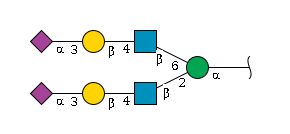
term (main_entry) : 2,6-Branched O-mannose
glycan_dictionary_accession : GSD000001
glytoucan_accession : G06953DR
term_in_sentence : Collectively, these results strongly suggest that GnT-IX may be a novel beta1,6-N-acetylglucosaminyltransferase that is responsible for the formation of the 2,6-branched structure in the brain O-mannosyl glycan.[PMID:14617637]
publication : 14617637|10469154
definition : (2S,4S,5R,6R)-5-Acetamido-2-[(2S,3R,4S,5S,6R)-2-[(2R,3S,4R,5R,6R)-5-acetamido-6-[[(2R,3S,4S,5S,6S)-5-[(2S,3R,4R,5S,6R)-3-acetamido-5-[(2S,3R,4S,5S,6R)-4-[(2S,4S,5R,6R)-5-acetamido-2-carboxy-4-hydroxy-6-[(1R,2R)-1,2,3-trihydroxypropyl]oxan-2-yl]oxy-3,5-dihydroxy-6-(hydroxymethyl)oxan-2-yl]oxy-4-hydroxy-6-(hydroxymethyl)oxan-2-yl]oxy-3,4,6-trihydroxyoxan-2-yl]methoxy]-4-hydroxy-2-(hydroxymethyl)oxan-3-yl]oxy-3,5-dihydroxy-6-(hydroxymethyl)oxan-4-yl]oxy-4-hydroxy-6-[(1R,2R)-1,2,3-trihydroxypropyl]oxane-2-carboxylic acid.[CHEBI:157265]
term_xref : CHEBI:157265|GlycoMotif:GGM.000056|GTC:G06953DR
synonyms : 5-acetamido-3,5-dideoxy-D-glycero-alpha-D-galacto-non-2-ulopyranosylonic acid-(2→3)-beta-D-galacto-hexopyranosyl-(1→4)-2-acetamido-2-deoxy-beta-D-gluco-hexopyranosyl-(1→2)-[5-acetamido-3,5-dideoxy-D-glycero-alpha-D-galacto-non-2-ulopyranosylonic acid-(2→3)-beta-D-galacto-hexopyranosyl-(1→4)-2-acetamido-2-deoxy-beta-D-gluco-hexopyranosyl-(1→6)]-alpha-D-manno-hexopyranose|NeuAc(a2-3)Gal(b1-4)GlcNAc(b1-2)[NeuAc(a2-3)Gal(b1-4)GlcNAc(b1-6)]a-Man
function :
disease_associations :
wikipedia :
essentials_of_glycobiology :
2,6-sialyl-Sulfo-LN
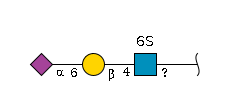
term (main_entry) : 2,6-sialyl-Sulfo-LN
glycan_dictionary_accession : GSD000002
glytoucan_accession : G41145LF
term_in_sentence : The alpha2-6-sialylated 6-sulfo-LacNAc determinant defined by the antibody was significantly expressed on a majority of normal human peripheral B-lymphocytes as well as follicular B-lymphocytes in peripheral lymph nodes.[PMID:17728258]
publication : 17728258
definition :
term_xref : GlycoMotif:GGM.000026|GTC:G41145LF
synonyms : 6-sialyl-6-sulfo LN
function : B-cell interaction with blood vessels and trafficking[PMID: 17728258]
disease_associations :
wikipedia :
essentials_of_glycobiology :
2-Fucosyl-GD1b
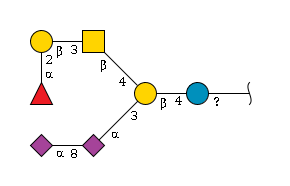
term (main_entry) : 2-Fucosyl-GD1b
glycan_dictionary_accession : GSD000003
glytoucan_accession : G67383AR
term_in_sentence : They were fucosyl-Gv., fucoSyl-GDlb, and two uni que fucogangliosides having GMl or GOlb bas ic structure containing a substituent with the blood group B determinant. [PMID:3654655]
publication : 3654655
definition : (2S,4S,5R,6R)-5-Acetamido-6-[(1S,2R)-2-[(2S,4S,5R,6R)-5-acetamido-2-carboxy-4-hydroxy-6-[(1R,2R)-1,2,3-trihydroxypropyl]oxan-2-yl]oxy-1,3-dihydroxypropyl]-2-[(2R,3S,4R,5R,6S)-3-[(2S,3R,4R,5R,6R)-3-acetamido-4-[(2R,3R,4S,5R,6R)-4,5-dihydroxy-6-(hydroxymethyl)-3-[(2S,3S,4R,5S,6S)-3,4,5-trihydroxy-6-methyloxan-2-yl]oxyoxan-2-yl]oxy-5-hydroxy-6-(hydroxymethyl)oxan-2-yl]oxy-5-hydroxy-2-(hydroxymethyl)-6-[(2R,3S,4R,5R)-4,5,6-trihydroxy-2-(hydroxymethyl)oxan-3-yl]oxyoxan-4-yl]oxy-4-hydroxyoxane-2-carboxylic acid.[CHEBI:156680]
term_xref : CHEBI:156680|GlycoMotif:GGM.000103|GTC:G67383AR
synonyms : 6-deoxy-alpha-L-galacto-hexopyranosyl-(1→2)-beta-D-galacto-hexopyranosyl-(1→3)-2-acetamido-2-deoxy-beta-D-galacto-hexopyranosyl-(1→4)-[5-acetamido-3,5-dideoxy-D-glycero-alpha-D-galacto-non-2-ulopyranosylonic acid-(2→8)-5-acetamido-3,5-dideoxy-D-glycero-alpha-D-galacto-non-2-ulopyranosylonic acid-(2→3)]-beta-D-galacto-hexopyranosyl-(1→4)-D-gluco-hexopyranose|Fuc(a1-2)Gal(b1-3)GalNAc(b1-4)[NeuAc(a2-8)NeuAc(a2-3)]Gal(b1-4)Glc
function :
disease_associations :
wikipedia :
essentials_of_glycobiology :
2-Fucosyl-GM1
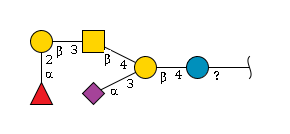
term (main_entry) : 2-Fucosyl-GM1
glycan_dictionary_accession : GSD000004
glytoucan_accession : G56526JU
term_in_sentence : These glycolipid products were identified as asialo-Gs.., GM h and fucosyl-Gq, by comparison with authentic glycolipid samples.[PMID:3654655]
publication : 3654655
definition : (2S,4S,5R,6R)-5-Acetamido-2-[(2R,3S,4R,5R,6S)-3-[(2S,3R,4R,5R,6R)-3-acetamido-4-[(2R,3R,4S,5R,6R)-4,5-dihydroxy-6-(hydroxymethyl)-3-[(2S,3S,4R,5S,6S)-3,4,5-trihydroxy-6-methyloxan-2-yl]oxyoxan-2-yl]oxy-5-hydroxy-6-(hydroxymethyl)oxan-2-yl]oxy-5-hydroxy-2-(hydroxymethyl)-6-[(2R,3S,4R,5R)-4,5,6-trihydroxy-2-(hydroxymethyl)oxan-3-yl]oxyoxan-4-yl]oxy-4-hydroxy-6-[(1R,2R)-1,2,3-trihydroxypropyl]oxane-2-carboxylic acid.[CHEBI:151476]
term_xref : KEGG:G12241|CHEBI:151476|CID:91849786|GlycoMotif:GGM.000101|GTC:G56526JU
synonyms : Fuc(a1-2)Gal(b1-3)GalNAc(b1-4)[NeuAc(a2-3)]Gal(b1-4)Glc|6-deoxy-alpha-L-galacto-hexopyranosyl-(1→2)-beta-D-galacto-hexopyranosyl-(1→3)-2-acetamido-2-deoxy-beta-D-galacto-hexopyranosyl-(1→4)-[5-acetamido-3,5-dideoxy-D-glycero-alpha-D-galacto-non-2-ulopyranosylonic acid-(2→3)]-beta-D-galacto-hexopyranosyl-(1→4)-D-gluco-hexopyranose
function :
disease_associations :
wikipedia :
essentials_of_glycobiology :
3-Sialyl-LN (type 2)

term (main_entry) : 3-Sialyl-LN (type 2)
glycan_dictionary_accession : GSD000005
glytoucan_accession : G10203DW
term_in_sentence : Using new crystal structures, we also provide the atomic resolution basis for the differential recognition of 3′ and 6′SiaLacNAc1–4 (with the Galβ1–4 linkage known as Type 2 backbone16; Scheme 1) by TgMIC1-MARR, and make comparisons with the Type 1 chain isomer of 3′SiaLacNAc1–4 (designated 3′SiaLacNAc1–3).[PMID:19593815]
publication : 19593815|15659615|2414279|8586620|2111348|23747419
definition : A linear amino trisaccharide consisting of α-neuraminyl, β-D-galactosyl and N-acetyl-D-glucosamine residues linked in a (2→3) and (1→4) sequence.[CHEBI:52472]
term_xref : GTC:G10203DW|KEGG:G00253|SugarBind_Ligand:109|GlycoEpitope:EP0314|CHEBI:52472|GlycoMotif:GGM.000034
synonyms :
function :
disease_associations : Chronic gastritis[SugarBind_Ligand:109]|Toxoplasmosis[SugarBind_Ligand:109]|Peptic ulcers[SugarBind_Ligand:109]|Gastric cancer[SugarBind_Ligand:109]
wikipedia :
essentials_of_glycobiology :
3'-Sulfo-Lewis a
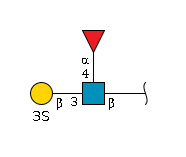
term (main_entry) : 3'-Sulfo-Lewis a
glycan_dictionary_accession : GSD000006
glytoucan_accession : G78706CK
term_in_sentence : A remodeling system of the 3'-sulfo-Lewis a and 3'-sulfo-Lewis x epitopes.[PMID:11504739]
publication : 11504739|17499486|17691854|12944557|19394320|7534477|11604107|28025252|9061363|9878545|11918697|24239607|28628803|25339106|21400496|17998215|12626387|11425799|12219077|10955596|9453593
definition : A branched amino trisaccharide consisting of N-acetylglucosamine having a fucosyl residue attached at the 4-position via an α-linkage and a 3-sulfated galactosyl residue attached at the 3-position via a β-linkage.[CHEBI:65149]
term_xref : GTC:G78706CK|GlycoEpitope:EP0009|CID:5289352|GlycoMotif:GGM.000030
synonyms : 3'-Sulfo-Lea|SuLe(a)|3'-sulpho-Le(a)|3-O-sulfo-Le(A)|3'-Sulfo Le^a|3'-Sulfo Lea|3'-Sulfo Lewis a
function : SO3-3-Gal and the SO3-3-Lea blood group antigen bound to H.pylori.[GlycoEpitope:EP0009]
disease_associations :
wikipedia :
essentials_of_glycobiology :
3'-Sulfo-Lewis x
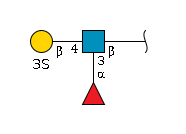
term (main_entry) : 3'-Sulfo-Lewis x
glycan_dictionary_accession : GSD000007
glytoucan_accession : G12295TB
term_in_sentence : A remodeling system of the 3'-sulfo-Lewis a and 3'-sulfo-Lewis x epitopes.[PMID:11504739]
publication : 11504739|20695481|8688428|10536036|12770775|11352731|9784103|9022803
definition : An amino trisaccharide that consists of N-acetyl-β-D-glucosamine having an α-L-fucosyl residue attached at position 3 and a 3-sulfated β-D-galactosyl residue attached at position 4; β-D-Galp3S-(1→4)-[α-L-Fucp-(1→3)]-D-GlcpNAc in which the configuration at the anomeric centre of the reducing-end residue is β. [CHEBI:65171]
term_xref : GTC:G12295TB|GlycoEpitope:EP0013|CID:5289353|CHEBI:65171|GlycoMotif:GGM.000029
synonyms : 3'-sulfo-Le(x)|3'-Sulfo Lewis x|3'-sulfo Le^x|3'-sulfo Lex
function :
disease_associations :
wikipedia :
essentials_of_glycobiology :
6,6'-bisSulfo-Lewis x
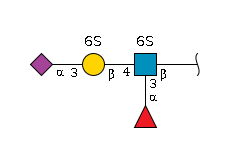
term (main_entry) : 6,6'-bisSulfo-Lewis x
glycan_dictionary_accession : GSD000008
glytoucan_accession : G00659GQ
term_in_sentence : Comparison of the reactivity pattern of HEV with the reactivity of the pure 6-sulfo, 6'-sulfo, or 6,6'-bissulfo sialyl Lewis X determinant with hitherto known anti-sialyl Lewis X antibodies strongly suggested 6-sulfo sialyl Lewis X to be the best candidate for the major sulfated sialyl Lewis X determinant on HEV, followed by 6,6'-bissulfo sialyl Lewis X, whereas 6'-sulfo sialyl Lewis X was unlikely. [PMID:9556613]
publication : 19756298|14593101|15175329|14568956|12163379|11919403|11520459|10728707|10200296|10528213|9712885|9556613|9456330|9556613|9257857|9164959|9015359|8958810|7560094|7485559|7538131|8161542|7684905
definition : (2S,4S,5R,6R)-5-Acetamido-2-[(2S,3R,4S,5S,6R)-2-[(2R,3S,4R,5R,6R)-5-acetamido-6-hydroxy-2-(sulfooxymethyl)-4-[(2S,3S,4R,5S,6S)-3,4,5-trihydroxy-6-methyloxan-2-yl]oxyoxan-3-yl]oxy-3,5-dihydroxy-6-(sulfooxymethyl)oxan-4-yl]oxy-4-hydroxy-6-[(1R,2R)-1,2,3-trihydroxypropyl]oxane-2-carboxylic acid.[CHEBI:146095]
term_xref : GlycoEpitope:EP0016|CHEBI:146095|GlycoMotif:GGM.000028|GTC:G00659GQ
synonyms : 6,6'-DiSulfo Sialyl Lewis x|6,6-bisSulfo-Lewis x (6,60-bissulfo Lewis x )|6,6'- Disulfo Sialyl Lewis x|6,6'-bisSulfo-Lewis x|6,6'-bissulfo Lex|6,6'-Disulfo Sialyl Lewis x|6,6'-bissulfo Le^x
function : lymphocyte homing[GlycoEpitope:EP0016]
disease_associations :
wikipedia :
essentials_of_glycobiology :
6-Sialyl-GalNAc

term (main_entry) : 6-Sialyl-GalNAc
glycan_dictionary_accession : GSD000009
glytoucan_accession : G08371CD
term_in_sentence : mmunohistochemical distributions of carbohydrate antigens based on the type 2 chain in normal as well as fetal and neoplastic tissues of human gastrointestinal tract were investigated with a monoclonal antibody (MAb) H11 (specific for type 2 chain) alone and in combination with the two MAbs MSG15 (for alpha 2----6 sialylated type 2 chain) and IB9 (for the alpha 2----6 sialylated type 2 chain and glycoproteins having NeuAc alpha 2----6Gal-NAc), and 188C1 (for short- and long-chain Lex antigens) and FH2 (for the long-chain Lex antigen). [PMID: 1618643]
publication : 1618643|6194157
definition : An amino disaccharide composed of N-acetylneuraminic acid and 2-(acetylamino)-2-deoxy-D-galactopyranose residues joined by an (α-2→6) glycosidic bond.[CHEBI:146820]
term_xref : GlycoEpitope:EP0352|KEGG:G00455|KEGG:G10625|CHEBI:146820|CID:11409652|GlycoMotif:GGM.000035|GTC:G08371CD
synonyms : Sialyl Tn antigen|6-Sialyl-GalNAc|6-Sialyl LN|6-Sialyl LN (type 1)|6-Sialyl LN (type 2)
function :
disease_associations :
wikipedia :
essentials_of_glycobiology :
6-Sulfo LacNac
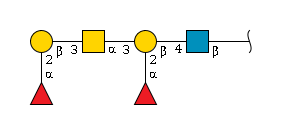
term (main_entry) : 6-Sulfo LacNac
glycan_dictionary_accession : GSD000010
glytoucan_accession : G13157WZ
term_in_sentence : In the search for an additional marker to better dissect the two subsets we have explored the marker 6-sulfo LacNAc (slan).[PMID:31572354]
publication : 31572354|31191513|29977237|29900053|30984181|28732748|26510404|28769928|31154896|27541644|25262889|26155414|28499587|27086951|27315572|26162403|26391152|31730025|12354382|27318477|23879812|25340085|24682513|21377044|21098395|18942710|23559493|23890755|22643330|23460612|23402811|22890025|19589615|32939325|20210806|17616642|22907335|16782032|22188261|21283706|29875315|32413173|19546436|19384158|1429720|30519676
definition : An oligosaccharide sulfate that is N-acetyllactosamine in which the hydroxy group at position 6 of the N-acetylglucosamine ring has been converted into its hydrogen sulfate derivative.[CHEBI:148005]
term_xref : GlycoEpitope:EP0141|GTC:G13157WZ|CID:10322152|CHEBI:148005
synonyms : 6-Sulfo LacNAc
function :
disease_associations :
wikipedia :
essentials_of_glycobiology :
6-Sulfo Sialyl Lewis x
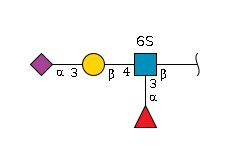
term (main_entry) : 6-Sulfo Sialyl Lewis x
glycan_dictionary_accession : GSD000188
glytoucan_accession : G80722US
term_in_sentence : The cognate ligands for L-selectin possess the unusual sulfated tetrasaccharide epitope 6-sulfo sialyl Lewis x (Siaalpha2-->3Galbeta1-->4[Fucalpha1-->3][SO(3)-->6]GlcNAc).[PMID:11331001]
publication : 11331001|2288521|26137907|9400621|9556613|15972893|9015359|22691873|18652681|9722682|10435581|19359410|15228275|18250165|10536036|17944600|10460836|27993973|19149511|19150806|17172261|17142960|27956273|7578028|22260995|24519996|21596021|21982762|21775439|17334369|9710564|14593101|16227985|11895802|22750968|15157883|19067429
definition :
term_xref : GlycoMotif:GGM.000027|GlycoEpitope:EP0015|CID:70698321|CHEBI:71628
synonyms : 6-sulfo SLex|6-Sulfo-sialyl Lewis x|6-sulfo SLe^x
function : lymphocyte homing[GlycoEpitope:EP0015]
disease_associations :
wikipedia :
essentials_of_glycobiology : Chapter 34|Chapter 35
6'-Sulfo Sialyl Lewis x
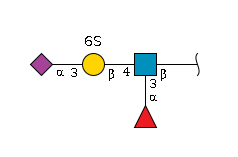
term (main_entry) : 6'-Sulfo Sialyl Lewis x
glycan_dictionary_accession : GSD000011
glytoucan_accession : G00672PE
term_in_sentence : Studies using sulfotransferase-deficient mice showed that 6-sulfo sialyl Lewis X (6-sulfo sLe(x)), a major ligand for L-selectin that is expressed on the high endothelial venules (HEVs), plays critical roles in lymphocyte homing to the peripheral lymph nodes.[PMID:2288521]
publication : 2288521|26137907|9400621|32744401|9556613|15972893|9015359|22691873|18652681|9722682|10435581|19458105|19359410|15228275|18250165|10536036|17944600|10460836|27993973|19149511|19150806|17172261|17142960|27956273|7578028|22260995|24519996|21596021|21982762|21775439|17334369|9710564|14593101|16227985|11895802|22750968|15157883|19067429
definition : A branched amino tetrasaccharide comprised of a trisaccharide chain of N-acetyl-α-neuraminic acid, 6-O-sulfo-β-D-glactose and N-acetyl-β-D-glucosamine residues linked sequentially (2→3) and (1→4), to the GlcNAC residue of which is also linked (1→3) an α-L-fucose residue.[CHEBI:71558]
term_xref : GlycoMotif:GGM.000025|GTC:G00672PE|CID:70698387|GlycoEpitope:EP0014|CHEBI:71558|SugarBind_Ligand:128
synonyms : 6'-sulfated sialyl Lewis x-|6'-sulfo-sLe(x)|Su-SaiLex|Su-Slex|6'-Sulfo-sialyl Lewis x
function : lymphocyte homing[GlycoEpitope:EP0014]
disease_associations : Influenza[SugarBind_Ligand:128]
wikipedia :
essentials_of_glycobiology : Chapter 14
9-O-Acetyl GD3
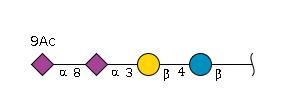
term (main_entry) : 9-O-Acetyl GD3
glycan_dictionary_accession : GSD000012
glytoucan_accession : G74121RX
term_in_sentence : To determine whether 9-O-acetyl GD3 (acGD3) has a general antiapoptotic potential, the apoptosis-sensitive Jurkat cell line and an apoptosis-sensitive variant of the cell line Molt-4 were preincubated with micromolar concentrations of acGD3 and then treated with inducers of apoptosis.[PMID:16432837]
publication : 16432837|21507905|17512674|21930212|18194438|20739294|3216430|14724245|31373393|7558412|11273644|17385751|30694652|22894715|12973826|7859075|9749956|9874495|12486096|1989525|25330147|23478187|21807667|8486686|11465673|9511990|29270199|9268945|25045067|21618115|16434401|12493756|2302705|2198284|2685488|9328574|4055789|10096568|1644805|2582447
definition :
term_xref : GTC:G74121RX|GlycoEpitope:EP0064|CID:91852520|GlycoMotif:GGM.000093
synonyms : acGD3|9-O-Acetylated GD3|9-O-Acetyl-GD3|9-O-Ac-GD3|CD60b
function :
disease_associations : pancreas cancer[GlycoEpitope:EP0064]
wikipedia :
essentials_of_glycobiology :
9-O-Acetyl sialic acid
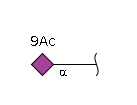
term (main_entry) : 9-O-Acetyl sialic acid
glycan_dictionary_accession : GSD000013
glytoucan_accession : G47325QT
term_in_sentence : Levels of 9-O-acetyl sialic acid provide a distinct way to define progenitors and thus facilitate the study of hematopoietic differentiation.[PMID:31411667]
publication : 31411667|27936566|2509478|10049046|1826463
definition : N-acetyl-9-O-acetyl-alpha-neuraminic acid is a member of the class of N-acetylneuraminic acids that is alpha-neuraminic acid which has acetylated on N-5 and O-9. It has functional parent alpha-neuraminic acid.[CHEBI:84941]
term_xref : GTC:G47325QT|GlycoEpitope:EP0065|CID:13991612|CHEBI:84941
synonyms :
function :
disease_associations :
wikipedia :
essentials_of_glycobiology : Chapter 15
Alpha-gal antigen

term (main_entry) : Alpha-gal antigen
glycan_dictionary_accession : GSD000016
glytoucan_accession : G24432YB
term_in_sentence : Therefore, alpha-gal antigen might be eliminated after a prolonged culture, when using human cells.[PMID:31267683]
publication : 31267683|29319188|29481481|26140655|30337555|29235434|22909134|28280265|7532618|23390540|22808845|29898796|22262104|31267683|25430953|22993330|23578170|21043478|28294277|27696820|15814276|17991149|25577211|30578545|19895316|28068870|18546155|32907757|26485996|9771839|12042247|27567275|12131678|23114154|19184002|29577591|29806570|15638815|21118731
definition : A glycosylgalactose that consists of β-D-galactose having an α-D-galactosyl residue at the 3-position.[CHEBI:62330]
term_xref : GTC:G24432YB|GlycoMotif:GGM.000015|CID:52939789|CHEBI:62330
synonyms : a-Gal antigen
function : Has role as a carbohydrate allergen, epitope or an antigen.[CHEBI:62330]
disease_associations :
wikipedia :
essentials_of_glycobiology : Chapter 14
Alpha-galactosylceramide
term (main_entry) : Alpha-galactosylceramide
glycan_dictionary_accession : GSD000017
glytoucan_accession :
term_in_sentence : From 24 weeks of age, NZB/NZW F1 mice were injected with alpha-galactosylceramide (α-GalCer) or vehicle once a week for four weeks.[PMID:29844470]
publication : 29844470|30421497|31575643|30745361|30953000|30556652|29617191|31689579|28872688|30195979|29940370|27004737|27198610|28743554|31649670|31484693|25752588|21383248|25527277|30821985|28947140|31244823|29311431|30803854|29576533|26101952|31213291|22412194|28067024|31199716|27354638|24465013|25445911|28120096|15630427|27803187|21392534|31075434|22683545|26191196|26811064|23935988|28623127|24913977|25434827|23420533|21839133|25314062|27325450|23874157
definition :
term_xref :
synonyms : alpha-GalCer|alpha-GalCers|α-GalCer
function :
disease_associations :
wikipedia :
essentials_of_glycobiology :
Asialo-biantennary
term (main_entry) : Asialo-biantennary
glycan_dictionary_accession : GSD000018
glytoucan_accession :
term_in_sentence : Typical crystallizable fragment (Fc) glycans attached to the CH2 domain in therapeutic monoclonal antibodies (mAbs) are core-fucosylated and asialo-biantennary complex-type glycans, e.g., G2F (full galactosylation), G1aF (terminal galactosylation on the Man α1-6 arm), G1bF (terminal galactosylation on the Man α1-3 arm), and G0F (non-galactosylation).[PMID:30990348]
publication : 30990348|17645671|20959391|18615430|16945378|2065054|3084472|2386787|22911097|24692304|17013932|7513972|6626573|10835250|9684342
definition :
term_xref :
synonyms : asialo diantennary
function :
disease_associations :
wikipedia :
essentials_of_glycobiology :
Asialo-GM1

term (main_entry) : Asialo-GM1
glycan_dictionary_accession : GSD000019
glytoucan_accession : G21856LC
term_in_sentence : We compared the lateral structure of giant unilamellar vesicles (GUVs) composed of three pseudo binary mixtures of different glycosphingolipid (GSL), i.e. sulfatide, asialo-GM1 or GM1, with POPC.[PMID:29106974]
publication : 29106974|3418980|26975993|8613364|9288228|26710925|24922516|6839313|1828259|2581667|8210226|25062498|9671150|10377092|6171919|3093429|6652964|3124753|8905612|18788941|1467432|8225593|2083955|6171918|7806377|1802483|7927723|9209156|21174147|2584393|12137200|6175621|2936802|8610366|21490162|1548508|3486908|26453755|7910939|3756909|1639356|3259967|2443562|3112077|2572647|25137483|2168971|6950172
definition :
term_xref : GlycoMotif:GGM.000099|GTC:G21856LC|CID:10169040|GlycoEpitope:EP0047|CHEBI:59216
synonyms : as-GM1|GA-1|Gangliotetraosylceramide|GgO4|Gg4|Asialo-GM1a|ganglio-N-tetraosylceramide
function :
disease_associations : Pleuropneumonia[SugarBind_Ligand:2]|Porcine fibrinohemorrhagic necrotizing pleuropneumonia[SugarBind_Ligand:2]|Actinomycosis[SugarBind_Ligand:2]|Lazy leukocyte syndrome[SugarBind_Ligand:2]|Pertussis[SugarBind_Ligand:2]|Cutaneous lesions[SugarBind_Ligand:2]|Melioidosis[SugarBind_Ligand:2]|Candidiasis[SugarBind_Ligand:2]|Taiwan acute respiratory agent[SugarBind_Ligand:2]|Trachoma[SugarBind_Ligand:2]|Cystitis[SugarBind_Ligand:2]|Chronic gastritis[SugarBind_Ligand:2]|Peptic ulcers[SugarBind_Ligand:2]|Gastric cancer[SugarBind_Ligand:2]|Klebsiella pneumonia infection[SugarBind_Ligand:2]|Pneumonia[SugarBind_Ligand:2]|Legionnaires' disease[SugarBind_Ligand:2]|Gonorrhea[SugarBind_Ligand:2]|Gastroenteritis[SugarBind_Ligand:2]|Toxoplasmosis[SugarBind_Ligand:2]|Plague[SugarBind_Ligand:2]|Diarrhea[SugarBind_Ligand:2]
wikipedia :
essentials_of_glycobiology :
B-GD1B

term (main_entry) : B-GD1B
glycan_dictionary_accession : GSD000020
glytoucan_accession : G72557NR
term_in_sentence : The Molecular Modelling and 10 ns MD simulation of Botulinum Neuro Toxin/B-GD1A and BoNT/B-GD1B complex revealed that this toxin can interact with GD1A in the single binding mode and with GD1B in two binding modes.[PMID:22929125]
publication : 27956354|22929125
definition :
term_xref : GlycoMotif:GGM.000104|GTC:G72557NR|CID:91847819|KEGG:G01803|CHEBI:153361
synonyms : B-GD1b
function :
disease_associations :
wikipedia :
essentials_of_glycobiology :
B-GM1
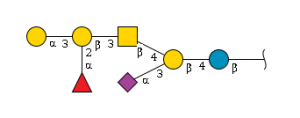
term (main_entry) : B-GM1
glycan_dictionary_accession : GSD000021
glytoucan_accession : G11485ID
term_in_sentence : The contribution of GM3 and GD3, which accounted for 95% of the ganglioside sialic acid at birth, decreased during the first 3 weeks of life. GM1, fucosyl-GM1, and B-GM1 were not detected at birth. [PMID: 3680254]
publication : 3680254
definition : (2S,4S,5R,6R)-5-Acetamido-2-[(2R,3S,4R,5R,6S)-3-[(2S,3R,4R,5R,6R)-3-acetamido-5-hydroxy-4-[(2R,3R,4S,5S,6R)-5-hydroxy-6-(hydroxymethyl)-4-[(2R,3R,4S,5R,6R)-3,4,5-trihydroxy-6-(hydroxymethyl)oxan-2-yl]oxy-3-[(2S,3S,4R,5S,6S)-3,4,5-trihydroxy-6-methyloxan-2-yl]oxyoxan-2-yl]oxy-6-(hydroxymethyl)oxan-2-yl]oxy-5-hydroxy-2-(hydroxymethyl)-6-[(2R,3S,4R,5R,6R)-4,5,6-trihydroxy-2-(hydroxymethyl)oxan-3-yl]oxyoxan-4-yl]oxy-4-hydroxy-6-[(1R,2R)-1,2,3-trihydroxypropyl]oxane-2-carboxylic acid is a member of neuraminic acids.[CHEBI:147588]
term_xref : GlycoMotif:GGM.000102|GTC:G11485ID|CID:91853157|CHEBI:147588|SugarBind_Ligand:181
synonyms :
function :
disease_associations : Cholera[SugarBind_Ligand:181]
wikipedia :
essentials_of_glycobiology : Chapter 37
Biantennary
term (main_entry) : Biantennary
glycan_dictionary_accession : GSD000022
glytoucan_accession :
term_in_sentence : We found an efficient isopropylidenation reaction that selectively protects the terminal Gal-3,4-OH of a biantennary complex-type nonasaccharide isolated from a natural source.[PMID:29249147]
publication : 29249147|24991291|29409839|30325416|18083109|26926155|16715395|12634321|24211369|23115267|31907993|23360551|20861009|33142198|11442281|18687680|15680603|31888963|14686925|15819890|22530754|22098756|9346821|19341309|18529007|20580347|11784152|7773775|10913832|8547276|10463590|9404657|30525457|15316280|8068637|3881425|6425277|8576139|29956878|1576211|11129583|30421263|8069634|30973186|16704415|21612260|29806066|29443078
definition : Type of N-linked glycan in which two antenna are present on the trimannosyl core, each initiated by GlcNAc additions catalyzed by position-specific N-acetylglucosaminyltransferases (GlcNAcTs). Each antenna can be exteneded or capped with HexNAc, deoxyHex, Hex, or sialic acid residues. [Essentials of Glycobiology:Glossary]
term_xref :
synonyms : diantennary
function :
disease_associations :
wikipedia :
essentials_of_glycobiology : Chapter 9
Biantennary complex
term (main_entry) : Biantennary complex
glycan_dictionary_accession : GSD000023
glytoucan_accession :
term_in_sentence : The crystal structure of Pterocarpus angolensis lectin is determined in its ligand-free state, in complex with the fucosylated biantennary complex type decasaccharide NA2F, and in complex with a series of smaller oligosaccharide constituents of NA2F.[PMID:16704415]
publication : 16704415|3731182|26747427|32597008|6626573|29249147|28597152|25045879|30325416|12634321|31888963|26926155|23360551|33142198|9404657|29956878|14686925|18687680|11784152|7773775|22530754|20580347|22098756|21612260|6425277|7691595|26780731|16285669|15819890|3924097|30448401|8547276|17049014|29408873
definition : A complex N-glycan that has two branches attached to the non-reducing terminal Man residues of the trimannosyl core. . Each branch is initiated with a GlcNAc and can be exteneded or capped with HexNAc, deoxyHex, Hex, or sialic acid residues. [CHEBI:156251]
term_xref : CHEBI:156251
synonyms : diantennary complex type
function :
disease_associations :
wikipedia :
essentials_of_glycobiology :
Bisecting GlcNac
term (main_entry) : Bisecting GlcNac
glycan_dictionary_accession : GSD000024
glytoucan_accession :
term_in_sentence : The presence of a bisecting GlcNAc and the occurrence of alpha 2-6-linked Neu5Ac in the most abundant N-glycans, are new features for hCG-beta.[PMID:1374031]
publication : 1374031|29909448|29274553|32719771|22476631|31375533|26467158|27429195|20816221|26109616|30542567|30144245|25727145|29593568|32612952|9006930|19508951|16000695|32597008|19053837|22530754|30405631|19940114|32719549|9560299|29655002|10589784|29959030|20661133|9061364|31065629|20395209|29549127|30305426|29632412|24108122|24282611|27821068|14686925|10816579|25032906|30025558|9661906|8542600|31585439|29699572|27443163|30315103|23808883|18812317|19776078
definition : The bisecting GlcNAc is a modification of hybrid or complex N-linked glycans in which a single GlcNAc is added to the 3 position of the b-linked Man found in the trimannosyl core structure. The modification is catalyzed by beta 1,4-N-acetylglucosaminyltransferase III (GlcNAcT-III) or MGAT3 (E.C. 2.4.1.144). The addition of a bisecting GlcNAc on a hybrid or trimmed hybrid glycan prevents the subsequent action of N-glycan branching glycosyltransferases GlcNAcT-IV and GlcNAcT-V, but GlcNAcT3 can add a bisecting GlcNAc to the products of these enzymes. [PMID: 22476631]
term_xref : SID:163312364|KEGG:G13066
synonyms :
function : The bisecting GlcNAc of N-glycans regulates cellular signaling and tumor progression through modulating N-glycan/galectin interactions.[PMID: 22476631]Inhibits growth factor signaling and retards mammary tumor progression[PMID: 20395209]Integrin-mediated cell adhesion [PMID: 20816221]Important in fertilization and fetal development, neuritogenesis, immune tolerance, immunoglobulin G (IgG)[PMID: 32719771]
disease_associations : mammary tumor.[PMID: 20395209]
wikipedia :
essentials_of_glycobiology : Chapter 9
Bisialo-biantennary
term (main_entry) : Bisialo-biantennary
glycan_dictionary_accession : GSD000025
glytoucan_accession :
term_in_sentence : Using anion-exchange liquid chromatography mapping of the oligosaccharide units cleaved from the proteins by glycopeptidase F, compared with elution positions of standard oligosaccharide structures, coupled with monosaccharide compositional analysis, we find that the human plasma protein contained only bisialo-biantennary complex-type carbohydrate and asialo-biantennary complex carbohydrate, confirming earlier work published by this laboratory.
publication : 2386787|2065054
definition : A binantennary glycan with sialic acid residues as non-reducing terminal residues on both antennae.
term_xref :
synonyms : disialo biantennary|disialo diantennary|disialylated biantennary|disialylated diantennary
function :
disease_associations :
wikipedia :
essentials_of_glycobiology :
Bisialo-biantennary complex-type
term (main_entry) : Bisialo-biantennary complex-type
glycan_dictionary_accession : GSD000026
glytoucan_accession :
term_in_sentence : Using anion-exchange liquid chromatography mapping of the oligosaccharide units cleaved from the proteins by glycopeptidase F , compared with elution positions of standard oligosaccharide structures , coupled with monosaccharide compositional analysis, we find that the human plasma protein contained only bisialo-biantennary complex-type carbohydrate and asialo-biantennary complex carbohydrate , confirming earlier work published by this laboratory.[PMID:2386787]
publication : 2386787|26966183
definition : A binantennary glycan with sialic acid residues as non-reducing terminal residues on both antennae.
term_xref :
synonyms : Fully sialylated biantennary N-glycan
function :
disease_associations :
wikipedia :
essentials_of_glycobiology : Chapter 25
Blood group A trisaccharide
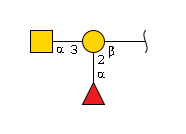
term (main_entry) : Blood group A trisaccharide
glycan_dictionary_accession : GSD000029
glytoucan_accession : G00066MO
term_in_sentence : A readily detectable carbohydrate in the urine of two siblings with neuronal ceroid lipofuscinosis was found to be the blood group A trisaccharide.[PMID:7249368]
publication : 19582848|7249368|8774717|2749874|28771597|30619340|2122121|11886841|2991755|12588002|3149698|7048329|7015594|10359132|8724140|1418679|1446307
definition : A branched amino trisaccharide consisting of β-D-galactose having an α-L-fucosyl residue at the 2-position and an N-acetyl-α-D-galactosaminyl residue at the 3-position.[CHEBI:61012]
term_xref : GlycoEpitope:EP0255|GTC:G00066MO|CID:49852448|KEGG:G10638|CHEBI:61012
synonyms : blood group A trisaccharide|blood group A type 1 trisaccharide
function :
disease_associations :
wikipedia :
essentials_of_glycobiology :
Blood group A (Type 1)
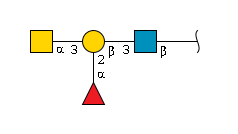
term (main_entry) : Blood group A (Type 1)
glycan_dictionary_accession : GSD000030
glytoucan_accession : G66163TI
term_in_sentence : he basis of blood group A(1) and A(2) phenotypes has been debated for many decades, and still the chemical basis is unresolved. [PMID:19121199]
publication : 10942408|19121199
definition : An α-D-GalpNAc-(1→3)-[α-L-Fucp-(1→2)]-β-D-Galp-(1→3)-D-GlcpNAc having β-configuration at the reducing end anomeric centre.[CHEBI:62485]
term_xref : GlycoMotif:GGM.000044|GTC:G66163TI|GlycoEpitope:EP0256|CID:53262359|CHEBI:62485
synonyms : Blood group A(1)|blood group A antigen type 1
function :
disease_associations :
wikipedia :
essentials_of_glycobiology :
Blood group A (Type 1) - Lewis b
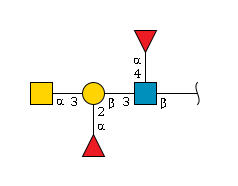
term (main_entry) : Blood group A (Type 1) - Lewis b
glycan_dictionary_accession : GSD000190
glytoucan_accession : G97501MA
term_in_sentence : Ten monoclonal antibodies and one lectin were used to study the localization and distribution of Blood Group ABH, type 1 chain (Lewis a, Lewis b) and type 2 chain (H-2, Y) antigens in 22 cases of normal uterine cervix, with known ABO and Lewis phenotype and secretor status.[PMID:2247887]
publication : 2247887|19756298|4041428|5686860
definition : A branched amino pentasaccharide consisting of the linear trisaccharide N-acetyl-α-D-galactosaminyl-(1→3)-β-D-galactosyl-(1→3)-N-acetyl-β-D-glucosamine having α-L-fucosyl residues attached at position 2 of the galactose and position 4 of the glucosamine. Corresponds to a partial structure of blood group A type 1 oligosaccharide.[CHEBI:62988]
term_xref : GlycoMotif:GGM.000047|CID:53477630|CHEBI:62988|GlycoEpitope:EP0260
synonyms : Blood Group A Type 1 (difucosyl)|ALe^b|A-Leb|A-Le^b|A Lewis b
function :
disease_associations :
wikipedia :
essentials_of_glycobiology :
Blood group A (Type 2)
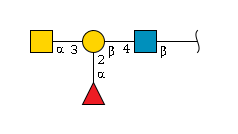
term (main_entry) : Blood group A (Type 2)
glycan_dictionary_accession : GSD000014
glytoucan_accession : G74353FF
term_in_sentence : One hybridoma antibody (AH16), obtained on immunization with human gastric cancer cell MKN45, was directed to the blood group A determinant carried by both type 1 and type 2 chains. [PMID:6583282]
publication : 27196314|6583282|8340255|18701592|21901093|2413709|8036794|1615929|3285099
definition : A branched amino tetrasaccharide comprising N-acetyl-β-D-glucosamine at the reducing end with a N-acetyl-α-D-galactosaminyl-(1→3)-[α-L-fucosyl-(1→2)]-β-D-galactosyl moiety attached at the 4-position.[CHEBI:62486]
term_xref : GTC:G74353FF|CID:53262376|GlycoEpitope:EP0257|CHEBI:62486|GlycoMotif:GGM.000038
synonyms : A Type 2|Blood group A type 2 chain
function :
disease_associations :
wikipedia :
essentials_of_glycobiology : Chapter 14
Blood group A (Type 2) - Lewis y
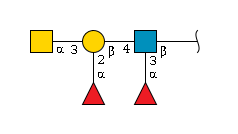
term (main_entry) : Blood group A (Type 2) - Lewis y
glycan_dictionary_accession : GSD000027
glytoucan_accession : G54826OZ
term_in_sentence : Monoclonal antibodies defining blood group A variants with difucosyl type 1 chain (ALeb) and difucosyl type 2 chain (ALey).[PMID:2417620]
publication : 2417620
definition : A branched amino pentasaccharide consisting of the linear trisaccharide N-acetyl-α-D-galactosaminyl-(1→3)-β-D-galactosyl-(1→4)-N-acetyl-β-D-glucosamine having α-L-fucosyl residues attached at position 2 of the galactose and position 3 of the glucosamine. Corresponds to a partial structure of blood group A type 2 oligosaccharide.[CHEBI:62990]
term_xref : GlycoEpitope:EP0261|GTC:G54826OZ|CHEBI:62990|CID:5289011|GlycoMotif:GGM.000039
synonyms : Blood group A (type 2) (A-Ley)|Blood Group A Type 2 (difucosyl)|Blood group A (type 2) (A-Lewis Y)|A-Ley|A-Le^y
function :
disease_associations :
wikipedia :
essentials_of_glycobiology :
Blood group A (Type 3)
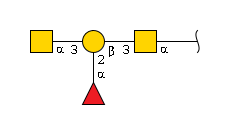
term (main_entry) : Blood group A (Type 3)
glycan_dictionary_accession : GSD000187
glytoucan_accession : G99315PE
term_in_sentence :
publication : 7800218|17998569|19756298|3191504
definition :
term_xref : GlycoMotif:GGM.000011|GTC:G99315PE
synonyms : A type 3 antigen|blood group A type 3|A antigen (type 3)
function :
disease_associations :
wikipedia :
essentials_of_glycobiology : Chapter 14
Blood group A (Type 4)
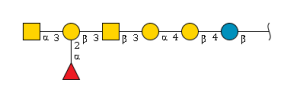
term (main_entry) : Blood group A (Type 4)
glycan_dictionary_accession : GSD000028
glytoucan_accession : G37830TX
term_in_sentence : Moreover, we have found that αGal, but not αGalNAc, is a weak binder itself for DC-SIGN, which could endow an additional binding mode for the blood group B antigen, but not for blood group A.[PMID:31283166]
publication : 7800218|7521740|2458640|31283166
definition :
term_xref : GlycoMotif:GGM.000088|GTC:G37830TX|CID:91852258|KEGG:G00474|CHEBI:150159|SugarBind_Ligand:48
synonyms :
function :
disease_associations : Pyelonephritis[SugarBind_Ligand:48]|Acute cystitis[SugarBind_Ligand:48]
wikipedia :
essentials_of_glycobiology :
Blood group A1 (Type 3)
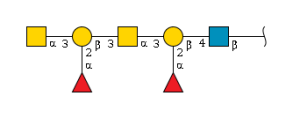
term (main_entry) : Blood group A1 (Type 3)
glycan_dictionary_accession : GSD000031
glytoucan_accession : G44060QH
term_in_sentence : The structure is essentially a repetitive A epitope attached to type 2 chain and is hereby called type 3 chain A. [PMID:2579390]
publication : 2579390|19756298
definition : A branched amino heptasaccharide made up from two repeating (1→3)-linked N-acetyl-α-D-galactosaminyl-(1→3)-[α-L-fucosyl-(1→2)]-β-D-galactosyl units that are in turn joined to an N-acetyl-β-D-glucosamine residue via a (1→4)-linkage.[CHEBI:85665]
term_xref : GTC:G44060QH|CHEBI:85665|CID:91825676|GlycoMotif:GGM.000040
synonyms : Blood group A1 (type 3)|Blood Group A1
function :
disease_associations :
wikipedia :
essentials_of_glycobiology :
Blood group A2 (A-associated H type 3)

term (main_entry) : Blood group A2 (A-associated H type 3)
glycan_dictionary_accession : GSD000032
glytoucan_accession : G62735WZ
term_in_sentence : The H NMR spectrum of the associated H antigen (type 3 chain H) was characterized by the unusual presence of three n-anomeric resonances ('CJ'.~ = 3-4 Hz) in addition to five resonances from @-anomeric protons ("J1:2 = 7-9 Hz).[PMID: 3944091]
publication : 3944091|29000000|28658771
definition : A branched amino hexasaccharide in which an α-L-fucosyl-(1→2)-β-D-galactosyl-(1→3)-N-acetyl-α-D-galactosaminyl-(1→3)-β-D-galactosyl-(1→4)-N-acetyl-β-D-glucosamine linear pentasaccharide carries at the galactose residue proximal to the reducing end a second α-L-fucosyl residue via a (1→2) linkage.[CHEBI:152543]
term_xref : CHEBI:152543|CID:91852328|GlycoMotif:GGM.000041|GTC:G62735WZ
synonyms : Blood Group A2|Fuca1-2Galb1-3GalNAca1-3(Fuca1-2)Galb1-4GlcNAcb|Fuc(a1-2)Gal(b1-3)GalNAc(a1-3)[Fuc(a1-2)]Gal(b1-4)b-GlcNAc|Fucalpha1-2Galbeta1-3GalNAcalpha1-3(Fucalpha1-2)Galbeta1-4GlcNAcbeta|6-deoxy-alpha-L-galacto-hexopyranosyl-(1→2)-beta-D-galacto-hexopyranosyl-(1→3)-2-acetamido-2-deoxy-alpha-D-galacto-hexopyranosyl-(1→3)-[6-deoxy-alpha-L-galacto-hexopyranosyl-(1→2)]-beta-D-galacto-hexopyranosyl-(1→4)-2-acetamido-2-deoxy-beta-D-gluco-hexopyranose|6-deoxy-alpha-L-galactopyranosyl-(1→2)-[6-deoxy-alpha-L-galactopyranosyl-(1→2)-beta-D-galactopyranosyl-(1→3)-2-acetamido-2-deoxy-alpha-D-galactopyranosyl-(1→3)]-beta-D-galactopyranosyl-(1→4)-2-acetamido-2-deoxy-beta-D-glucopyranose
function :
disease_associations :
wikipedia :
essentials_of_glycobiology :
Blood group B (Type 1)
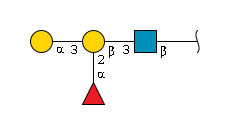
term (main_entry) : Blood group B (Type 1)
glycan_dictionary_accession : GSD000033
glytoucan_accession : G31734OS
term_in_sentence : The minimal binding epitope was identified as the blood group H type 1 determinant (Fucα2Galβ3GlcNAc), while an optimal binding epitope was created by addition of the terminal α3-linked galactose or N-acetylgalactosamine of the blood group B type 1 determinant (Galα3(Fucα2)Galβ3GlcNAc) and the blood group A type 1 determinant (GalNAcα3(Fucα2)-Galβ3GlcNAc). [PMID: 19208633]
publication : 18701592|24749871|19387828|19208633|29562255
definition : α-D-Galp-(1→3)-[α-L-Fucp-(1→2)]-β-D-Galp-(1→3)-β-D-GlcpNAc with β configuration at the anomeric carbon of the GlcNAc residue at the reducing end.[CHEBI:63242]
term_xref : GlycoMotif:GGM.000043|GTC:G31734OS|CID:56927779|CHEBI:63242
synonyms : blood group B type 1 tetrasaccharide
function :
disease_associations :
wikipedia :
essentials_of_glycobiology :
Blood group B (Type 1) - Lewis b
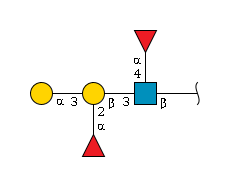
term (main_entry) : Blood group B (Type 1) - Lewis b
glycan_dictionary_accession : GSD000189
glytoucan_accession : G89208KM
term_in_sentence : Ten monoclonal antibodies and one lectin were used to study the localization and distribution of Blood Group ABH, type 1 chain (Lewis a, Lewis b) and type 2 chain (H-2, Y) antigens in 22 cases of normal uterine cervix, with known ABO and Lewis phenotype and secretor status. [PMID:2247887]
publication : 2247887|19756298|30831115
definition :
term_xref : GlycoMotif:GGM.000046
synonyms : Blood Group B, type 1 chain (Lewis b)|B-Leb|B-Le^b
function :
disease_associations :
wikipedia :
essentials_of_glycobiology :
Blood group B (Type 2)
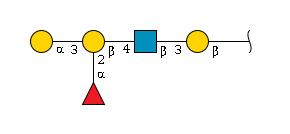
term (main_entry) : Blood group B (Type 2)
glycan_dictionary_accession : GSD000034
glytoucan_accession : G34881WK
term_in_sentence : The detection of a B type 2 determinant is the first chemical evidence for the presence of an autologous difucosyl blood group B type 2 antigen in human adenocarcinoma cells.[PMID:2432062]
publication : 2432062|27196314|18701592
definition :
term_xref : GlycoMotif:GGM.000037|GTC:G34881WK|GlycoEpitope:EP0262
synonyms : blood group B type 2
function :
disease_associations :
wikipedia :
essentials_of_glycobiology :
Blood group B (Type 4)
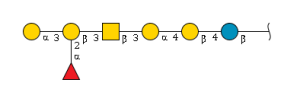
term (main_entry) : Blood group B (Type 4)
glycan_dictionary_accession : GSD000035
glytoucan_accession : G25216QA
term_in_sentence : The blood group B type-4 heptaglycosylceramide is a minor blood group B structure in human B kidneys in contrast to the corresponding A type-4 compound in A kidneys.[PMID:1390942]
publication : 1390942|1841684
definition :
term_xref : GlycoMotif:GGM.000087|GTC:G25216QA
synonyms :
function :
disease_associations :
wikipedia :
essentials_of_glycobiology :
Blood group H (Type 1)
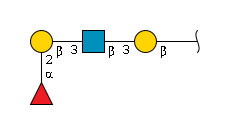
term (main_entry) : Blood group H (Type 1)
glycan_dictionary_accession : GSD000036
glytoucan_accession : G00294TN
term_in_sentence : Blood group H type 1 [Fuc alpha (1,2)Gal beta (1,3)GlcNAc beta-->] is known as the precursor structure of the blood group determinant, Lewis b [Fuc alpha (1,2)Gal beta (1,3)(Fuc alpha (1,4))GlcNAc beta-->].[PMID:7718581]
publication : 7718581|6309836|19208633|27431816|2432062|24219248|6352465|8499478|3348768|3718924
definition :
term_xref : GTC:G00294TN|GlycoMotif:GGM.000042|SugarBind_Ligand:153
synonyms : H type 1
function :
disease_associations : Gastroenteritis[SugarBind_Ligand:153]
wikipedia :
essentials_of_glycobiology :
Blood group H (Type 2)
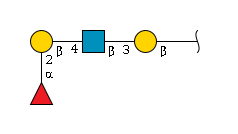
term (main_entry) : Blood group H (Type 2)
glycan_dictionary_accession : GSD000037
glytoucan_accession : G70519XK
term_in_sentence : We have examined the immunohistochemical distribution of H Type 1 and of H Type 2 substances of the ABO blood group system in human submandibular gland using either of the two anti-H monoclonal antibodies MAb 1E3 and MAb 3A5. MAb 3A5 was specific for H Type 2, and MAb 1E3 reacted with each of H Type 1-H Type 4 artificial antigens.[PMID:9405495]
publication : 9405495|8082855|6177241|3944092|21406562|2410664|8731502|6203846|2238560|
definition :
term_xref : GTC:G70519XK|GlycoMotif:GGM.000036
synonyms : Blood group H (type 2)|H type 2|H type 2 chain|H type 2 antigen|type 2 chain H|blood group H type II
function :
disease_associations :
wikipedia :
essentials_of_glycobiology :
Blood group H (Type 2) - Lewis y
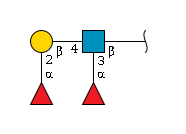
term (main_entry) : Blood group H (Type 2) - Lewis y
glycan_dictionary_accession : GSD000038
glytoucan_accession : G00052MO
term_in_sentence : The fucosylated histo-blood group antigens H type 2 (blood group O, CD173) and Lewis Y (CD174) are expressed on CD34+ hematopoietic progenitors but absent on mature lymphocytes.[PMID: 11479278]
publication : 11479278
definition : A branched amino tetrasaccharide consisting of N-acetyl-β-D-glucosamine at the reducing end having an α-L-fucosyl residue attached at the 3-position and an α-L-fucosyl-(1→2)-β-D-galactosyl moiety attached at the 4-position. A cancer-associated tetrasaccharide antigen which constitutes the core structure recognised by therapeutic antibody BR96. Conformational restriction around the GlcNAc residue is a key feature of its structure.[CHEBI:59045]
term_xref : GTC:G00052MO|GlycoEpitope:EP0018|CID:45266908|CHEBI:59045|GlycoMotif:GGM.000045
synonyms : Lewis y|Blood group H (type 2) (Ley)|Lewis b (Leb)|Lewis a|Lewis b (Lewis b)|Blood group H (type 2) - Lewis y|H-Ley|H-Le^y|Lewis Y|H-Ley|H-Le^y|Lewis Y
function : The expression of the fucosylated histo-blood group antigen CD174 in CD34+ hematopoietic progenitor cells and down-regulation of FUT1 in mature lymphocytes may be important factors influencing the homing process of hematopoietic stem cells to the bone marrow.[GlycoEpitope:EP0018]
disease_associations : AIDS/acquired immune deficiency syndrome[GlycoEpitope:EP0018]|cholangiocarcinoma[GlycoEpitope:EP0018]|hepatocellular carcinoma[GlycoEpitope:EP0018]|Inappropriate tissue distribution of Ley blood-group antigens was observed in CCs(cholangiocarcinomas) and, much less frequently, in HCCs(hepatocellular carcinomas).[GlycoEpitope:EP0018]|Ley determinant is highly expressed in human immunodeficiency virus (HIV)-infected T cell lines and in CD3+ peripheral mature T cells of patients with acquired immune deficiency syndrome (AIDS) or with AIDS-related complex (ARC).[GlycoEpitope:EP0018]
wikipedia :
essentials_of_glycobiology : Chapter 14
Blood group H (Type 3)
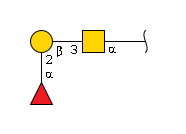
term (main_entry) : Blood group H (Type 3)
glycan_dictionary_accession : GSD000105
glytoucan_accession : G94435QH
term_in_sentence : One particular lambody, VLRB.aGPA.23, was shown by glycan array analysis to be selective for the blood group H type 3 trisaccharide (BG-H3, Fucα1-2Galβ1-3GalNAcα), aGPA, and TFα (Galβ1-3GalNAcα), with affinity constants of 0.2, 1, and 8 nM, respectively.[PMID:23030719]
publication : 23030719|20466654|1563908|3944092|11218748|11101633|18842005|27550195|2469783|2433836|23118206|8445257|2664192|3063304
definition :
term_xref : GlycoMotif:GGM.000010|GTC:G94435QH
synonyms : H type 3|H antigen (type 3)|Type 3 chain H
function :
disease_associations :
wikipedia :
essentials_of_glycobiology : Chapter 11
Blood group H (Type 4)
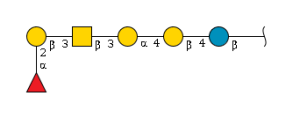
term (main_entry) : Blood group H (Type 4)
glycan_dictionary_accession : GSD000039
glytoucan_accession : G98465JN
term_in_sentence : In addition, the blood group H type 4 chain structure was present together with Le(a) and Le(b) compounds.[PMID:1841684]
publication : 11261842|1841684|11101633|9405495
definition : An amino hexasaccharide consisting of α-L-fucose, β-D-galactose, N-acetyl-α-D-galactosamine, α-D-galactose, β-D-galactose and β-D-glucose residues joined in sequence with (1→2)-, (1→3)-, (1→3)-, (1→4)- and (1→4)-linkages, respectively.[CHEBI:65245]
term_xref : GlycoMotif:GGM.000086|GTC:G98465JN|CID:10260428|SugarBind_Ligand:61|CHEBI:65245
synonyms :
function :
disease_associations : Pyelonephritis[SugarBind_Ligand:61]
wikipedia :
essentials_of_glycobiology :
C2-O-sLex
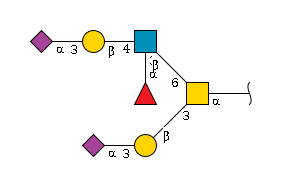
term (main_entry) : C2-O-sLex
glycan_dictionary_accession : GSD000040
glytoucan_accession : G97345NY
term_in_sentence : PSGL-1 lacks 6-sulfo-sLex but contains sulfated tyrosine residues (Tyr-SO3)at positions 46, 48, and 51 and sLex in a core 2-based O-glycan (C2-O-sLex) on Thr at position 57.[PMID:12736247]
publication : 12736247|19267921|21283832|15596301|17072011
definition : A seven-membered branched galactosamine oligosaccharide that consists of a branched tetrasaccharide unit α-Neu5Ac-(2→3)-β-D-Gal-(1→4)-[α-L-Fuc-(1→3)]-β-D-GlcNAc, attached by a glycosidic linkage to position 6 of the GalNAc residue of the trisaccharide α-Neu5Ac-(2→3)-β-D-Gal-(1→3)-D-GalNAc.[CHEBI:65192]
term_xref : GlycoMotif:GGM.000053|GTC:G97345NY|CID:91860725|KEGG:G10899|CHEBI:155160
synonyms :
function :
disease_associations :
wikipedia :
essentials_of_glycobiology :
Ceramide dihexosyl sulfate
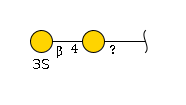
term (main_entry) : Ceramide dihexosyl sulfate
glycan_dictionary_accession : GSD000041
glytoucan_accession : G04416BG
term_in_sentence : Although it has been reported that ceramide dihexosyl sulfate is present in human kidney, it is unlikely that it is present in equine kidney.[PMID:818074]
publication : 818074
definition : A sulfatide with two hexose moieties (glucose and galactose) has been isolated from human kidney (Martensson E, Acta Chem Scand 1963, 17, 1174). Equimolar amounts of ceramide, glucose, galactose, and sulfate are found in the molecule. The sulfate group is esterified, as in sulfatides, with carbon 3 of the galactose moiety. The linkage between galactose and glucose is identical to lactose (b-1-4). Its fatty acid composition is similar to that of sulfatides. [http://cyberlipid.gerli.com/description/complex-lipids/glycolipids/glycosphingolipids/sulfosphingolipids/]
term_xref : GTC:G04416BG|GlycoMotif:GGM.000065
synonyms :
function :
disease_associations :
wikipedia :
essentials_of_glycobiology :
Chondroitin sulfate
term (main_entry) : Chondroitin sulfate
glycan_dictionary_accession : GSD000043
glytoucan_accession :
term_in_sentence : The industrial production of chondroitin sulfate (CS) uses animal tissue sources as raw material derived from different terrestrial or marine species of animals.[PMID: 31013685]
publication : 31013685|27526113|27194526|26980567|28847361|24413804|29891297|29600622|25129732|31317901|29181550|31250530|22265655|25756648|29402610|17928217|20236040|28091940|30824935|26572336|31207331|21110089|30599999|20399897|27226567|19388612|23186102|31494830|28982096|30241863|30295666|25366475|20521042|29456007|31304829|18661362|28576008|29494632|30016441|26906924|24861964|23774590|31887904|31339761|12512856|26957048|29625000
definition : Any of a class of 10—60 kDa glycosaminoglycan sulfates, widely distributed in cartilage and other mammalian connective tissues.[CHEBI:37397]
term_xref : CHEBI:37397|CID:24766
synonyms : chondroitin polysulfate|chondroitin sulfate|chondroitin sulfates|chondroitin sulfuric acid|chondroitin sulphate|Chondroitinsulfate
function :
disease_associations :
wikipedia :
essentials_of_glycobiology :
Chondroitin sulfate/dermatan sulfate
term (main_entry) : Chondroitin sulfate/dermatan sulfate
glycan_dictionary_accession : GSD000184
glytoucan_accession :
term_in_sentence : Heparan sulfate (HS) and chondroitin sulfate/dermatan sulfate (CS/DS) proteoglycans are heavily glycosylated proteins, crucial for animal development and homeostasis. [PMID:35192612]
publication : 35192612|35425970
definition :
term_xref :
synonyms : CS/DS|chondroitin/dermatan sulfate
function :
disease_associations :
wikipedia :
essentials_of_glycobiology :
cisGM1

term (main_entry) : cisGM1
glycan_dictionary_accession : GSD000044
glytoucan_accession : G03277YI
term_in_sentence : Macrophage ganglioside patterns dramatically increase in complexity when murine peritoneal macrophages are stimulated in vivo with the appearance of the sialidase-sensitive monosialoganglioside GM1b (cisGM1) as a major component.[PMID: 9455923]
publication : 9455923
definition : A member of the class of neuraminic acids that is neuraminic acid attached in sequence to β-D-galactopyranosyl, 2-acetamido-2-deoxy-β-D-galactopyranosyl, β-D-galactopyranosyl, and β-D-gucoopyranose units by (2→3), (1→3), (1→4), and (1→4) glycosidic linkages, respectively. It corresponds to the carbohydrate portion of ganglioside GM1b.[CHEBI:145580]
term_xref : GlycoMotif:GGM.000100|GTC:G03277YI|CID:91850212|CHEBI:145580|GlycoEpitope:EP0048|SugarBind_Ligand:92|KEGG:G00125
synonyms : GM1b
function :
disease_associations : Influenza[SugarBind_Ligand:92]
wikipedia :
essentials_of_glycobiology : Chapter 23
Complex-type N-glycans
term (main_entry) : Complex-type N-glycans
glycan_dictionary_accession : GSD000045
glytoucan_accession :
term_in_sentence : In this study, 32 new complex-type glycans are characterized containing the Le(x), Le(Y), and sialyl-Le(x) determinants, the bloodgroup A and H antigens, as well as the ALe(Y) determinant.[PMID:10988252]
publication : 29902282|29212795|29343819|27705835|26745022|18399796|16825488|21964725|15864431|22890903|12417032|28039392|19426135|30253927|16794314|19806620|22975979|25931033|15201278|1912963419129628|24032650|22530754|31021709|30973186|28091941|23115339|20829342|27304954|29090617|21802690|29725121|30471292|16581187|26098720|31080188|1930135|31888963|30844485|24014058|11129583
definition : Type of N-linked glycan in which at least two antenna are present on the trimannosyl core, each initiated by GlcNAc additions catalyzed by position-specific N-acetylglucosaminyltransferases (GlcNAcTs). Each antenna can be exteneded or capped with HexNAc, deoxyHex, Hex, or sialic acid residues.
term_xref :
synonyms :
function : Involved in protein stability.[PMID:12417032]
disease_associations :
wikipedia :
essentials_of_glycobiology : Chapter 17
Core 1

term (main_entry) : Core 1
glycan_dictionary_accession : GSD000186
glytoucan_accession : G00031MO
term_in_sentence : O-glycans are initiated by the addition of GalNAc to serine or threonine (via the ppGalNAcT family of glycosyltransferases), forming the Tn antigen (GalNAcα-O-Ser/Thr), which is used to generate the core 1 structure (Galβ1,3GalNAcα-O-Ser/Thr) on which most complex and branched O-glycans are derived. [PMID:31645367]
publication : 31645367|32297877
definition :
term_xref : GTC:G00031MO|GlycoMotif:GGM.001005
synonyms : C1G
function :
disease_associations :
wikipedia :
essentials_of_glycobiology :
Core 2
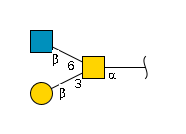
term (main_entry) : Core 2
glycan_dictionary_accession : GSD000046
glytoucan_accession : G00033MO
term_in_sentence : To investigate the biological roles of core 2 O-glycans, we produced and characterized mice deficient in one or more of the three known glycosyltransferases that generate core 2 O-glycans (C2GnT1, C2GnT2, and C2GnT3).[PMID: 19349303]
publication : 19349303|30315106|23640779|26677400
definition : The trisaccharide β-D-Gal-(1→3)-[β-D-GlcNAc-(1→6)]-D-GalNAc with α configuration at the anomeric centre of the N-acetylglucosamine residue at the reducing end.[CHEBI:62158]
term_xref : GTC:G00033MO|CID:52921656|CHEBI:62158
synonyms :
function :
disease_associations :
wikipedia :
essentials_of_glycobiology :
Core 3

term (main_entry) : Core 3
glycan_dictionary_accession : GSD000047
glytoucan_accession : G00035MO
term_in_sentence : Mechanically, we revealed that mucin-type core 3 O-glycan was synthesized at the membrane-tethered MUC1 N terminus because of core 3 synthase expression in colon cancer cells.[PMID: 28745318]
publication : 28745318|27259834|27143302|
definition : An amino disaccharide comprising an N-acetyl-β-D-glucosamine residue linked (1→3) to an N-acetyl-β-D-galactosamine residue at the reducing end.[CHEBI:71344]
term_xref : GTC:G00035MO|CID:25061208|CHEBI:71344
synonyms :
function :
disease_associations :
wikipedia :
essentials_of_glycobiology : Chapter 9
Core 4
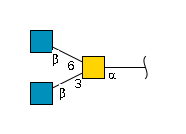
term (main_entry) : Core 4
glycan_dictionary_accession : GSD000048
glytoucan_accession : G00037MO
term_in_sentence : The results confirm the predicted existence of a beta1,6GlcNAc-transferase that functions in both core 2 and core 4 O-glycan branch formation.[PMID: 9988682]
publication : 9988682|10747980|
definition : A branched amino trisaccharide comprising an N -acetyl-α-D-galactosamine residue at the reducing end, to which are (1→3)- and (1→6)-linked two N -acetyl-α-D-glucosamine residues.[CHEBI:71341]
term_xref : GTC:G00037MO| CID:25229562|CHEBI:71341
synonyms :
function :
disease_associations :
wikipedia :
essentials_of_glycobiology : Chapter 8
Core-fucosylated
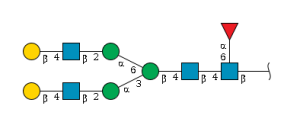
term (main_entry) : Core-fucosylated
glycan_dictionary_accession : GSD000049
glytoucan_accession : G78059CC
term_in_sentence : The approach was validated for selective capture and analysis of core fucosylated N-glycans present in complex glycan mixtures derived from mammalian serum IgG.[PMID:27678371]
publication : 27678371|26514868|15538974|24914453|17049014|32078267|31268672|28674882|29956878|27798819|32044029|30962950|31548313|30907281|29090617|29571940|28800497|27629418|29733746|31623829|28768188|26897254|31451706|26514868|29427759|28982386|26587313|30940702|15538974|31249452|27282921|31229844|30445455|31325506|24732908|29209018|26965517|28609658|24914453|25573275|17049014|19218400|27012207|27139574|32078267|25861849|32561391|21374780|31669139|25732060|29408166|31268672|30472795|30614075|19003000|25664929
definition : Modification of the N-glycan core structure with fucose moiety attached at the innermost GlcNAc by FUT8 enzyme. Core Fuc is found on paucimannose, hybrid and complex type N-glycans. [https://doi.org/10.1016/bs.acr.2014.11.006].
term_xref : GTC:G78059CC|CID:70679232|CHEBI:70967|CHEBI:156499
synonyms : Core Fuc|6-linked Fuc|Fuca6 to chitobiose core|a6-linked Fuc|a1-6 Fuc|Fuca6 to chitobiose core|Fuc a1-6 to chitobiose core|Fuca6 to internal GlcNAc|Fuc a1-6 to internal GlcNAc
function : Required for signaling through TCR [PMID: 29434598]|VGF, PDGFr, and EGFr and TGFbeta receptor dysregulation in Fut8 KO mice [PMID:17132494]|IgG-Fcg receptor interactions destabilized by core Fuc [PMID:29062024]
disease_associations : Emphysema|systemic lupus erythematosuslung cancer|autoimmunity|tumor metastasis
wikipedia :
essentials_of_glycobiology : Chapter 8
Core-fucosylated biantennary

term (main_entry) : Core-fucosylated biantennary
glycan_dictionary_accession : GSD000050
glytoucan_accession : G78059CC
term_in_sentence : The IFN-alpha14c N-glycans were shown to exhibit core-fucosylated biantennary glycans , with about 10% carrying an additional alpha1,3-linked fucose unit at the antennae.[PMID:9654101]
publication : 9654101|15819890|28263871|26763099|22256781|23681398|25855029|10529240|26544759|8206921|33149259|8547276
definition : A biantennary glycan with two GlcNAc branches linked to the core and fucosylation on the core GlcNAc.
term_xref : GTC:G78059CC|CID:70679232|CHEBI:70967|CHEBI:156499
synonyms : core-fucosylated diantennary
function :
disease_associations :
wikipedia :
essentials_of_glycobiology : Chapter 8
Core-fucosylated biantennary complex-type

term (main_entry) : Core-fucosylated biantennary complex-type
glycan_dictionary_accession : GSD000051
glytoucan_accession : G78059CC
term_in_sentence : The oligosaccharide structure at Asn(32 ) is a mixture of the monosialo and asialo forms of a core fucosylated biantennary complex-type oligosaccharide.[PMID:10731668]
publication : 10731668
definition : A biantennary complex glycan with two GlcNAc branches linked to the core and fucosylation on the core GlcNAc.
term_xref : GTC:G78059CC|CID:70679232|CHEBI:70967|CHEBI:156499
synonyms : core fucosylated diantennary complex-type
function :
disease_associations :
wikipedia :
essentials_of_glycobiology :
Cyclic sialyl 6-sulfo Lewis x
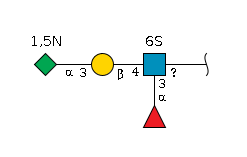
term (main_entry) : Cyclic sialyl 6-sulfo Lewis x
glycan_dictionary_accession : GSD000052
glytoucan_accession : G11148DZ
term_in_sentence : Stimulation of the sialyl 6-sulfo Lewis X-positive colon cancer cell line with a calcium ionophore ionomycin markedly reduced sialyl 6-sulfo Lewis X and induced cyclic sialyl 6-sulfo Lewis X expression.[PMID:10728707]
publication : 10728707|31222115|9990070|23088960
definition :
term_xref : GlycoEpitope:EP0017|CID:91858084|CHEBI:147484
synonyms :
function : The accumulated intracellular cyclic sialyl 6-sulfo Lex determinant may function as a dormant pool of selectin ligands.[GlycoEpitope:EP0017]
disease_associations :
wikipedia :
essentials_of_glycobiology :
Cytolipin R

term (main_entry) : Cytolipin R
glycan_dictionary_accession : GSD000053
glytoucan_accession : G57710SU
term_in_sentence : The reaction can be inhibited completely by pure cytolipin R showing that (a) immune hemolysis can be mediated through lipid determinants in the membrane, and (b) that cytolipin R determinants are present in the intact erythrocyte membrane and exposed on the surface.[PMID:4110375]
publication : 893368|4375678|51702|186204|4110375|5068000|24174198|6072378|389925|7054174
definition : A ceramide tetrahexoside isolated from rat lymphosarcoma. The structure of cytolipin R to be N-acetylgalactosaminyl(beta1-->3)galactosyl(alpha1-->3) galactosyl(beta1-->4)glucosyl ceramide.[PMID:5068000]
term_xref : GlycoMotif:GGM.000083|GTC:G57710SU|CID:91855936|KEGG:G00392|CHEBI:152175|SugarBind_Ligand:17
synonyms :
function :
disease_associations : Actinomycosis[SugarBind_Ligand:17]
wikipedia :
essentials_of_glycobiology :
Dermatan sulfate
term (main_entry) : Dermatan sulfate
glycan_dictionary_accession : GSD000054
glytoucan_accession :
term_in_sentence : By utilizing sophisticated separation methods followed by compositional analysis, domain mapping, and tandem mass spectrometry coupled with analysis by a modified genetic algorithm approach, the structural motif for the decorin dermatan sulfate chain was determined.[PMID:29111696]
publication : 27526113|29111696|29891297|26164146|30869126|7789716|8597249|12512856|31250530|17928217|12213784|27226567|31455633|28091940|19075609|31071403|15078125|18661328|20581662|17239765|15749837|2777747|20632047|8930750|7762784|31006321|26876822|1522290|131009|26986023|8161353|15315969|12543559|30637950|2525357|18156656|9692613|9200333|19661164|2299256|16075147|1126924|9774430|8537360|15563459|21077227|23275130|17137817|6447930|6209270
definition : Any of a group of glycosaminoglycans with repeating units consisting of variously sulfated β1→4-linked L-iduronyl-(α1→3)-N-acetyl-D-galactosamine units.[CHEBI:18376]
term_xref : CHEBI:18376|CID:32756
synonyms : beta-Heparin|Chondroitin sulfate B|Dermatan L-iduronate
function : Wound healing[Essentials of Glycobiology:Chapter 7]|maintain the structure of the dermis.[Essentials of Glycobiology:Chapter 41]
disease_associations :
wikipedia :
essentials_of_glycobiology :
Desialylated
term (main_entry) : Desialylated
glycan_dictionary_accession : GSD000055
glytoucan_accession :
term_in_sentence : Furthermore, we found no evidence for "desialylated" apoB100 glycans in any of the samples analyzed.[PMID:11588155]
publication : 30015642|26168491|29492899|31774586|32321401|23780974|7600681|18045697|1450583|4137057|28911304|27562992|29950245|31978220|2408573|8612720|10910970|27195066|1434544|22175031|24517196|29794068|30101537|18972200|1478792|4440781|21229239|30844664|31351722|31330845|1872910
definition : A glycan from which sialyl groups have been removed. [https://en.wiktionary.org/wiki/desialylated]
term_xref :
synonyms :
function :
disease_associations :
wikipedia :
essentials_of_glycobiology :
Desialylated tetrasaccharide
term (main_entry) : Desialylated tetrasaccharide
glycan_dictionary_accession : GSD000056
glytoucan_accession :
term_in_sentence : The structures of a desialylated tetrasaccharide , two monosialylated trisaccharides , and five other minor products were defined.[PMID:8384526]
publication : 8384526
definition : A tetrasachharide (four branches) glycan from which sialyl groups have been removed.
term_xref :
synonyms :
function :
disease_associations :
wikipedia :
essentials_of_glycobiology : Chapter 17
Difucosylated tetra-antennary N-glycans
term (main_entry) : Difucosylated tetra-antennary N-glycans
glycan_dictionary_accession : GSD000057
glytoucan_accession :
term_in_sentence : While fucosylated N-glycans derived from serum haptoglobin of patients with CP slightly increased, di-fucosylated tetra-antennary N-glycans were observed only at this site in PC patients, and were absent in the haptoglobin of normal controls and individuals with CP.[PMID:18214858]
publication : 18214858
definition : The tetra-antennary N-linked glycans that have four GlcNAc branches linked to the core and two fucose added.
term_xref :
synonyms :
function :
disease_associations : pancreatic cancer[PMID:18214858]
wikipedia :
essentials_of_glycobiology :
Dimeric Lewis x
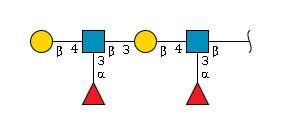
term (main_entry) : Dimeric Lewis x
glycan_dictionary_accession : GSD000058
glytoucan_accession : G79535HZ
term_in_sentence : The carbohydrate antigen dimeric Lewis X (DimLex), which accumulates in colonic and liver adenocarcinomas, is a valuable target to develop anti-cancer therapeutics.[PMID:32957489]
publication : 32957489|31276881|12062524|15488731|1979361|8737237|17939723|7683631|11384108|11133015|17388629|15483381|12662048|3233598|18618154|21892456
definition : A six-membered glucosamine oligosaccharide consisting of two repeating units of β-D-Gal-(1→4)-[α-L-Fuc-(1→3)]-β-D-GlcNAc joined by a (1→3)-linkage.[CHEBI:61325]
term_xref : GTC:G79535HZ|GlycoEpitope:EP0093|CID:50909845|CHEBI:61325|GlycoMotif:GGM.000031
synonyms : DimLex^x|dimeric Le(x)|Lex-Lex|diLe(x)|Lewisx-Lewisx
function : cancer-associated antigen[GlycoEpitope:EP0093]
disease_associations : colonic cancer[GlycoEpitope:EP0093]|liver cancer[GlycoEpitope:EP0093]
wikipedia :
essentials_of_glycobiology : Chapter 14
Diphosphorylated Man6

term (main_entry) : Diphosphorylated Man6
glycan_dictionary_accession : GSD000059
glytoucan_accession : G54792LL
term_in_sentence : Here we report that the single-chain variable domain (scFv) M6P-1 is a unique antibody fragment with specificity for Man6P monosaccharide that, through an array-screening approach against a number of phosphorylated N-glycans, is shown to bind mono- and diphosphorylated Man6 and Man7 glycans that contain terminal αMan6P(1 → 2)αMan(1 → 3)αMan.[PMID:26503547]
publication : 26503547
definition :
term_xref : GTC:G54792LL|GlycoMotif:GGM.000054
synonyms : Diphosphorylated Man_6
function :
disease_associations :
wikipedia :
essentials_of_glycobiology :
Disialosyl globopentaosylceramide
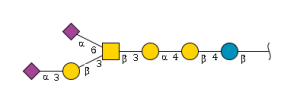
term (main_entry) : Disialosyl globopentaosylceramide
glycan_dictionary_accession : GSD000060
glytoucan_accession : G97932OH
term_in_sentence : Disialosyl globopentaosylceramide (DSGb5) is often expressed by renal cell carcinomas.[PMID:31339142]
publication : 31339142|24637536|25864532|27344728|12084983|32567311|28205070|20663960|18214042
definition : Disialosyl globopentaosylceramide (DSGb5) is a ganglioside originally isolated from tissue extracts of renal cell carcinoma (RCC) with metastasis.[PMID:28205070]
term_xref : GlycoMotif:GGM.000082|GTC:G97932OH|GlycoEpitope:EP0098|CID:91860287|KEGG:G00181|SugarBind_Ligand:57
synonyms : DSGb5|Disialosyl Gb5|V3NeuAcIV6NeuAc-Gb5Cer|Disialosylgalactosylgloboside
function : promotes metastasis[PMID:28205070]
disease_associations : prostate cancer[PMID:24637536]|renal cell carcinoma/RCC[GlycoEpitope:EP0098]|Pyelonephritis[SugarBind_Ligand:57]
wikipedia :
essentials_of_glycobiology :
Disialyl Gb5

term (main_entry) : Disialyl Gb5
glycan_dictionary_accession : GSD000061
glytoucan_accession : G97932OH
term_in_sentence : The major disialoganglioside antigen isolated from ACHN cells, showing specific reactivity with 5F3, was characterized unequivocally as disialosyl Gb5 (V(3)NeuAcIV(6)NeuAcGb5) by identification of the core structure as globopentaosylceramide (Gb5) after enzymatic and acid hydrolysis, and by 2-dimensional (1)H-NMR spectroscopy.[PMID: 12084983]
publication : 12084983
definition :
term_xref : GlycoEpitope:EP0098|GTC:G97932OH|CID:91860287|SugarBind_Ligand:57|KEGG:G00181
synonyms :
function :
disease_associations : renal cell carcinoma/RCC[GlycoEpitope:EP0098]|Pyelonephritis[SugarBind_Ligand:57]
wikipedia :
essentials_of_glycobiology :
Disialyl I
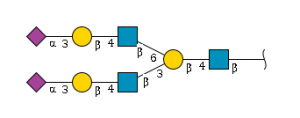
term (main_entry) : Disialyl I
glycan_dictionary_accession : GSD000062
glytoucan_accession : G54937EM
term_in_sentence : Here we present an example of promotion of binding of soluble-form FN from placenta or from hepatoma cells, having a specific carbohydrate epitope termed "disialyl-I," to K562 or VA13 cell surface in the presence of glycosphingolipid Gg3, which interacts specifically with disialyl-I[PMID:10640401]
publication : 10640401
definition :
term_xref : GlycoEpitope:EP0095|GTC:G54937EM|CID:91849523
synonyms : disialyl-I
function :
disease_associations :
wikipedia :
essentials_of_glycobiology :
Disialyl Lewis a
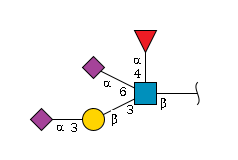
term (main_entry) : Disialyl Lewis a
glycan_dictionary_accession : GSD000063
glytoucan_accession : G93400AK
term_in_sentence : Biosynthesis of disialyl Lewis a (Lea) was analyzed using previously cloned ST6GalNAc V and ST6GalNAc VI, which were responsible for the synthesis of alpha-series gangliosides.[PMID:12668675]
publication : 12668675|17760270|15231659|12668106|30716533|32050430|22467657
definition : Disialyl Lewis is a sialyl Lewis a with an additional sialic acid attached at the C-6 position of penultimate GlcNAc. [PMID:15231659]
term_xref : GTC:G93400AK |GlycoEpitope:EP0040|CID:91854138|CHEBI:155549
synonyms : disialyl Lea
function : The 2-3,2-6 disialyl Lea determinant on epithelial cells may play a role in protecting normal epithelial cells.[GlycoEpitope:EP0040]
disease_associations : Mucin antigen carrying 2-3 sialylated Le a antigen or 2-3, 2-6 disialylated Lc4 antigen in cancer patients had the lowest carbohydrate/protein ratio. Thus, the carbohydrate/protein ratio in the type 1 chain mucin antigens in sera of normal subjects is higher than that in sera of cancer patients.[GlycoEpitope:EP0040]
wikipedia :
essentials_of_glycobiology :
Disialyl T antigen
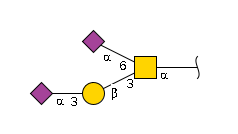
term (main_entry) : Disialyl T antigen
glycan_dictionary_accession : GSD000064
glytoucan_accession : G01614ZM
term_in_sentence : The most potent glycoside was disialyl T antigen (NeuAcalpha2-3Galbeta1-3[NeuAcalpha2-6]GalNAc-R), followed by 3-sialyl T antigen (NeuAcalpha2-3Galbeta1-3GalNAc-R), structures expressed on O-linked glycoproteins as well as on gangliosides.[PMID: 15701648]
publication : 29113555|17974963|33242079|12645620|15701648|26598643
definition : α-Neup5Ac-(2→6)-[α-Neup5Ac-(2→3)-β-D-Galp-(1→3)]-α-D-GalpNAc in which the anomeric configuration of the reducing-end N-acetyl-D-glucosamine residue is α.[CHEBI:71602]
term_xref : GlycoMotif:GGM.000014|GTC:G01614ZM|CID:70698317|CHEBI:71602|GlycoEpitope:EP0023|KEGG:G00027
synonyms : di-sialyl T antigen|disialyl-T antigen|disialylated T-antigen
function : associated with von Willebrand factor(VWF) plasma levels[GlycoEpitope:EP0023]
disease_associations :
wikipedia :
essentials_of_glycobiology :
Disialylated biantennary
term (main_entry) : Disialylated biantennary
glycan_dictionary_accession : GSD000065
glytoucan_accession :
term_in_sentence : FAB-MS, electrospray-mass spectrometry, and linkage analysis demonstrated that each monomer of rat CRP contained one oligosaccharide chain , predominantly a disialylated biantennary structure , attached to Asn-128.[PMID:8486673]
publication : 22426998|17171781|25022802|24812685|24780636|26582205|9499382|22978794|22594947|8486673|20356825|1634621|9244386|12966096|1472054|24243045|19579232|27943633
definition : A biantennary glycan with two GlcNAc branches linked to the core and the addition of two sialic acid residues.
term_xref :
synonyms : disialylated diantennary
function : appears in human transferrin[PMID: 24243045]|Appears in human apolipoprotein (apo) B-100.[PMID:2344297]
disease_associations : galactosemia.[PMID:9499382]
wikipedia :
essentials_of_glycobiology :
Disialylated biantennary complex-type
term (main_entry) : Disialylated biantennary complex-type
glycan_dictionary_accession : GSD000066
glytoucan_accession :
term_in_sentence : The glycan was shown to be a disialylated biantennary complex type oligosaccharide N-linked to 318 Asn.[PMID:11738084]
publication : 11738084|9499382|9244386|24243045|12966096|25124522|19371135
definition : A biantennary complex glycan with two GlcNAc branches linked to the core and the addition of two sialic acid residues.
term_xref :
synonyms :
function : appears in human transferrin[PMID:24243045]|Appears in human apolipoprotein (apo) B-100.[PMID:2344297]
disease_associations : galactosemia.[PMID:9499382]
wikipedia :
essentials_of_glycobiology :
Disialylated fucosylated
term (main_entry) : Disialylated fucosylated
glycan_dictionary_accession : GSD000067
glytoucan_accession :
term_in_sentence : Disialylated fucosylated and monosialylated non-fucosylated oligosaccharides were also identified.[PMID:17591618]
publication : 17591618
definition : A fucosylated glycan with two sialic acid components.
term_xref :
synonyms :
function :
disease_associations :
wikipedia :
essentials_of_glycobiology : Chapter 45
Forssman antigen

term (main_entry) : Forssman antigen
glycan_dictionary_accession : GSD000068
glytoucan_accession : G80062GG
term_in_sentence : Here we report the crystal structure of the complex between SLL-2 and Forssman antigen tetrasaccharide (GalNAcα1-3GalNAcβ1-3 Galα1-4 Galβ at 3.4 √Ö resolution.[PMID:28510705]
publication : 28510705|31933576|28134301|7021748|1802714|7512587|7747818|23325748|268649|31816281|22015168|4147161|2857159|6267170|7293775|13367419|20636540|10460829|23255552|2675268|18955372|7020692|31784953|4114942|31273262|6257673|7696847|1916901|11169215|48262|26022515|6175621|31404475|6983878|8381954|10431785|3257757|6792413|25039359
definition : A linear amino pentasaccharide comprising N-acetyl-α-D-galactosamine, N-acetyl-β-D-galactosamine, α-D-galactose, β-D-galactose and β-D-glucose residues linked sequentially (1→3), (1→3), (1→4) and (1→4).CHEBI:85789]
term_xref : GTC:G80062GG |GlycoEpitope:EP0037|CID91825690|CHEBI:85789
synonyms :
function :
disease_associations :
wikipedia :
essentials_of_glycobiology : Chapter 45
Forssman glycolipid
term (main_entry) : Forssman glycolipid
glycan_dictionary_accession : GSD000069
glytoucan_accession : G80062GG
term_in_sentence : Analysis of metabolically labeled glycolipids released into the apical and basal culture medium, either as shed membrane vesicles or in budding viruses, also demonstrated the presence of the Forssman glycolipid on both apical and basolateral membranes of polarized cells.[PMID:3040119]
publication : 3040119|268649|23240079|28134301|3495590|1138893|10460829|10506200|8855242|1955453|1933935|3355161|6773959|14573676|29898878|10431785|1747956|11214737|7423202|389939|3871816|6187373|16133832|469271|3753492|2695680|7037611|25703376|23798992|414913|1868069|7960243
definition : A linear amino pentasaccharide comprising N-acetyl-α-D-galactosamine, N-acetyl-β-D-galactosamine, α-D-galactose, β-D-galactose and β-D-glucose residues linked sequentially (1→3), (1→3), (1→4) and (1→4).[CHEBI:85789]
term_xref : GlycoMotif:GGM.000084|GTC:G80062GG|CID:91825690|KEGG:G00095|CHEBI:85789|GlycoEpitope:EP0037|SugarBind_Ligand:86
synonyms : Forssman antigen|Globopentosylceramide
function : an antigenic marker for a major subpopulation of macrophages from murine spleen and peripheral lymph nodes[PMID:3495590]
disease_associations : Pyelonephritis[SugarBind_Ligand:86]|Acute cystitis[SugarBind_Ligand:86]
wikipedia :
essentials_of_glycobiology : Chapter 45
Fucose-containing tetraantennary
term (main_entry) : Fucose-containing tetraantennary
glycan_dictionary_accession : GSD000070
glytoucan_accession :
term_in_sentence : The two major N-linked oligosaccharides of Namalwa EPO were fucose-containing tetraantennary and fucose-containing triantennary structures.[PMID:2550193]
publication : 2550193
definition : A tetraantennary glycan with four GlcNAc branches linked to the core and the addition of fucose.
term_xref :
synonyms :
function :
disease_associations :
wikipedia : https://en.wikipedia.org/wiki/Forssman_antigen
essentials_of_glycobiology : Chapter 14
Fucosyl GM1
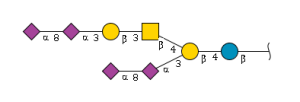
term (main_entry) : Fucosyl GM1
glycan_dictionary_accession : GSD000071
glytoucan_accession : G91532KA
term_in_sentence : Unique localization of fucosyl GM1 implicates its possible role in cell adhesion and recognition in the nervous system.[PMID:8068725]
publication : 6619101|16880505|9089399|29789847|8068725|19556222|1660040|2420639|9076515|15926079|19555091|2541996|16211870|1336587|21174147|14967068|18923900|30021910|16941490|27070150|8305235|10602885|2645049|7993838|10537341|3002616|8336147|15447995|8905401|11714535|9260862|32228455|3315641|8076384|2317201|3680254|6403518
definition : A branched amino hexasaccharide consisting of the linear sequence α-L-Fuc-(1→2)-β-D-Gal-(1→3)-β-D-GalNAc-(1→4)-β-D-Gal-(1→4)-D-Glc having a Neu5Ac residue attached to the inner galactose via an α-(2→3) linkage.[CHEBI:62686]
term_xref : GTC:G91532KA |GlycoEpitope:EP0049|CID:53356699|CHEBI:62686
synonyms :
function :
disease_associations : small-cell lung cancer(SCLC)[GlycoEpitope:EP0049]|hepatoma[GlycoEpitope:EP0049]
wikipedia :
essentials_of_glycobiology :
Fucosylated asialo-biantennary
term (main_entry) : Fucosylated asialo-biantennary
glycan_dictionary_accession : GSD000072
glytoucan_accession :
term_in_sentence : We found that approximately 63% of the total N-linked oligosaccharides were of the complex type, with bisialo-biantennary (28%), asialo-biantennary (7%), fucosylated bisialo-biantennary (25%), and fucosylated asialo-biantennary (3%) oligosaccharides representing the major complex-type carbohydrate species.[PMID:2065054]
publication : 2065054|17013932
definition : Describing a biantennary oligosaccharide that has no sialic acid component but has fucose.
term_xref :
synonyms : fucosylated asialo-diantennary
function :
disease_associations :
wikipedia :
essentials_of_glycobiology :
Fucosylated biantennary
term (main_entry) : Fucosylated biantennary
glycan_dictionary_accession : GSD000073
glytoucan_accession :
term_in_sentence : The profiles of the PSA N-glycans from the free and complexed molecules were quite similar to each other and consisted of fucosylated biantennary oligosaccharides as the major class.[PMID:17956937]
publication : 17956937|30525457|1933856
definition : a biantennary glycan with two GlcNAc branches linked to the core and the addition of fucose.
term_xref :
synonyms : fucosylated bisialo-diantennary
function :
disease_associations :
wikipedia :
essentials_of_glycobiology :
Fucosylated bisialo-biantennary
term (main_entry) : Fucosylated bisialo-biantennary
glycan_dictionary_accession : GSD000074
glytoucan_accession :
term_in_sentence : We found that approximately 63% of the total N-linked oligosaccharides were of the complex type, with bisialo-biantennary (28%), asialo-biantennary (7%), fucosylated bisialo-biantennary (25%), and fucosylated asialo-biantennary (3%) oligosaccharides representing the major complex-type carbohydrate species.[PMID:2065054]
publication : 2065054
definition : Describing a biantennary oligosaccharide that has two sialic acid component and fucose added.
term_xref :
synonyms : Fucosylated biantennary
function :
disease_associations :
wikipedia :
essentials_of_glycobiology :
Fucosylated LDN

term (main_entry) : Fucosylated LDN
glycan_dictionary_accession : GSD000075
glytoucan_accession : G02240AO
term_in_sentence : To date, oligomeric LDN and oligomeric fucosylated LDN (LDNF) have been found only on N-glycans from mammalian cells engineered to express Caenorhabditis elegansbeta4-GalNAc transferase and human alpha3-fucosyltransferase IX [Z. S. Kawar et al. (2005) J Biol Chem280, 12810-12819]. [PMID:16403022]
publication : 16403022|28151933|19545571|22448293
definition : An amino trisaccharide comprising an acetamido-β-D-galactose and an α-L-fucose attached to an acetamidoglucose by 1→4 and 1→3 linkages, respectively.[CHEBI:61864]
term_xref : GlycoMotif:GGM.000017|GTC:G02240AO|GlycoEpitope:EP0151|CID:52921591|CHEBI:61864|MeSH:C488538|KEGG:G01594
synonyms : LDNF|Fucosylated lacdiNAc|LDN-F|(GalNAc)1 (GlcNAc)1 (LFuc)1
function :
disease_associations :
wikipedia :
essentials_of_glycobiology :
Fucosylated N-glycans
term (main_entry) : Fucosylated N-glycans
glycan_dictionary_accession : GSD000076
glytoucan_accession :
term_in_sentence : Haptoglobin , an acute phase protein , has four potential N-glycosylation sites , although it remains unknown which site is responsible for the change in fucosylated N-glycans.[PMID:18214858]
publication : 18214858|31141660|26869352|29790113|31931062
definition : The fucose from GDP-fucose is transferred to N-linked glycans.
term_xref :
synonyms :
function :
disease_associations : pancreatic cancer.[PMID: 26869352]
wikipedia :
essentials_of_glycobiology :
Fucosylated triantennary
term (main_entry) : Fucosylated triantennary
glycan_dictionary_accession : GSD000077
glytoucan_accession :
term_in_sentence : Asn184 is only partially glycosylated and substituted by fucosylated triantennary and small amounts of diantennary N-acetyllactosaminic glycans.[PMID:2513186]
publication : 2513186|29642865|7679920|31110965|2551687|15051952|12943224
definition : A triantennary glycan with three GlcNAc branches linked to the core and the addition of fucose.
term_xref :
synonyms :
function : appears in human alpha-fetoprotein (AFP).[PMID: 7679920]
disease_associations : neoplastic diseases of the liver[PMID: 7679920 ]|hepatocellular carcinoma[PMID: 7679920].
wikipedia :
essentials_of_glycobiology : Chapter 43
Galabiosylceramide

term (main_entry) : Galabiosylceramide
glycan_dictionary_accession : GSD000078
glytoucan_accession : G67988RO
term_in_sentence : LacCer and its structural isomer, galabiosylceramide (Gb2, Galβ(1,4)Galβ-ceramide), are classified as ceramide dihexosides (CDH).[PMID:33360824]
publication : 33360824|29099167|25582508|2824515|4027258|32854306|32868283|31319156|29530250|27367163|2564247|27727434|10216186|10460829|24992926|23590301|15702404|1854798|14761135|3600200|8603914|8601603|1965141|17400502|3840690|15959771|7930586|7721812|17095952|2500499|3815386|8842706|10746023|3928791|3782065|6440894
definition : A disaccharide consisting of β-D-galactopyranose having a D-galactopyranosyl residue attached at the 4-position via an α-linkage.[CHEBI:59314]
term_xref : GlycoEpitope:EP0113|GTC:G67988RO|CID:5288350|KEGG:G00497|KEGG:G10645|CHEBI:59314
synonyms :
function :
disease_associations : tumor/lung[GlycoEpitope:EP0113]|tumor/gallbladder[GlycoEpitope:EP0113]|tumor/kidney[GlycoEpitope:EP0113]|tumor/pancreas[GlycoEpitope:EP0113]
wikipedia :
essentials_of_glycobiology :
Galactosylceramide

term (main_entry) : Galactosylceramide
glycan_dictionary_accession : GSD000079
glytoucan_accession : G65889KE
term_in_sentence : Galactosylceramide improved behavioral, neuropathological, and biochemical parameters in Cln3 Cln3 Δex7/8 mice, paving the way for effective therapy for CLN3 disease and use of serum ceramide as a potential biomarker to track impact of therapies.[PMID:31393621]
publication : 31393621|19941861|9883654|33006978|26735924|22032265|18035062|25129050|2802541|1761517|28660574|475780|2302222
definition :
term_xref : GTC:G65889KE|GlycoEpitope:EP0074|SugarBind_Ligand:1|GlycoMotif:GGM.000061
synonyms : GalCer|Galactocerebroside|LC
function :
disease_associations : Pleuropneumonia[SugarBind_Ligand:1]|Porcine fibrinohemorrhagic necrotizing pleuropneumonia[SugarBind_Ligand:1]|Lyme disease[SugarBind_Ligand:1]|Plague[SugarBind_Ligand:1]|Acquired immune deficiency syndrome[SugarBind_Ligand:1]
wikipedia :
essentials_of_glycobiology :
Galnac disialyl Lc4 (Hexasaccharide)
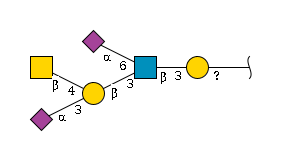
term (main_entry) : Galnac disialyl Lc4 (Hexasaccharide)
glycan_dictionary_accession : GSD000080
glytoucan_accession : G33532XU
term_in_sentence : Therefore, a new marker for prostate cancer is urgently required. We examined expression of a novel carbohydrate antigen, beta1,4-GalNAc-disialyl-Lc(4), defined by the monoclonal antibody RM2, in prostate cancer using 75 cases of radical prostatectomy specimens.[PMID: 12084983]
publication : 15704108|11278988|12084983|7509790
definition : (2R,4S,5R,6R)-5-Acetamido-2-[[(2R,3S,4R,5R,6S)-5-acetamido-4-[(2R,3R,4R,5S,6R)-4-[(2S,4S,5R,6R)-5-acetamido-2-carboxy-4-hydroxy-6-[(1R,2R)-1,2,3-trihydroxypropyl]oxan-2-yl]oxy-5-[(2S,3R,4R,5R,6R)-3-acetamido-4,5-dihydroxy-6-(hydroxymethyl)oxan-2-yl]oxy-3-hydroxy-6-(hydroxymethyl)oxan-2-yl]oxy-3-hydroxy-6-[(3R,4S,5S,6R)-2,3,5-trihydroxy-6-(hydroxymethyl)oxan-4-yl]oxyoxan-2-yl]methoxy]-4-hydroxy-6-[(1R,2R)-1,2,3-trihydroxypropyl]oxane-2-carboxylic acid is a member of neuraminic acids.[CID:91857945]
term_xref : GlycoEpitope:EP0097|GTC:G33532XU|CID:91857945|CHEBI:149360
synonyms :
function :
disease_associations : prostate cancer[GlycoEpitope:EP0097]|renal cell carcinoma/RCC[GlycoEpitope:EP0097]
wikipedia :
essentials_of_glycobiology :
Gb5

term (main_entry) : Gb5
glycan_dictionary_accession : GSD000081
glytoucan_accession : G99053DY
term_in_sentence : LnbB, a member of the glycoside hydrolase family 20 isolated from Bifidobacterium bifidum, was shown to release GNB from Gb5 and GA1 oligosaccharides.[PMID:25839135]
publication : 12401210|25839135|31540393|31140679|3028540|3674263|31339142|30026902|10721708|30671362|26176557|25039255|24044869|32567311|27857717|21491978|24910250|29077212|8014006|27107335|32679486|1747956|8679447|28352526|11341836|10837462|7960243|16158941|3297853|2431136|21734356|8625206|30732055|12716912|20128040|2582447|14659673
definition : A linear amino pentasaccharide comprising D-glucose at the reducing end with a β-D-galactosyl-(1→3)-N-acetyl-β-D-glucosaminyl-(1→3)-α-D-galactosyl-(1→4)-β-D-galactosyl moiety at the 4-position.[CHEBI:141842]
term_xref : GlycoMotif:GGM.000076|GTC:G99053DY|CID:53239691|KEGG:G00097|CHEBI:62311|SugarBind_Ligand:12
synonyms : Globopentaosylceramide
function :
disease_associations : Pyelonephritis[SugarBind_Ligand:12]|Actinomycosis[SugarBind_Ligand:12|Influenza[SugarBind_Ligand:12]
wikipedia :
essentials_of_glycobiology : Chapter 11
GD1

term (main_entry) : GD1
glycan_dictionary_accession : GSD000082
glytoucan_accession : G81983KG
term_in_sentence : Hormonal and metabolic disturbances observed in both adult and paediatric patients with Gaucher disease type 1 (GD1) are discussed in this review. The PubMed database was used to identify articles on endocrine and metabolic disorders in GD1.[PMID:31791361]
publication : 5652802|25345088|31791361|29361370|31234327|30264864|25250137|7528216|31669751|20684311|16306603|10420586|7766692|31614613|26384672|31613991|19210136|8926633|29696051|32300455|7513313|26674302|20336376|24259734|31704237|21067946|30516933|27979707|26345314|30516941|31849452|27789132|30218706|29388611|20177787
definition :
term_xref : GlycoMotif:GGM.000105|GTC:G81983KG|CID:91859783|KEGG:G00126
synonyms : GD1c
function :
disease_associations :
wikipedia :
essentials_of_glycobiology :
GD1a
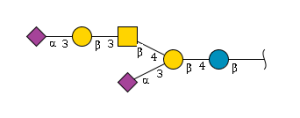
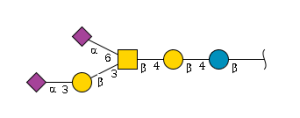
term (main_entry) : GD1a
glycan_dictionary_accession : GSD000083
glytoucan_accession : G46677TE | G45714BQ
term_in_sentence : Exclusive exposure of rat oligodendrocytes to GD1a, but not other gangliosides, overcomes aggregated fibronectin-induced inhibition of myelin membrane formation, in vitro, and OPC differentiation in fibronectin aggregate containing cuprizone-induced demyelinated lesions in male mice. [PMID: 28899916]
publication : 28899916|26860251|21930390|32906699|26054879|29951721|11745410|17653976|26119566|21554929|18435913|15342262|26865725|21151139|15716397|21492147|16942752|26973195|24449473|14999485|22735313|20589721|10521808|22929125|7827024|16897174|25062498|17227759
definition : A branched amino hexasaccharide consisting of the linear sequence α-Neu5Ac-(2→3)-β-D-Gal-(1→3)-β-D-GalNAc-(1→4)-β-D-Gal-(1→4)-β-D-Glc having a Neu5Ac residue attached to a galactose via an α-(2→3) linkage. The oligosaccharide of ganglioside GD1a.[CHEBI:59209]
term_xref : GlycoMotif:GGM.000106|GlycoMotif:GGM.000107|GTC:G46677TE|GTC:G45714BQ|CID:45266861|CHEBI:59209|GlycoEpitope:EP0056|SugarBind_Ligand:22|KEGG:G00111
synonyms : GD1alpha
function :
disease_associations : Gastroenteritis[SugarBind_Ligand:22]|Actinomycosis[SugarBind_Ligand:22]|Lazy leukocyte syndrome[SugarBind_Ligand:22]|Toxoplasmosis[SugarBind_Ligand:22]|Lyme disease[SugarBind_Ligand:22]|Botulism[SugarBind_Ligand:22]|Keratoconjunctivitis[SugarBind_Ligand:22]|Influenza[SugarBind_Ligand:22]
wikipedia :
essentials_of_glycobiology :
GD1b
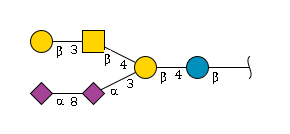
term (main_entry) : GD1b
glycan_dictionary_accession : GSD000084
glytoucan_accession : G37184KW
term_in_sentence : Gangliosides have been known to play a role in the regulation of apoptosis in cancer cells. This study has employed disialyl-ganglioside GD1b to apoptosis in human breast cancer MCF-7 cells using exogenous treatment of the cells with GD1b and endogenous expression of GD1b in MCF-7 cells.[PMID: 27144558]
publication : 27144558|24859332|18625966|7945223|32518172|26710925|31837178|20594196|30985655|11511306|1742806|11123278|7685064|2709011|33279873|22929125|9179156|17964572|8821498|32726962|26560950|2611779|10072058|20030259|16415013|10797556|11342695|8619520|21519903|16199892|23777091|30246056|10481046
definition : A branched amino hexasaccharide comprising a β-D-galactosyl-(1→4)-β-D-glucose disaccharide, the galactosyl residue of which carries β-D-galactosyl-(1→3)-N-acetyl-β-D-galactosaminyl and N-acetyl-α-neuraminyl-(2→8)-N-acetyl-α-neuraminyl disaccharide units through (2→4) and (2→3) linkages respectively. It is the carbohydrate portion of ganglioside GD1b.[CHEBI:59222]
term_xref : GlycoMotif:GGM.000108|GTC:G37184KW|CID:45266846|CHEBI:59222|GlycoEpitope:EP0059|SugarBind_Ligand:14
synonyms :
function :
disease_associations :
wikipedia :
essentials_of_glycobiology : Chapter 47
GD2
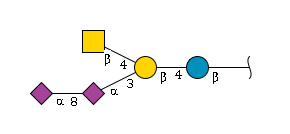
term (main_entry) : GD2
glycan_dictionary_accession : GSD000085
glytoucan_accession : G02657AK
term_in_sentence : Ganglioside GD2 is a tumor-associated surface antigen found in a broad spectrum of human cancers and stem cells. [PMID: 25440605]
publication : 28154831|32002293|32733795|28145567|31500597|31903906|29180536|28415563|25440605|30617136|25604432|30198960|31075227|31721713|30955398|32195035|27304202|31015228|31653037|31016728|30670592|30613134|29221154|30027525|29442009|31762628|30485077|25642322|29436609|29151270|24773917|30612272|27654028|26298772
definition : A branched amino pentasaccharide consisting of a linear sequence of two α-sialyl residues, a β-D-galactosyl residue and an N-acetyl-β-D-glucosamine residue linked respectively (2→8), (2→8) and (1→4), to the galactosyl residue of which is also linked (1→4) an N-acetyl-β-D-glucosaminyl residue. It is the carbohydrate portion of ganglioside GD2.[CHEBI:59218]
term_xref : GlycoMotif:GGM.000094|GTC:G02657AK|CID:45266844|CHEBI:59218|GlycoEpitope:EP0061|SugarBind_Ligand:88
synonyms :
function :
disease_associations : breast cancer[PMID:28415563]
wikipedia :
essentials_of_glycobiology : Chapter 11|Chatper 35
GD3

term (main_entry) : GD3
glycan_dictionary_accession : GSD000086
glytoucan_accession : G98544DH
term_in_sentence : In mammalian cells, the intracellular accumulation of ganglioside GD3, an acidic glycosphingolipid, contributes to mitochondrial damage, a crucial event during the apoptopic program. [PMID: 12531552]
publication : 30245960|27591028|12531552|29069780|12470841|29436609|28295752|27304202|31138648|27288875|30446565|8721669|3903474|16081368|32743804|24372645|26792897|20890432|25330147|20581115|11174200|16040804|23783008|17368571|11023989|12901230|21807667|7061953|2231782|19423750|22632091|18202973|6392333|15896784|8261439|20052288|12847141|12486096|12118012|19912988|22795094|18655184|17043769|21395555|2472199|19776077
definition : A linear amino tetrasaccharide consisting of two sialyl, one galactose and one glucose residue (at the reducing end) connected by sequential α-(2→8)-, α-(2→3)- and β-(1→4)-linkages. The oligosaccharide of ganglioside GD3.[CHEBI:59210]
term_xref : GlycoMotif:GGM.000091|GTC:G98544DH|CID:45266862|CHEBI:59210|GlycoEpitope:EP0062|SugarBind_Ligand:89|MeSH:C509062
synonyms :
function :
disease_associations : Cholera[SugarBind_Ligand:89]|Influenza[SugarBind_Ligand:89]
wikipedia :
essentials_of_glycobiology : Chapter 11
Globoside

term (main_entry) : Globoside
glycan_dictionary_accession : GSD000087
glytoucan_accession : G00061MO
term_in_sentence : Results of TLC immunostaining of neutral glycolipids from the cDNA-transfected cells also supported the identity of the newly synthesized component as globoside. [PMID:[https://pubmed.ncbi.nlm.nih.gov/[https://pubmed.ncbi.nlm.nih.gov/[https://pubmed.ncbi.nlm.nih.gov/10993897 10993897 10993897] [https://pubmed.ncbi.nlm.nih.gov/10993897 10993897 10993897]] [https://pubmed.ncbi.nlm.nih.gov/[https://pubmed.ncbi.nlm.nih.gov/10993897 10993897 10993897] [https://pubmed.ncbi.nlm.nih.gov/10993897 10993897 10993897]]]]
publication : [https://pubmed.ncbi.nlm.nih.gov/[https://pubmed.ncbi.nlm.nih.gov/10993897 10993897 10993897] [https://pubmed.ncbi.nlm.nih.gov/10993897 10993897 10993897]]
definition :
term_xref : GlycoMotif:GGM.000070|GTC:G00061MO
synonyms : Cytolipin K|Gb4|Globoside I|Globotetraosylceramide|P antigen
function :
disease_associations :
wikipedia :
essentials_of_glycobiology : Chapter 47
Globotetraosylceramide

term (main_entry) : Globotetraosylceramide
glycan_dictionary_accession : GSD000088
glytoucan_accession : G00061MO
term_in_sentence : Here we report that PUGNAc treatment provokes globotetraosylceramide (Gb4Cer) accumulation in human umbilical vein endothelial cells (HUVEC).[PMID:[https://pubmed.ncbi.nlm.nih.gov/[https://pubmed.ncbi.nlm.nih.gov/[https://pubmed.ncbi.nlm.nih.gov/28392398 28392398 28392398] [https://pubmed.ncbi.nlm.nih.gov/28392398 28392398 28392398]] [https://pubmed.ncbi.nlm.nih.gov/[https://pubmed.ncbi.nlm.nih.gov/28392398 28392398 28392398] [https://pubmed.ncbi.nlm.nih.gov/28392398 28392398 28392398]]]]
publication : [https://pubmed.ncbi.nlm.nih.gov/[https://pubmed.ncbi.nlm.nih.gov/28392398 28392398 28392398] [https://pubmed.ncbi.nlm.nih.gov/28392398 28392398 28392398]]|25787850|23471986|[https://pubmed.ncbi.nlm.nih.gov/[https://pubmed.ncbi.nlm.nih.gov/2559078 2559078 2559078] [https://pubmed.ncbi.nlm.nih.gov/2559078 2559078 2559078]]|32455599|2663859|32796033|3517161|20082214|30853699|15279935|[https://pubmed.ncbi.nlm.nih.gov/26104834 26104834 26104834]|20732996|30224239|31142708|30338271|25033755|[https://pubmed.ncbi.nlm.nih.gov/30413389 30413389 30413389]|7104376|29866658|24983355|6794884|31361021|21740983|33168837|31752441|28123520|29068380|24841197|27932383|28535204|31691795|27916888|27558838|10227680|26464281|22348006|22279060|25156739|32314902|22718629|23701631|23906628|8613382|23555772|20059899|7868240
definition : An amino tetrasaccharide consisting of 2-acetamido-2-deoxy-β-D-galactopyranosyl, α-D-galactopyranosyl, β-D-galactopyranosyl, and β-D-glucopyranose units joined together in sequence by (1→3), (1→4), and (1→4) glycosidic linkages, respectively.[CHEBI:145578]
term_xref : GlycoMotif:GGM.000070|GlycoEpitope:EP0073|CID:5288889|CHEBI:145578|SugarBind_Ligand:18|MeSH:C024032
synonyms : Gb4Cer|Gb4|Globoside|P antigen|Cytolipin K
function :
disease_associations : Actinomycosis[SugarBind_Ligand:18]|Pyelonephritis[SugarBind_Ligand:18]|Acute cystitis[SugarBind_Ligand:18]|Shigellosis[SugarBind_Ligand:18]|Lazy leukocyte syndrome[SugarBind_Ligand:18]|Influenza[SugarBind_Ligand:18]
wikipedia :
essentials_of_glycobiology : Chapter 11
Globotriaosylceramide

term (main_entry) : Globotriaosylceramide
glycan_dictionary_accession : GSD000089
glytoucan_accession : G00059MO
term_in_sentence : Defects in the gene encoding α-galactosidase A lead to accumulation of globotriaosylceramide (GL3) in various cell types.[PMID:[https://pubmed.ncbi.nlm.nih.gov/32127409 32127409 32127409]]
publication : [https://pubmed.ncbi.nlm.nih.gov/32127409 32127409 32127409]|28674962|30875019|[https://pubmed.ncbi.nlm.nih.gov/30413389 30413389 30413389]|31778662|31101366|24335674|31241709|24158513|28947349|31566927|28672034|31939530|29530250|27851774|26426881|25031264|29982630|24496231|29983334|28756410|27190352|29274327|[https://pubmed.ncbi.nlm.nih.gov/29099167 29099167 29099167]|28402705|23680766|28625968|26960552|26797827|22742555|27756537|31630715|3827883|28384397|29523338|31010832|27195818|26661087|23093409|30879639|27081853|17409683|29921669|25575293|26291612|23146289|25857295|26070511
definition : Globotriaosylceramide is a type of globoside(glycosphingolipid) which is formed by alpha linkage of galactose to lactosylceramide. The reaction is catalyzed by enzyme A4GALT.[Wiki:Globotriaosylceramide]
term_xref : GlycoMotif:GGM.000068|GTC:G00059MO|GlycoEpitope:EP0071|CID:5279515|CHEBI:68485|MeSH:C018549|SugarBind_Ligand:27
synonyms : Gb3|GL3|Pk antigen|P^K antigen|Gb(3)|Gb_3|CD77|globotriaosylceramide|ceramide trihexoside|CTH|Trihexosylceramide
function :
disease_associations : Pyelonephritis[SugarBind_Ligand:27]|Acute cystitis[SugarBind_Ligand:27]|Shigellosis[SugarBind_Ligand:27]|Lyme disease[SugarBind_Ligand:27]|Cutaneous lesions[SugarBind_Ligand:27]|Diarrhea[SugarBind_Ligand:27]
wikipedia :
essentials_of_glycobiology :
Glucosylceramide

term (main_entry) : Glucosylceramide
glycan_dictionary_accession : GSD000090
glytoucan_accession : G71142DF
term_in_sentence : Glucosylceramide (GlcCer), the initial GSL synthesized from ceramide by GCS (GlcCer synthase), is required for embryonic survival, but its role in the lung is unknown.[PMID:[https://pubmed.ncbi.nlm.nih.gov/[https://pubmed.ncbi.nlm.nih.gov/31265321 31265321 31265321] [https://pubmed.ncbi.nlm.nih.gov/31265321 31265321 31265321]]]
publication : [https://pubmed.ncbi.nlm.nih.gov/[https://pubmed.ncbi.nlm.nih.gov/31265321 31265321 31265321] [https://pubmed.ncbi.nlm.nih.gov/31265321 31265321 31265321]]|29290548|29627573|20919653|28427052|30550553|24415933|31914593|31051284|23073611|30146946|31619618|26840726|29750412|8065509|27412675|27840079|[https://pubmed.ncbi.nlm.nih.gov/30611744 30611744 30611744]|31353719|25661072|28686011|25803043|28865794|28154347|31466334|30242129|12531551|30639288|30864417|[https://pubmed.ncbi.nlm.nih.gov/27711049 27711049 27711049]|22764777|27905603|29077010|28744000|23555901|24115322|12803919|29204666|23628459|28851512|26136173|23563543|30110701|26572681|2193825|29926415|31727994|27479571
definition : Cerebrosides which contain as their polar head group a glucose moiety bound in glycosidic linkage to the hydroxyl group of ceramides. Their accumulation in tissue, due to a defect in beta-glucosidase, is the cause of Gaucher's disease.[MeSH:D005963]
term_xref : MeSH:D005963|GlycoMotif:GGM.000060|CHEBI:83264|GTC:G71142DF
synonyms : GlcCer|Glucocerebroside|Ceramide monohexoside|CMH
function : The structural characterization of mixed membranes made of cationic lipids and glucosylceramides may be important for developing novel immunotherapeutic tools such as vaccine adjuvants.[PMID:[https://pubmed.ncbi.nlm.nih.gov/30611744 30611744 30611744]]|Glucosylceramide (GlcCer), the initial GSL synthesized from ceramide by GCS (GlcCer synthase), is required for embryonic survival, but its role in the lung is unknown.[PMID:[https://pubmed.ncbi.nlm.nih.gov/[https://pubmed.ncbi.nlm.nih.gov/31265321 31265321 31265321] [https://pubmed.ncbi.nlm.nih.gov/31265321 31265321 31265321]]]
disease_associations : Gaucher's Disease|Pharyngitis[SugarBind_Ligand:3]|Tracheobronchitis[SugarBind_Ligand:3]|Pleuropneumonia[SugarBind_Ligand:3]|Porcine fibrinohemorrhagic necrotizing pleuropneumonia[SugarBind_Ligand:3]|Diarrhea[SugarBind_Ligand:3]
wikipedia :
essentials_of_glycobiology : Chapter 31
GM1
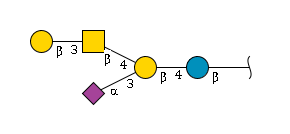
term (main_entry) : GM1
glycan_dictionary_accession : GSD000091
glytoucan_accession : G48558GR
term_in_sentence : GM1-induced fluidization of the phospholipid membranes and probable physical contact between bulky sugar head group of GM1 and spectrin, may explain the modulatory role of GM1 on aminophospholipid interactions with nonerythroid brain spectrin.[PMID: [https://pubmed.ncbi.nlm.nih.gov/[https://pubmed.ncbi.nlm.nih.gov/29920238 29920238 29920238] [https://pubmed.ncbi.nlm.nih.gov/29920238 29920238 29920238]]]
publication : [https://pubmed.ncbi.nlm.nih.gov/[https://pubmed.ncbi.nlm.nih.gov/18524657 18524657 18524657] [https://pubmed.ncbi.nlm.nih.gov/18524657 18524657 18524657]]|[https://pubmed.ncbi.nlm.nih.gov/[https://pubmed.ncbi.nlm.nih.gov/31761138 31761138 31761138] [https://pubmed.ncbi.nlm.nih.gov/31761138 31761138 31761138]]|[https://pubmed.ncbi.nlm.nih.gov/[https://pubmed.ncbi.nlm.nih.gov/36180805 36180805 36180805] [https://pubmed.ncbi.nlm.nih.gov/36180805 36180805 36180805]]|[https://pubmed.ncbi.nlm.nih.gov/[https://pubmed.ncbi.nlm.nih.gov/[https://pubmed.ncbi.nlm.nih.gov/29920238 29920238 29920238] [https://pubmed.ncbi.nlm.nih.gov/29920238 29920238 29920238]] [https://pubmed.ncbi.nlm.nih.gov/[https://pubmed.ncbi.nlm.nih.gov/29920238 29920238 29920238] [https://pubmed.ncbi.nlm.nih.gov/29920238 29920238 29920238]]]|[https://pubmed.ncbi.nlm.nih.gov/[https://pubmed.ncbi.nlm.nih.gov/[https://pubmed.ncbi.nlm.nih.gov/[https://pubmed.ncbi.nlm.nih.gov/33859490 33859490 33859490] [https://pubmed.ncbi.nlm.nih.gov/33859490 33859490 33859490]] [https://pubmed.ncbi.nlm.nih.gov/[https://pubmed.ncbi.nlm.nih.gov/33859490 33859490 33859490] [https://pubmed.ncbi.nlm.nih.gov/33859490 33859490 33859490]]] [https://pubmed.ncbi.nlm.nih.gov/[https://pubmed.ncbi.nlm.nih.gov/[https://pubmed.ncbi.nlm.nih.gov/33859490 33859490 33859490] [https://pubmed.ncbi.nlm.nih.gov/33859490 33859490 33859490]] [https://pubmed.ncbi.nlm.nih.gov/[https://pubmed.ncbi.nlm.nih.gov/33859490 33859490 33859490] [https://pubmed.ncbi.nlm.nih.gov/33859490 33859490 33859490]]]]|[https://pubmed.ncbi.nlm.nih.gov/[https://pubmed.ncbi.nlm.nih.gov/31937438 31937438 31937438] [https://pubmed.ncbi.nlm.nih.gov/31937438 31937438 31937438]]|[https://pubmed.ncbi.nlm.nih.gov/[https://pubmed.ncbi.nlm.nih.gov/25762012 25762012 25762012] [https://pubmed.ncbi.nlm.nih.gov/25762012 25762012 25762012]]|[https://pubmed.ncbi.nlm.nih.gov/[https://pubmed.ncbi.nlm.nih.gov/25931034 25931034 25931034] [https://pubmed.ncbi.nlm.nih.gov/25931034 25931034 25931034]]|[https://pubmed.ncbi.nlm.nih.gov/[https://pubmed.ncbi.nlm.nih.gov/31776384 31776384 31776384] [https://pubmed.ncbi.nlm.nih.gov/31776384 31776384 31776384]]|[https://pubmed.ncbi.nlm.nih.gov/[https://pubmed.ncbi.nlm.nih.gov/32013258 32013258 32013258] [https://pubmed.ncbi.nlm.nih.gov/32013258 32013258 32013258]]|[https://pubmed.ncbi.nlm.nih.gov/[https://pubmed.ncbi.nlm.nih.gov/30776097 30776097 30776097] [https://pubmed.ncbi.nlm.nih.gov/30776097 30776097 30776097]]|[https://pubmed.ncbi.nlm.nih.gov/[https://pubmed.ncbi.nlm.nih.gov/31048748 31048748 31048748] [https://pubmed.ncbi.nlm.nih.gov/31048748 31048748 31048748]]|[https://pubmed.ncbi.nlm.nih.gov/[https://pubmed.ncbi.nlm.nih.gov/31447771 31447771 31447771] [https://pubmed.ncbi.nlm.nih.gov/31447771 31447771 31447771]]|[https://pubmed.ncbi.nlm.nih.gov/[https://pubmed.ncbi.nlm.nih.gov/30292198 30292198 30292198] [https://pubmed.ncbi.nlm.nih.gov/30292198 30292198 30292198]]|[https://pubmed.ncbi.nlm.nih.gov/[https://pubmed.ncbi.nlm.nih.gov/28796418 28796418 28796418] [https://pubmed.ncbi.nlm.nih.gov/28796418 28796418 28796418]]|[https://pubmed.ncbi.nlm.nih.gov/[https://pubmed.ncbi.nlm.nih.gov/27806275 27806275 27806275] [https://pubmed.ncbi.nlm.nih.gov/27806275 27806275 27806275]]|[https://pubmed.ncbi.nlm.nih.gov/[https://pubmed.ncbi.nlm.nih.gov/21076871 21076871 21076871] [https://pubmed.ncbi.nlm.nih.gov/21076871 21076871 21076871]]|[https://pubmed.ncbi.nlm.nih.gov/[https://pubmed.ncbi.nlm.nih.gov/27552916 27552916 27552916] [https://pubmed.ncbi.nlm.nih.gov/27552916 27552916 27552916]]|[https://pubmed.ncbi.nlm.nih.gov/[https://pubmed.ncbi.nlm.nih.gov/17986147 17986147 17986147] [https://pubmed.ncbi.nlm.nih.gov/17986147 17986147 17986147]]|[https://pubmed.ncbi.nlm.nih.gov/[https://pubmed.ncbi.nlm.nih.gov/26960162 26960162 26960162] [https://pubmed.ncbi.nlm.nih.gov/26960162 26960162 26960162]]|[https://pubmed.ncbi.nlm.nih.gov/[https://pubmed.ncbi.nlm.nih.gov/27815022 27815022 27815022] [https://pubmed.ncbi.nlm.nih.gov/27815022 27815022 27815022]]|[https://pubmed.ncbi.nlm.nih.gov/[https://pubmed.ncbi.nlm.nih.gov/25851126 25851126 25851126] [https://pubmed.ncbi.nlm.nih.gov/25851126 25851126 25851126]]|[https://pubmed.ncbi.nlm.nih.gov/[https://pubmed.ncbi.nlm.nih.gov/32916822 32916822 32916822] [https://pubmed.ncbi.nlm.nih.gov/32916822 32916822 32916822]]|[https://pubmed.ncbi.nlm.nih.gov/[https://pubmed.ncbi.nlm.nih.gov/11462671 11462671 11462671] [https://pubmed.ncbi.nlm.nih.gov/11462671 11462671 11462671]]|[https://pubmed.ncbi.nlm.nih.gov/[https://pubmed.ncbi.nlm.nih.gov/28236574 28236574 28236574] [https://pubmed.ncbi.nlm.nih.gov/28236574 28236574 28236574]]|[https://pubmed.ncbi.nlm.nih.gov/[https://pubmed.ncbi.nlm.nih.gov/15911874 15911874 15911874] [https://pubmed.ncbi.nlm.nih.gov/15911874 15911874 15911874]]|[https://pubmed.ncbi.nlm.nih.gov/[https://pubmed.ncbi.nlm.nih.gov/28577204 28577204 28577204] [https://pubmed.ncbi.nlm.nih.gov/28577204 28577204 28577204]]|[https://pubmed.ncbi.nlm.nih.gov/[https://pubmed.ncbi.nlm.nih.gov/28497346 28497346 28497346] [https://pubmed.ncbi.nlm.nih.gov/28497346 28497346 28497346]]|[https://pubmed.ncbi.nlm.nih.gov/[https://pubmed.ncbi.nlm.nih.gov/1794005 1794005 1794005] [https://pubmed.ncbi.nlm.nih.gov/1794005 1794005 1794005]]|[https://pubmed.ncbi.nlm.nih.gov/[https://pubmed.ncbi.nlm.nih.gov/31934908 31934908 31934908] [https://pubmed.ncbi.nlm.nih.gov/31934908 31934908 31934908]]|[https://pubmed.ncbi.nlm.nih.gov/[https://pubmed.ncbi.nlm.nih.gov/30267299 30267299 30267299] [https://pubmed.ncbi.nlm.nih.gov/30267299 30267299 30267299]]|[https://pubmed.ncbi.nlm.nih.gov/[https://pubmed.ncbi.nlm.nih.gov/16902585 16902585 16902585] [https://pubmed.ncbi.nlm.nih.gov/16902585 16902585 16902585]]|[https://pubmed.ncbi.nlm.nih.gov/[https://pubmed.ncbi.nlm.nih.gov/29439846 29439846 29439846] [https://pubmed.ncbi.nlm.nih.gov/29439846 29439846 29439846]]|[https://pubmed.ncbi.nlm.nih.gov/[https://pubmed.ncbi.nlm.nih.gov/32325905 32325905 32325905] [https://pubmed.ncbi.nlm.nih.gov/32325905 32325905 32325905]]|[https://pubmed.ncbi.nlm.nih.gov/[https://pubmed.ncbi.nlm.nih.gov/29747823 29747823 29747823] [https://pubmed.ncbi.nlm.nih.gov/29747823 29747823 29747823]]|[https://pubmed.ncbi.nlm.nih.gov/[https://pubmed.ncbi.nlm.nih.gov/27576485 27576485 27576485] [https://pubmed.ncbi.nlm.nih.gov/27576485 27576485 27576485]]|[https://pubmed.ncbi.nlm.nih.gov/[https://pubmed.ncbi.nlm.nih.gov/26338710 26338710 26338710] [https://pubmed.ncbi.nlm.nih.gov/26338710 26338710 26338710]]|[https://pubmed.ncbi.nlm.nih.gov/[https://pubmed.ncbi.nlm.nih.gov/27858734 27858734 27858734] [https://pubmed.ncbi.nlm.nih.gov/27858734 27858734 27858734]]|[https://pubmed.ncbi.nlm.nih.gov/[https://pubmed.ncbi.nlm.nih.gov/24501414 24501414 24501414] [https://pubmed.ncbi.nlm.nih.gov/24501414 24501414 24501414]]|[https://pubmed.ncbi.nlm.nih.gov/[https://pubmed.ncbi.nlm.nih.gov/26818965 26818965 26818965] [https://pubmed.ncbi.nlm.nih.gov/26818965 26818965 26818965]]|[https://pubmed.ncbi.nlm.nih.gov/[https://pubmed.ncbi.nlm.nih.gov/26629687 26629687 26629687] [https://pubmed.ncbi.nlm.nih.gov/26629687 26629687 26629687]]|[https://pubmed.ncbi.nlm.nih.gov/[https://pubmed.ncbi.nlm.nih.gov/26958633 26958633 26958633] [https://pubmed.ncbi.nlm.nih.gov/26958633 26958633 26958633]]|[https://pubmed.ncbi.nlm.nih.gov/[https://pubmed.ncbi.nlm.nih.gov/1854596 1854596 1854596] [https://pubmed.ncbi.nlm.nih.gov/1854596 1854596 1854596]]|[https://pubmed.ncbi.nlm.nih.gov/[https://pubmed.ncbi.nlm.nih.gov/32134593 32134593 32134593] [https://pubmed.ncbi.nlm.nih.gov/32134593 32134593 32134593]]|[https://pubmed.ncbi.nlm.nih.gov/[https://pubmed.ncbi.nlm.nih.gov/32198666 32198666 32198666] [https://pubmed.ncbi.nlm.nih.gov/32198666 32198666 32198666]]|[https://pubmed.ncbi.nlm.nih.gov/[https://pubmed.ncbi.nlm.nih.gov/6619101 6619101 6619101] [https://pubmed.ncbi.nlm.nih.gov/6619101 6619101 6619101]]
definition : A branched amino pentasaccharide consisting of the linear sequence β-D-Gal-(1→3)-β-D-GalNAc-(1→4)-β-D-Gal-(1→4)-β-D-Glc having a Neu5Ac residue attached to the inner galactose via an α-(2→3) linkage. The oligosaccharide of ganglioside GM1a.[CHEBI:59208]
term_xref : GlycoMotif:GGM.000098|GTC:G48558GR|CID:196569|CHEBI:59208|GlycoEpitope:EP0050|SugarBind_Ligand:13|KEGG:G00110
synonyms : GM1 ganglioside|GM1-ganglioside
function : The branched pentasaccharide chain of ganglioside GM1 is a prominent cell surface ligand, for example, for cholera toxin or tumor growth-regulatory homodimeric galectins.[PMID:[https://pubmed.ncbi.nlm.nih.gov/[https://pubmed.ncbi.nlm.nih.gov/16267866 16267866 16267866]/ [https://pubmed.ncbi.nlm.nih.gov/16267866 16267866 16267866]]]
disease_associations : GM1 gangliosidosis (GM1) [PMID: [https://pubmed.ncbi.nlm.nih.gov/[https://pubmed.ncbi.nlm.nih.gov/[https://pubmed.ncbi.nlm.nih.gov/[https://pubmed.ncbi.nlm.nih.gov/33859490 33859490 33859490] [https://pubmed.ncbi.nlm.nih.gov/33859490 33859490 33859490]] [https://pubmed.ncbi.nlm.nih.gov/[https://pubmed.ncbi.nlm.nih.gov/33859490 33859490 33859490] [https://pubmed.ncbi.nlm.nih.gov/33859490 33859490 33859490]]]/ [https://pubmed.ncbi.nlm.nih.gov/[https://pubmed.ncbi.nlm.nih.gov/[https://pubmed.ncbi.nlm.nih.gov/33859490 33859490 33859490] [https://pubmed.ncbi.nlm.nih.gov/33859490 33859490 33859490]] [https://pubmed.ncbi.nlm.nih.gov/[https://pubmed.ncbi.nlm.nih.gov/33859490 33859490 33859490] [https://pubmed.ncbi.nlm.nih.gov/33859490 33859490 33859490]]]]]|Gastroenteritis[SugarBind_Ligand:13]|Actinomycosis[SugarBind_Ligand:13]|Lazy leukocyte syndrome[SugarBind_Ligand:13]|Toxoplasmosis[SugarBind_Ligand:13]|Cholera[SugarBind_Ligand:13]|Botulism[SugarBind_Ligand:13]
wikipedia : https://en.wikipedia.org/wiki/GM1
essentials_of_glycobiology : Chapter 11| Chapter 14
GM2
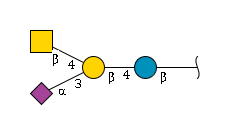
term (main_entry) : GM2
glycan_dictionary_accession : GSD000092
glytoucan_accession : G79389NT
term_in_sentence : GM1 gangliosidosis has both central nervous system and systemic findings; while, GM2 gangliosidosis is restricted primarily to the central nervous system.[PMID: [https://pubmed.ncbi.nlm.nih.gov/[https://pubmed.ncbi.nlm.nih.gov/27491214 27491214 27491214] [https://pubmed.ncbi.nlm.nih.gov/27491214 27491214 27491214]]]
publication : [https://pubmed.ncbi.nlm.nih.gov/[https://pubmed.ncbi.nlm.nih.gov/29618308 29618308 29618308] [https://pubmed.ncbi.nlm.nih.gov/29618308 29618308 29618308]]|[https://pubmed.ncbi.nlm.nih.gov/[https://pubmed.ncbi.nlm.nih.gov/[https://pubmed.ncbi.nlm.nih.gov/27491214 27491214 27491214] [https://pubmed.ncbi.nlm.nih.gov/27491214 27491214 27491214]] [https://pubmed.ncbi.nlm.nih.gov/[https://pubmed.ncbi.nlm.nih.gov/27491214 27491214 27491214] [https://pubmed.ncbi.nlm.nih.gov/27491214 27491214 27491214]]]|[https://pubmed.ncbi.nlm.nih.gov/[https://pubmed.ncbi.nlm.nih.gov/32867370 32867370 32867370] [https://pubmed.ncbi.nlm.nih.gov/32867370 32867370 32867370]]|[https://pubmed.ncbi.nlm.nih.gov/[https://pubmed.ncbi.nlm.nih.gov/30030044 30030044 30030044] [https://pubmed.ncbi.nlm.nih.gov/30030044 30030044 30030044]]|[https://pubmed.ncbi.nlm.nih.gov/[https://pubmed.ncbi.nlm.nih.gov/27499644 27499644 27499644] [https://pubmed.ncbi.nlm.nih.gov/27499644 27499644 27499644]]|[https://pubmed.ncbi.nlm.nih.gov/[https://pubmed.ncbi.nlm.nih.gov/31097363 31097363 31097363] [https://pubmed.ncbi.nlm.nih.gov/31097363 31097363 31097363]]|[https://pubmed.ncbi.nlm.nih.gov/[https://pubmed.ncbi.nlm.nih.gov/29100724 29100724 29100724] [https://pubmed.ncbi.nlm.nih.gov/29100724 29100724 29100724]]|[https://pubmed.ncbi.nlm.nih.gov/[https://pubmed.ncbi.nlm.nih.gov/27402091 27402091 27402091] [https://pubmed.ncbi.nlm.nih.gov/27402091 27402091 27402091]]|[https://pubmed.ncbi.nlm.nih.gov/[https://pubmed.ncbi.nlm.nih.gov/31852956 31852956 31852956] [https://pubmed.ncbi.nlm.nih.gov/31852956 31852956 31852956]]|[https://pubmed.ncbi.nlm.nih.gov/[https://pubmed.ncbi.nlm.nih.gov/30389374 30389374 30389374] [https://pubmed.ncbi.nlm.nih.gov/30389374 30389374 30389374]]|[https://pubmed.ncbi.nlm.nih.gov/[https://pubmed.ncbi.nlm.nih.gov/30988135 30988135 30988135] [https://pubmed.ncbi.nlm.nih.gov/30988135 30988135 30988135]]|[https://pubmed.ncbi.nlm.nih.gov/[https://pubmed.ncbi.nlm.nih.gov/8786814 8786814 8786814] [https://pubmed.ncbi.nlm.nih.gov/8786814 8786814 8786814]]|[https://pubmed.ncbi.nlm.nih.gov/[https://pubmed.ncbi.nlm.nih.gov/14533808 14533808 14533808] [https://pubmed.ncbi.nlm.nih.gov/14533808 14533808 14533808]]|[https://pubmed.ncbi.nlm.nih.gov/[https://pubmed.ncbi.nlm.nih.gov/23370522 23370522 23370522] [https://pubmed.ncbi.nlm.nih.gov/23370522 23370522 23370522]]|[https://pubmed.ncbi.nlm.nih.gov/[https://pubmed.ncbi.nlm.nih.gov/28192816 28192816 28192816] [https://pubmed.ncbi.nlm.nih.gov/28192816 28192816 28192816]]|[https://pubmed.ncbi.nlm.nih.gov/[https://pubmed.ncbi.nlm.nih.gov/32692591 32692591 32692591] [https://pubmed.ncbi.nlm.nih.gov/32692591 32692591 32692591]]|[https://pubmed.ncbi.nlm.nih.gov/[https://pubmed.ncbi.nlm.nih.gov/29106755 29106755 29106755] [https://pubmed.ncbi.nlm.nih.gov/29106755 29106755 29106755]]|[https://pubmed.ncbi.nlm.nih.gov/[https://pubmed.ncbi.nlm.nih.gov/28833537 28833537 28833537] [https://pubmed.ncbi.nlm.nih.gov/28833537 28833537 28833537]]|[https://pubmed.ncbi.nlm.nih.gov/[https://pubmed.ncbi.nlm.nih.gov/11339652 11339652 11339652] [https://pubmed.ncbi.nlm.nih.gov/11339652 11339652 11339652]]|[https://pubmed.ncbi.nlm.nih.gov/[https://pubmed.ncbi.nlm.nih.gov/9728335 9728335 9728335] [https://pubmed.ncbi.nlm.nih.gov/9728335 9728335 9728335]]|[https://pubmed.ncbi.nlm.nih.gov/[https://pubmed.ncbi.nlm.nih.gov/27270764 27270764 27270764] [https://pubmed.ncbi.nlm.nih.gov/27270764 27270764 27270764]]|[https://pubmed.ncbi.nlm.nih.gov/[https://pubmed.ncbi.nlm.nih.gov/9714704 9714704 9714704] [https://pubmed.ncbi.nlm.nih.gov/9714704 9714704 9714704]]|[https://pubmed.ncbi.nlm.nih.gov/[https://pubmed.ncbi.nlm.nih.gov/26175473 26175473 26175473] [https://pubmed.ncbi.nlm.nih.gov/26175473 26175473 26175473]]|[https://pubmed.ncbi.nlm.nih.gov/[https://pubmed.ncbi.nlm.nih.gov/27018595 27018595 27018595] [https://pubmed.ncbi.nlm.nih.gov/27018595 27018595 27018595]]|[https://pubmed.ncbi.nlm.nih.gov/[https://pubmed.ncbi.nlm.nih.gov/28615102 28615102 28615102] [https://pubmed.ncbi.nlm.nih.gov/28615102 28615102 28615102]]|[https://pubmed.ncbi.nlm.nih.gov/[https://pubmed.ncbi.nlm.nih.gov/28974375 28974375 28974375] [https://pubmed.ncbi.nlm.nih.gov/28974375 28974375 28974375]]|[https://pubmed.ncbi.nlm.nih.gov/[https://pubmed.ncbi.nlm.nih.gov/32951593 32951593 32951593] [https://pubmed.ncbi.nlm.nih.gov/32951593 32951593 32951593]]|[https://pubmed.ncbi.nlm.nih.gov/[https://pubmed.ncbi.nlm.nih.gov/11462672 11462672 11462672] [https://pubmed.ncbi.nlm.nih.gov/11462672 11462672 11462672]]|[https://pubmed.ncbi.nlm.nih.gov/[https://pubmed.ncbi.nlm.nih.gov/28955902 28955902 28955902] [https://pubmed.ncbi.nlm.nih.gov/28955902 28955902 28955902]]|[https://pubmed.ncbi.nlm.nih.gov/[https://pubmed.ncbi.nlm.nih.gov/17192692 17192692 17192692] [https://pubmed.ncbi.nlm.nih.gov/17192692 17192692 17192692]]|[https://pubmed.ncbi.nlm.nih.gov/[https://pubmed.ncbi.nlm.nih.gov/26538065 26538065 26538065] [https://pubmed.ncbi.nlm.nih.gov/26538065 26538065 26538065]]|[https://pubmed.ncbi.nlm.nih.gov/[https://pubmed.ncbi.nlm.nih.gov/25421609 25421609 25421609] [https://pubmed.ncbi.nlm.nih.gov/25421609 25421609 25421609]]|[https://pubmed.ncbi.nlm.nih.gov/[https://pubmed.ncbi.nlm.nih.gov/9572057 9572057 9572057] [https://pubmed.ncbi.nlm.nih.gov/9572057 9572057 9572057]]|[https://pubmed.ncbi.nlm.nih.gov/[https://pubmed.ncbi.nlm.nih.gov/11596983 11596983 11596983] [https://pubmed.ncbi.nlm.nih.gov/11596983 11596983 11596983]]|[https://pubmed.ncbi.nlm.nih.gov/[https://pubmed.ncbi.nlm.nih.gov/15264019 15264019 15264019] [https://pubmed.ncbi.nlm.nih.gov/15264019 15264019 15264019]]|[https://pubmed.ncbi.nlm.nih.gov/[https://pubmed.ncbi.nlm.nih.gov/23236285 23236285 23236285] [https://pubmed.ncbi.nlm.nih.gov/23236285 23236285 23236285]]|[https://pubmed.ncbi.nlm.nih.gov/[https://pubmed.ncbi.nlm.nih.gov/11596984 11596984 11596984] [https://pubmed.ncbi.nlm.nih.gov/11596984 11596984 11596984]]|[https://pubmed.ncbi.nlm.nih.gov/[https://pubmed.ncbi.nlm.nih.gov/31261761 31261761 31261761] [https://pubmed.ncbi.nlm.nih.gov/31261761 31261761 31261761]]|[https://pubmed.ncbi.nlm.nih.gov/[https://pubmed.ncbi.nlm.nih.gov/30113798 30113798 30113798] [https://pubmed.ncbi.nlm.nih.gov/30113798 30113798 30113798]]|[https://pubmed.ncbi.nlm.nih.gov/[https://pubmed.ncbi.nlm.nih.gov/24391178 24391178 24391178] [https://pubmed.ncbi.nlm.nih.gov/24391178 24391178 24391178]]|[https://pubmed.ncbi.nlm.nih.gov/[https://pubmed.ncbi.nlm.nih.gov/24309906 24309906 24309906] [https://pubmed.ncbi.nlm.nih.gov/24309906 24309906 24309906]]|[https://pubmed.ncbi.nlm.nih.gov/[https://pubmed.ncbi.nlm.nih.gov/22224667 22224667 22224667] [https://pubmed.ncbi.nlm.nih.gov/22224667 22224667 22224667]]|[https://pubmed.ncbi.nlm.nih.gov/[https://pubmed.ncbi.nlm.nih.gov/7980537 7980537 7980537] [https://pubmed.ncbi.nlm.nih.gov/7980537 7980537 7980537]]|[https://pubmed.ncbi.nlm.nih.gov/[https://pubmed.ncbi.nlm.nih.gov/18272501 18272501 18272501] [https://pubmed.ncbi.nlm.nih.gov/18272501 18272501 18272501]]|[https://pubmed.ncbi.nlm.nih.gov/[https://pubmed.ncbi.nlm.nih.gov/9006924 9006924 9006924] [https://pubmed.ncbi.nlm.nih.gov/9006924 9006924 9006924]]|
definition : A branched amino tetrasaccharide consisting of the linear sequence β-D-GalNAc-(1→4)-β-D-Gal-(1→4)-β-D-Glc having a Neu5Ac residue attached to the galactose via an α-(2→3) linkage. Corresponds to the carbohydrate portion of ganglioside GM2.[CHEBI:59220]
term_xref : GlycoMotif:GGM.000095|GTC:G79389NT|CID:[https://pubmed.ncbi.nlm.nih.gov/45266845 45266845 45266845]|CHEBI:59220|GlycoEpitope:EP0051|SugarBind_Ligand:39|KEGG:G00109|KEGG:G10351
synonyms :
function :
disease_associations : lung adenocarcinoma[GlycoEpitope:EP0051]|embryonal carcinoma[GlycoEpitope:EP0051]|germ cell tumor[GlycoEpitope:EP0051]|teratocarcinoma[GlycoEpitope:EP0051]|squamous cell carcinoma[GlycoEpitope:EP0051]|Gastroenteritis[SugarBind_Ligand:39]|Cholera[SugarBind_Ligand:39]|Clostridial myonecrosis[SugarBind_Ligand:39]|Tetanus[SugarBind_Ligand:39]
wikipedia : https://en.wikipedia.org/wiki/GM1_gangliosidoses
essentials_of_glycobiology : Chapter 11
GM3

term (main_entry) : GM3
glycan_dictionary_accession : GSD000093
glytoucan_accession : G91237TK
term_in_sentence : We also demonstrated an essential role of GM3 in murine and human auditory systems; a common pathological feature of GM3S deficiency is deafness. [PMID: [https://pubmed.ncbi.nlm.nih.gov/[https://pubmed.ncbi.nlm.nih.gov/29747813 29747813 29747813] [https://pubmed.ncbi.nlm.nih.gov/29747813 29747813 29747813]]]
publication : [https://pubmed.ncbi.nlm.nih.gov/[https://pubmed.ncbi.nlm.nih.gov/29376491 29376491 29376491] [https://pubmed.ncbi.nlm.nih.gov/29376491 29376491 29376491]]|[https://pubmed.ncbi.nlm.nih.gov/[https://pubmed.ncbi.nlm.nih.gov/[https://pubmed.ncbi.nlm.nih.gov/29747813 29747813 29747813] [https://pubmed.ncbi.nlm.nih.gov/29747813 29747813 29747813]] [https://pubmed.ncbi.nlm.nih.gov/[https://pubmed.ncbi.nlm.nih.gov/29747813 29747813 29747813] [https://pubmed.ncbi.nlm.nih.gov/29747813 29747813 29747813]]]|[https://pubmed.ncbi.nlm.nih.gov/[https://pubmed.ncbi.nlm.nih.gov/25613425 25613425 25613425] [https://pubmed.ncbi.nlm.nih.gov/25613425 25613425 25613425]]|[https://pubmed.ncbi.nlm.nih.gov/[https://pubmed.ncbi.nlm.nih.gov/30318083 30318083 30318083] [https://pubmed.ncbi.nlm.nih.gov/30318083 30318083 30318083]]|[https://pubmed.ncbi.nlm.nih.gov/[https://pubmed.ncbi.nlm.nih.gov/31526872 31526872 31526872] [https://pubmed.ncbi.nlm.nih.gov/31526872 31526872 31526872]]|[https://pubmed.ncbi.nlm.nih.gov/[https://pubmed.ncbi.nlm.nih.gov/31004109 31004109 31004109] [https://pubmed.ncbi.nlm.nih.gov/31004109 31004109 31004109]]|[https://pubmed.ncbi.nlm.nih.gov/[https://pubmed.ncbi.nlm.nih.gov/28019668 28019668 28019668] [https://pubmed.ncbi.nlm.nih.gov/28019668 28019668 28019668]]|[https://pubmed.ncbi.nlm.nih.gov/[https://pubmed.ncbi.nlm.nih.gov/26434718 26434718 26434718] [https://pubmed.ncbi.nlm.nih.gov/26434718 26434718 26434718]]|[https://pubmed.ncbi.nlm.nih.gov/[https://pubmed.ncbi.nlm.nih.gov/27313500 27313500 27313500] [https://pubmed.ncbi.nlm.nih.gov/27313500 27313500 27313500]]|[https://pubmed.ncbi.nlm.nih.gov/[https://pubmed.ncbi.nlm.nih.gov/27539856 27539856 27539856] [https://pubmed.ncbi.nlm.nih.gov/27539856 27539856 27539856]]|[https://pubmed.ncbi.nlm.nih.gov/[https://pubmed.ncbi.nlm.nih.gov/30111401 30111401 30111401] [https://pubmed.ncbi.nlm.nih.gov/30111401 30111401 30111401]]|[https://pubmed.ncbi.nlm.nih.gov/[https://pubmed.ncbi.nlm.nih.gov/28544772 28544772 28544772] [https://pubmed.ncbi.nlm.nih.gov/28544772 28544772 28544772]]|[https://pubmed.ncbi.nlm.nih.gov/[https://pubmed.ncbi.nlm.nih.gov/29407985 29407985 29407985] [https://pubmed.ncbi.nlm.nih.gov/29407985 29407985 29407985]]|[https://pubmed.ncbi.nlm.nih.gov/[https://pubmed.ncbi.nlm.nih.gov/19364317 19364317 19364317] [https://pubmed.ncbi.nlm.nih.gov/19364317 19364317 19364317]]|[https://pubmed.ncbi.nlm.nih.gov/[https://pubmed.ncbi.nlm.nih.gov/30190430 30190430 30190430] [https://pubmed.ncbi.nlm.nih.gov/30190430 30190430 30190430]]|[https://pubmed.ncbi.nlm.nih.gov/[https://pubmed.ncbi.nlm.nih.gov/31297734 31297734 31297734] [https://pubmed.ncbi.nlm.nih.gov/31297734 31297734 31297734]]|[https://pubmed.ncbi.nlm.nih.gov/[https://pubmed.ncbi.nlm.nih.gov/30091781 30091781 30091781] [https://pubmed.ncbi.nlm.nih.gov/30091781 30091781 30091781]]|[https://pubmed.ncbi.nlm.nih.gov/[https://pubmed.ncbi.nlm.nih.gov/26043887 26043887 26043887] [https://pubmed.ncbi.nlm.nih.gov/26043887 26043887 26043887]]|[https://pubmed.ncbi.nlm.nih.gov/[https://pubmed.ncbi.nlm.nih.gov/32183071 32183071 32183071] [https://pubmed.ncbi.nlm.nih.gov/32183071 32183071 32183071]]|[https://pubmed.ncbi.nlm.nih.gov/[https://pubmed.ncbi.nlm.nih.gov/30665141 30665141 30665141] [https://pubmed.ncbi.nlm.nih.gov/30665141 30665141 30665141]]|[https://pubmed.ncbi.nlm.nih.gov/[https://pubmed.ncbi.nlm.nih.gov/27873002 27873002 27873002] [https://pubmed.ncbi.nlm.nih.gov/27873002 27873002 27873002]]|[https://pubmed.ncbi.nlm.nih.gov/[https://pubmed.ncbi.nlm.nih.gov/25801320 25801320 25801320] [https://pubmed.ncbi.nlm.nih.gov/25801320 25801320 25801320]]|[https://pubmed.ncbi.nlm.nih.gov/[https://pubmed.ncbi.nlm.nih.gov/30209782 30209782 30209782] [https://pubmed.ncbi.nlm.nih.gov/30209782 30209782 30209782]]|[https://pubmed.ncbi.nlm.nih.gov/[https://pubmed.ncbi.nlm.nih.gov/32378734 32378734 32378734] [https://pubmed.ncbi.nlm.nih.gov/32378734 32378734 32378734]]|[https://pubmed.ncbi.nlm.nih.gov/[https://pubmed.ncbi.nlm.nih.gov/23050851 23050851 23050851] [https://pubmed.ncbi.nlm.nih.gov/23050851 23050851 23050851]]|[https://pubmed.ncbi.nlm.nih.gov/[https://pubmed.ncbi.nlm.nih.gov/22768242 22768242 22768242] [https://pubmed.ncbi.nlm.nih.gov/22768242 22768242 22768242]]|[https://pubmed.ncbi.nlm.nih.gov/[https://pubmed.ncbi.nlm.nih.gov/14993837 14993837 14993837] [https://pubmed.ncbi.nlm.nih.gov/14993837 14993837 14993837]]|[https://pubmed.ncbi.nlm.nih.gov/[https://pubmed.ncbi.nlm.nih.gov/24934090 24934090 24934090] [https://pubmed.ncbi.nlm.nih.gov/24934090 24934090 24934090]]|[https://pubmed.ncbi.nlm.nih.gov/[https://pubmed.ncbi.nlm.nih.gov/17638075 17638075 17638075] [https://pubmed.ncbi.nlm.nih.gov/17638075 17638075 17638075]]|[https://pubmed.ncbi.nlm.nih.gov/[https://pubmed.ncbi.nlm.nih.gov/21518140 21518140 21518140] [https://pubmed.ncbi.nlm.nih.gov/21518140 21518140 21518140]]|[https://pubmed.ncbi.nlm.nih.gov/[https://pubmed.ncbi.nlm.nih.gov/26102277 26102277 26102277] [https://pubmed.ncbi.nlm.nih.gov/26102277 26102277 26102277]]|[https://pubmed.ncbi.nlm.nih.gov/[https://pubmed.ncbi.nlm.nih.gov/19759399 19759399 19759399] [https://pubmed.ncbi.nlm.nih.gov/19759399 19759399 19759399]]|[https://pubmed.ncbi.nlm.nih.gov/[https://pubmed.ncbi.nlm.nih.gov/24502144 24502144 24502144] [https://pubmed.ncbi.nlm.nih.gov/24502144 24502144 24502144]]|[https://pubmed.ncbi.nlm.nih.gov/[https://pubmed.ncbi.nlm.nih.gov/25303960 25303960 25303960] [https://pubmed.ncbi.nlm.nih.gov/25303960 25303960 25303960]]|[https://pubmed.ncbi.nlm.nih.gov/[https://pubmed.ncbi.nlm.nih.gov/23564406 23564406 23564406] [https://pubmed.ncbi.nlm.nih.gov/23564406 23564406 23564406]]|[https://pubmed.ncbi.nlm.nih.gov/[https://pubmed.ncbi.nlm.nih.gov/16636105 16636105 16636105] [https://pubmed.ncbi.nlm.nih.gov/16636105 16636105 16636105]]|[https://pubmed.ncbi.nlm.nih.gov/[https://pubmed.ncbi.nlm.nih.gov/16491123 16491123 16491123] [https://pubmed.ncbi.nlm.nih.gov/16491123 16491123 16491123]]|[https://pubmed.ncbi.nlm.nih.gov/[https://pubmed.ncbi.nlm.nih.gov/11259118 11259118 11259118] [https://pubmed.ncbi.nlm.nih.gov/11259118 11259118 11259118]]|[https://pubmed.ncbi.nlm.nih.gov/[https://pubmed.ncbi.nlm.nih.gov/15102521 15102521 15102521] [https://pubmed.ncbi.nlm.nih.gov/15102521 15102521 15102521]]|[https://pubmed.ncbi.nlm.nih.gov/[https://pubmed.ncbi.nlm.nih.gov/12724312 12724312 12724312] [https://pubmed.ncbi.nlm.nih.gov/12724312 12724312 12724312]]|[https://pubmed.ncbi.nlm.nih.gov/[https://pubmed.ncbi.nlm.nih.gov/24985965 24985965 24985965] [https://pubmed.ncbi.nlm.nih.gov/24985965 24985965 24985965]]|[https://pubmed.ncbi.nlm.nih.gov/[https://pubmed.ncbi.nlm.nih.gov/8496625 8496625 8496625] [https://pubmed.ncbi.nlm.nih.gov/8496625 8496625 8496625]]|[https://pubmed.ncbi.nlm.nih.gov/[https://pubmed.ncbi.nlm.nih.gov/25403557 25403557 25403557] [https://pubmed.ncbi.nlm.nih.gov/25403557 25403557 25403557]]|[https://pubmed.ncbi.nlm.nih.gov/[https://pubmed.ncbi.nlm.nih.gov/15690123 15690123 15690123] [https://pubmed.ncbi.nlm.nih.gov/15690123 15690123 15690123]]|[https://pubmed.ncbi.nlm.nih.gov/[https://pubmed.ncbi.nlm.nih.gov/15939439 15939439 15939439] [https://pubmed.ncbi.nlm.nih.gov/15939439 15939439 15939439]]|[https://pubmed.ncbi.nlm.nih.gov/[https://pubmed.ncbi.nlm.nih.gov/25893133 25893133 25893133] [https://pubmed.ncbi.nlm.nih.gov/25893133 25893133 25893133]]|[https://pubmed.ncbi.nlm.nih.gov/[https://pubmed.ncbi.nlm.nih.gov/23591593 23591593 23591593] [https://pubmed.ncbi.nlm.nih.gov/23591593 23591593 23591593]]|[https://pubmed.ncbi.nlm.nih.gov/[https://pubmed.ncbi.nlm.nih.gov/20634908 20634908 20634908] [https://pubmed.ncbi.nlm.nih.gov/20634908 20634908 20634908]]|[https://pubmed.ncbi.nlm.nih.gov/[https://pubmed.ncbi.nlm.nih.gov/2004380 2004380 2004380] [https://pubmed.ncbi.nlm.nih.gov/2004380 2004380 2004380]]|739008|
definition : Ganglioside GM3 (d18:1/16:0) is a glycosphingolipid (ceramide and oligosaccharide)or oligoglycosylceramide with one or more sialic acids (i.e. n-acetylneuraminic acid) linked on the sugar chain. It is a component the cell plasma membrane which modulates cell signal transduction events. Gangliosides have been found to be highly important in immunology. Ganglioside GM3 carries a net-negative charge at pH 7.0 and is acidic. Gangliosides can amount to 6% of the weight of lipids from brain, but they are found at low levels in all animal tissuesGangliosides are glycosphingolipids. There are four types of glycosphingolipids, the cerebrosides, sulfatides, globosides and gangliosides. Gangliosides are very similar to globosides except that they also contain N-acetyl neuraminic acid (NANA) in varying amounts. The specific names for the gangliosides provide information about their structure. The letter G refers to ganglioside, and the subscripts M, D, T and Q indicate that the molecule contains mono-, di-, tri and quatra-sialic acid. The numbered subscripts 1, 2 and 3 refer to the carbohydrate sequence that is attached to the ceramide. In particular, 1 stands for GalGalNAcGalGlc-ceramide, 2 stands for GalNAcGalGlc-ceramide and 3 stands for GalGlc-ceramide. Deficiencies in lysosomal enzymes that degrade the carbohydrate portions of various gangliosides are responsible for a number of lysosomal storage diseases such as Tay-Sachs disease, Sandhoff disease, and GM1 gangliosidosis. The carbohydrate portion of the ganglioside GM1 is the site of attachment of cholera toxin, the protein secreted by Vibrio cholerae.[HMDB[https://pubmed.ncbi.nlm.nih.gov/0004844 0004844 0004844]]
term_xref : GlycoMotif:GGM.000090|GTC:G91237TK|CID:5288424|CHEBI:59226|GlycoEpitope:EP0053|SugarBind_Ligand:35
synonyms :
function : Membrane stabilizer|Energy source|Energy storage|Molecular messenger:|Signaling molecule[HMDB[https://pubmed.ncbi.nlm.nih.gov/0004844 0004844 0004844]]
disease_associations : Gastroenteritis[SugarBind_Ligand:35]|Chronic gastritis[SugarBind_Ligand:35]|Toxoplasmosis[SugarBind_Ligand:35]|Peptic ulcerSugarBind_Ligand:35]|Gastric cancer[SugarBind_Ligand:35]|Influenza[SugarBind_Ligand:35]|Diarrhea[SugarBind_Ligand:35]|Botulism[SugarBind_Ligand:35]
wikipedia :
essentials_of_glycobiology : Chapter 37
GM4

term (main_entry) : GM4
glycan_dictionary_accession : GSD000094
glytoucan_accession : G30207PZ
term_in_sentence : GM4 is synthesized by the sialylation of galactosylceramide (GalCer), while the ganglioside GM3 is synthesized by the sialylation of lactosylceramide (LacCer).[PMID:[https://pubmed.ncbi.nlm.nih.gov/[https://pubmed.ncbi.nlm.nih.gov/[https://pubmed.ncbi.nlm.nih.gov/[https://pubmed.ncbi.nlm.nih.gov/23999868 23999868 23999868] [https://pubmed.ncbi.nlm.nih.gov/23999868 23999868 23999868]] [https://pubmed.ncbi.nlm.nih.gov/[https://pubmed.ncbi.nlm.nih.gov/23999868 23999868 23999868] [https://pubmed.ncbi.nlm.nih.gov/23999868 23999868 23999868]]] [https://pubmed.ncbi.nlm.nih.gov/[https://pubmed.ncbi.nlm.nih.gov/[https://pubmed.ncbi.nlm.nih.gov/23999868 23999868 23999868] [https://pubmed.ncbi.nlm.nih.gov/23999868 23999868 23999868]] [https://pubmed.ncbi.nlm.nih.gov/[https://pubmed.ncbi.nlm.nih.gov/23999868 23999868 23999868] [https://pubmed.ncbi.nlm.nih.gov/23999868 23999868 23999868]]]]]
publication : [https://pubmed.ncbi.nlm.nih.gov/[https://pubmed.ncbi.nlm.nih.gov/[https://pubmed.ncbi.nlm.nih.gov/[https://pubmed.ncbi.nlm.nih.gov/23999868 23999868 23999868] [https://pubmed.ncbi.nlm.nih.gov/23999868 23999868 23999868]] [https://pubmed.ncbi.nlm.nih.gov/[https://pubmed.ncbi.nlm.nih.gov/23999868 23999868 23999868] [https://pubmed.ncbi.nlm.nih.gov/23999868 23999868 23999868]]] [https://pubmed.ncbi.nlm.nih.gov/[https://pubmed.ncbi.nlm.nih.gov/[https://pubmed.ncbi.nlm.nih.gov/23999868 23999868 23999868] [https://pubmed.ncbi.nlm.nih.gov/23999868 23999868 23999868]] [https://pubmed.ncbi.nlm.nih.gov/[https://pubmed.ncbi.nlm.nih.gov/23999868 23999868 23999868] [https://pubmed.ncbi.nlm.nih.gov/23999868 23999868 23999868]]]]|[https://pubmed.ncbi.nlm.nih.gov/[https://pubmed.ncbi.nlm.nih.gov/2332419 2332419 2332419] [https://pubmed.ncbi.nlm.nih.gov/2332419 2332419 2332419]]|[https://pubmed.ncbi.nlm.nih.gov/[https://pubmed.ncbi.nlm.nih.gov/12091485 12091485 12091485] [https://pubmed.ncbi.nlm.nih.gov/12091485 12091485 12091485]]|[https://pubmed.ncbi.nlm.nih.gov/[https://pubmed.ncbi.nlm.nih.gov/19542236 19542236 19542236] [https://pubmed.ncbi.nlm.nih.gov/19542236 19542236 19542236]]|[https://pubmed.ncbi.nlm.nih.gov/[https://pubmed.ncbi.nlm.nih.gov/8407875 8407875 8407875] [https://pubmed.ncbi.nlm.nih.gov/8407875 8407875 8407875]]|[https://pubmed.ncbi.nlm.nih.gov/[https://pubmed.ncbi.nlm.nih.gov/23320941 23320941 23320941] [https://pubmed.ncbi.nlm.nih.gov/23320941 23320941 23320941]]|[https://pubmed.ncbi.nlm.nih.gov/[https://pubmed.ncbi.nlm.nih.gov/28808804 28808804 28808804] [https://pubmed.ncbi.nlm.nih.gov/28808804 28808804 28808804]]|[https://pubmed.ncbi.nlm.nih.gov/[https://pubmed.ncbi.nlm.nih.gov/3621237 3621237 3621237] [https://pubmed.ncbi.nlm.nih.gov/3621237 3621237 3621237]]|[https://pubmed.ncbi.nlm.nih.gov/[https://pubmed.ncbi.nlm.nih.gov/23203271 23203271 23203271] [https://pubmed.ncbi.nlm.nih.gov/23203271 23203271 23203271]]|[https://pubmed.ncbi.nlm.nih.gov/[https://pubmed.ncbi.nlm.nih.gov/7057115 7057115 7057115] [https://pubmed.ncbi.nlm.nih.gov/7057115 7057115 7057115]]|[https://pubmed.ncbi.nlm.nih.gov/[https://pubmed.ncbi.nlm.nih.gov/26362868 26362868 26362868] [https://pubmed.ncbi.nlm.nih.gov/26362868 26362868 26362868]]|[https://pubmed.ncbi.nlm.nih.gov/[https://pubmed.ncbi.nlm.nih.gov/6170387 6170387 6170387] [https://pubmed.ncbi.nlm.nih.gov/6170387 6170387 6170387]]|[https://pubmed.ncbi.nlm.nih.gov/[https://pubmed.ncbi.nlm.nih.gov/18034482 18034482 18034482] [https://pubmed.ncbi.nlm.nih.gov/18034482 18034482 18034482]]|[https://pubmed.ncbi.nlm.nih.gov/[https://pubmed.ncbi.nlm.nih.gov/7076644 7076644 7076644] [https://pubmed.ncbi.nlm.nih.gov/7076644 7076644 7076644]]|[https://pubmed.ncbi.nlm.nih.gov/[https://pubmed.ncbi.nlm.nih.gov/2391348 2391348 2391348] [https://pubmed.ncbi.nlm.nih.gov/2391348 2391348 2391348]]|[https://pubmed.ncbi.nlm.nih.gov/[https://pubmed.ncbi.nlm.nih.gov/25464080 25464080 25464080] [https://pubmed.ncbi.nlm.nih.gov/25464080 25464080 25464080]]|[https://pubmed.ncbi.nlm.nih.gov/[https://pubmed.ncbi.nlm.nih.gov/3701369 3701369 3701369] [https://pubmed.ncbi.nlm.nih.gov/3701369 3701369 3701369]]|[https://pubmed.ncbi.nlm.nih.gov/[https://pubmed.ncbi.nlm.nih.gov/11217952 11217952 11217952] [https://pubmed.ncbi.nlm.nih.gov/11217952 11217952 11217952]]|[https://pubmed.ncbi.nlm.nih.gov/[https://pubmed.ncbi.nlm.nih.gov/6201236 6201236 6201236] [https://pubmed.ncbi.nlm.nih.gov/6201236 6201236 6201236]]|[https://pubmed.ncbi.nlm.nih.gov/[https://pubmed.ncbi.nlm.nih.gov/30744426 30744426 30744426] [https://pubmed.ncbi.nlm.nih.gov/30744426 30744426 30744426]]|[https://pubmed.ncbi.nlm.nih.gov/[https://pubmed.ncbi.nlm.nih.gov/9388026 9388026 9388026] [https://pubmed.ncbi.nlm.nih.gov/9388026 9388026 9388026]]|[https://pubmed.ncbi.nlm.nih.gov/[https://pubmed.ncbi.nlm.nih.gov/27177620 27177620 27177620] [https://pubmed.ncbi.nlm.nih.gov/27177620 27177620 27177620]]|[https://pubmed.ncbi.nlm.nih.gov/[https://pubmed.ncbi.nlm.nih.gov/30246056 30246056 30246056] [https://pubmed.ncbi.nlm.nih.gov/30246056 30246056 30246056]]|[https://pubmed.ncbi.nlm.nih.gov/[https://pubmed.ncbi.nlm.nih.gov/15979459 15979459 15979459] [https://pubmed.ncbi.nlm.nih.gov/15979459 15979459 15979459]]|[https://pubmed.ncbi.nlm.nih.gov/[https://pubmed.ncbi.nlm.nih.gov/7586078 7586078 7586078] [https://pubmed.ncbi.nlm.nih.gov/7586078 7586078 7586078]]|[https://pubmed.ncbi.nlm.nih.gov/[https://pubmed.ncbi.nlm.nih.gov/6779816 6779816 6779816] [https://pubmed.ncbi.nlm.nih.gov/6779816 6779816 6779816]]|[https://pubmed.ncbi.nlm.nih.gov/[https://pubmed.ncbi.nlm.nih.gov/29402905 29402905 29402905] [https://pubmed.ncbi.nlm.nih.gov/29402905 29402905 29402905]]|[https://pubmed.ncbi.nlm.nih.gov/[https://pubmed.ncbi.nlm.nih.gov/7335153 7335153 7335153] [https://pubmed.ncbi.nlm.nih.gov/7335153 7335153 7335153]]|[https://pubmed.ncbi.nlm.nih.gov/[https://pubmed.ncbi.nlm.nih.gov/3306476 3306476 3306476] [https://pubmed.ncbi.nlm.nih.gov/3306476 3306476 3306476]]|[https://pubmed.ncbi.nlm.nih.gov/[https://pubmed.ncbi.nlm.nih.gov/17499534 17499534 17499534] [https://pubmed.ncbi.nlm.nih.gov/17499534 17499534 17499534]]|[https://pubmed.ncbi.nlm.nih.gov/[https://pubmed.ncbi.nlm.nih.gov/7074082 7074082 7074082] [https://pubmed.ncbi.nlm.nih.gov/7074082 7074082 7074082]]|[https://pubmed.ncbi.nlm.nih.gov/[https://pubmed.ncbi.nlm.nih.gov/9668345 9668345 9668345] [https://pubmed.ncbi.nlm.nih.gov/9668345 9668345 9668345]]|[https://pubmed.ncbi.nlm.nih.gov/[https://pubmed.ncbi.nlm.nih.gov/3701884 3701884 3701884] [https://pubmed.ncbi.nlm.nih.gov/3701884 3701884 3701884]]|[https://pubmed.ncbi.nlm.nih.gov/[https://pubmed.ncbi.nlm.nih.gov/26862430 26862430 26862430] [https://pubmed.ncbi.nlm.nih.gov/26862430 26862430 26862430]]|[https://pubmed.ncbi.nlm.nih.gov/[https://pubmed.ncbi.nlm.nih.gov/6831238 6831238 6831238] [https://pubmed.ncbi.nlm.nih.gov/6831238 6831238 6831238]]|[https://pubmed.ncbi.nlm.nih.gov/[https://pubmed.ncbi.nlm.nih.gov/27311552 27311552 27311552] [https://pubmed.ncbi.nlm.nih.gov/27311552 27311552 27311552]]|[https://pubmed.ncbi.nlm.nih.gov/[https://pubmed.ncbi.nlm.nih.gov/26831445 26831445 26831445] [https://pubmed.ncbi.nlm.nih.gov/26831445 26831445 26831445]]|[https://pubmed.ncbi.nlm.nih.gov/[https://pubmed.ncbi.nlm.nih.gov/24417799 24417799 24417799] [https://pubmed.ncbi.nlm.nih.gov/24417799 24417799 24417799]]|[https://pubmed.ncbi.nlm.nih.gov/[https://pubmed.ncbi.nlm.nih.gov/7097284 7097284 7097284] [https://pubmed.ncbi.nlm.nih.gov/7097284 7097284 7097284]]|[https://pubmed.ncbi.nlm.nih.gov/[https://pubmed.ncbi.nlm.nih.gov/4169231 4169231 4169231] [https://pubmed.ncbi.nlm.nih.gov/4169231 4169231 4169231]]|[https://pubmed.ncbi.nlm.nih.gov/[https://pubmed.ncbi.nlm.nih.gov/16854400 16854400 16854400] [https://pubmed.ncbi.nlm.nih.gov/16854400 16854400 16854400]]|[https://pubmed.ncbi.nlm.nih.gov/[https://pubmed.ncbi.nlm.nih.gov/26483798 26483798 26483798] [https://pubmed.ncbi.nlm.nih.gov/26483798 26483798 26483798]]
definition : An amino disaccharide consisting of β-D-galactose having an α-N-acetylneuraminyl residue attached at the 3-position [CHEBI:63155]
term_xref : GlycoMotif:GGM.000089|GTC:G30207PZ|CID:5289366|CHEBI:63155|KEGG:G00317|SugarBind_Ligand:110
synonyms : Sialylated GalCer
function :
disease_associations : Chronic gastritis[SugarBind_Ligand:110]|Peptic ulcers[SugarBind_Ligand:110]|Gastric cancer[SugarBind_Ligand:110]
wikipedia :
essentials_of_glycobiology : Chapter 11|Chapter 15|Chapter 44|Appendix 45A
GP1c
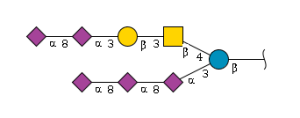
term (main_entry) : GP1c
glycan_dictionary_accession : GSD000095
glytoucan_accession : G93805MV
term_in_sentence : n this report, we describe an efficient convergent synthesis of the GP1c glycolipid epitope, which is one of the most complex c-series gangliosides. [PMID:[https://pubmed.ncbi.nlm.nih.gov/[https://pubmed.ncbi.nlm.nih.gov/[https://pubmed.ncbi.nlm.nih.gov/[https://pubmed.ncbi.nlm.nih.gov/19053458 19053458 19053458] [https://pubmed.ncbi.nlm.nih.gov/19053458 19053458 19053458]] [https://pubmed.ncbi.nlm.nih.gov/[https://pubmed.ncbi.nlm.nih.gov/19053458 19053458 19053458] [https://pubmed.ncbi.nlm.nih.gov/19053458 19053458 19053458]]] [https://pubmed.ncbi.nlm.nih.gov/[https://pubmed.ncbi.nlm.nih.gov/[https://pubmed.ncbi.nlm.nih.gov/19053458 19053458 19053458] [https://pubmed.ncbi.nlm.nih.gov/19053458 19053458 19053458]] [https://pubmed.ncbi.nlm.nih.gov/[https://pubmed.ncbi.nlm.nih.gov/19053458 19053458 19053458] [https://pubmed.ncbi.nlm.nih.gov/19053458 19053458 19053458]]]]]
publication : [https://pubmed.ncbi.nlm.nih.gov/[https://pubmed.ncbi.nlm.nih.gov/[https://pubmed.ncbi.nlm.nih.gov/[https://pubmed.ncbi.nlm.nih.gov/[https://pubmed.ncbi.nlm.nih.gov/1606358 1606358 1606358] [https://pubmed.ncbi.nlm.nih.gov/1606358 1606358 1606358]] [https://pubmed.ncbi.nlm.nih.gov/[https://pubmed.ncbi.nlm.nih.gov/1606358 1606358 1606358] [https://pubmed.ncbi.nlm.nih.gov/1606358 1606358 1606358]]] [https://pubmed.ncbi.nlm.nih.gov/[https://pubmed.ncbi.nlm.nih.gov/[https://pubmed.ncbi.nlm.nih.gov/1606358 1606358 1606358] [https://pubmed.ncbi.nlm.nih.gov/1606358 1606358 1606358]] [https://pubmed.ncbi.nlm.nih.gov/[https://pubmed.ncbi.nlm.nih.gov/1606358 1606358 1606358] [https://pubmed.ncbi.nlm.nih.gov/1606358 1606358 1606358]]]] [https://pubmed.ncbi.nlm.nih.gov/[https://pubmed.ncbi.nlm.nih.gov/[https://pubmed.ncbi.nlm.nih.gov/[https://pubmed.ncbi.nlm.nih.gov/1606358 1606358 1606358] [https://pubmed.ncbi.nlm.nih.gov/1606358 1606358 1606358]] [https://pubmed.ncbi.nlm.nih.gov/[https://pubmed.ncbi.nlm.nih.gov/1606358 1606358 1606358] [https://pubmed.ncbi.nlm.nih.gov/1606358 1606358 1606358]]] [https://pubmed.ncbi.nlm.nih.gov/[https://pubmed.ncbi.nlm.nih.gov/[https://pubmed.ncbi.nlm.nih.gov/1606358 1606358 1606358] [https://pubmed.ncbi.nlm.nih.gov/1606358 1606358 1606358]] [https://pubmed.ncbi.nlm.nih.gov/[https://pubmed.ncbi.nlm.nih.gov/1606358 1606358 1606358] [https://pubmed.ncbi.nlm.nih.gov/1606358 1606358 1606358]]]]]|[https://pubmed.ncbi.nlm.nih.gov/[https://pubmed.ncbi.nlm.nih.gov/[https://pubmed.ncbi.nlm.nih.gov/[https://pubmed.ncbi.nlm.nih.gov/19053458 19053458 19053458] [https://pubmed.ncbi.nlm.nih.gov/19053458 19053458 19053458]] [https://pubmed.ncbi.nlm.nih.gov/[https://pubmed.ncbi.nlm.nih.gov/19053458 19053458 19053458] [https://pubmed.ncbi.nlm.nih.gov/19053458 19053458 19053458]]] [https://pubmed.ncbi.nlm.nih.gov/[https://pubmed.ncbi.nlm.nih.gov/[https://pubmed.ncbi.nlm.nih.gov/19053458 19053458 19053458] [https://pubmed.ncbi.nlm.nih.gov/19053458 19053458 19053458]] [https://pubmed.ncbi.nlm.nih.gov/[https://pubmed.ncbi.nlm.nih.gov/19053458 19053458 19053458] [https://pubmed.ncbi.nlm.nih.gov/19053458 19053458 19053458]]]]|[https://pubmed.ncbi.nlm.nih.gov/[https://pubmed.ncbi.nlm.nih.gov/[https://pubmed.ncbi.nlm.nih.gov/[https://pubmed.ncbi.nlm.nih.gov/[https://pubmed.ncbi.nlm.nih.gov/1695858 1695858 1695858] [https://pubmed.ncbi.nlm.nih.gov/1695858 1695858 1695858]] [https://pubmed.ncbi.nlm.nih.gov/[https://pubmed.ncbi.nlm.nih.gov/1695858 1695858 1695858] [https://pubmed.ncbi.nlm.nih.gov/1695858 1695858 1695858]]] [https://pubmed.ncbi.nlm.nih.gov/[https://pubmed.ncbi.nlm.nih.gov/[https://pubmed.ncbi.nlm.nih.gov/1695858 1695858 1695858] [https://pubmed.ncbi.nlm.nih.gov/1695858 1695858 1695858]] [https://pubmed.ncbi.nlm.nih.gov/[https://pubmed.ncbi.nlm.nih.gov/1695858 1695858 1695858] [https://pubmed.ncbi.nlm.nih.gov/1695858 1695858 1695858]]]] [https://pubmed.ncbi.nlm.nih.gov/[https://pubmed.ncbi.nlm.nih.gov/[https://pubmed.ncbi.nlm.nih.gov/[https://pubmed.ncbi.nlm.nih.gov/1695858 1695858 1695858] [https://pubmed.ncbi.nlm.nih.gov/1695858 1695858 1695858]] [https://pubmed.ncbi.nlm.nih.gov/[https://pubmed.ncbi.nlm.nih.gov/1695858 1695858 1695858] [https://pubmed.ncbi.nlm.nih.gov/1695858 1695858 1695858]]] [https://pubmed.ncbi.nlm.nih.gov/[https://pubmed.ncbi.nlm.nih.gov/[https://pubmed.ncbi.nlm.nih.gov/1695858 1695858 1695858] [https://pubmed.ncbi.nlm.nih.gov/1695858 1695858 1695858]] [https://pubmed.ncbi.nlm.nih.gov/[https://pubmed.ncbi.nlm.nih.gov/1695858 1695858 1695858] [https://pubmed.ncbi.nlm.nih.gov/1695858 1695858 1695858]]]]]|[https://pubmed.ncbi.nlm.nih.gov/[https://pubmed.ncbi.nlm.nih.gov/4091974 4091974 4091974] [https://pubmed.ncbi.nlm.nih.gov/4091974 4091974 4091974]]|[https://pubmed.ncbi.nlm.nih.gov/[https://pubmed.ncbi.nlm.nih.gov/[https://pubmed.ncbi.nlm.nih.gov/[https://pubmed.ncbi.nlm.nih.gov/10775425 10775425 10775425] [https://pubmed.ncbi.nlm.nih.gov/10775425 10775425 10775425]] [https://pubmed.ncbi.nlm.nih.gov/[https://pubmed.ncbi.nlm.nih.gov/10775425 10775425 10775425] [https://pubmed.ncbi.nlm.nih.gov/10775425 10775425 10775425]]] [https://pubmed.ncbi.nlm.nih.gov/[https://pubmed.ncbi.nlm.nih.gov/[https://pubmed.ncbi.nlm.nih.gov/10775425 10775425 10775425] [https://pubmed.ncbi.nlm.nih.gov/10775425 10775425 10775425]] [https://pubmed.ncbi.nlm.nih.gov/[https://pubmed.ncbi.nlm.nih.gov/10775425 10775425 10775425] [https://pubmed.ncbi.nlm.nih.gov/10775425 10775425 10775425]]]]|[https://pubmed.ncbi.nlm.nih.gov/[https://pubmed.ncbi.nlm.nih.gov/[https://pubmed.ncbi.nlm.nih.gov/[https://pubmed.ncbi.nlm.nih.gov/[https://pubmed.ncbi.nlm.nih.gov/2468656 2468656 2468656] [https://pubmed.ncbi.nlm.nih.gov/2468656 2468656 2468656]] [https://pubmed.ncbi.nlm.nih.gov/[https://pubmed.ncbi.nlm.nih.gov/2468656 2468656 2468656] [https://pubmed.ncbi.nlm.nih.gov/2468656 2468656 2468656]]] [https://pubmed.ncbi.nlm.nih.gov/[https://pubmed.ncbi.nlm.nih.gov/[https://pubmed.ncbi.nlm.nih.gov/2468656 2468656 2468656] [https://pubmed.ncbi.nlm.nih.gov/2468656 2468656 2468656]] [https://pubmed.ncbi.nlm.nih.gov/[https://pubmed.ncbi.nlm.nih.gov/2468656 2468656 2468656] [https://pubmed.ncbi.nlm.nih.gov/2468656 2468656 2468656]]]] [https://pubmed.ncbi.nlm.nih.gov/[https://pubmed.ncbi.nlm.nih.gov/[https://pubmed.ncbi.nlm.nih.gov/[https://pubmed.ncbi.nlm.nih.gov/2468656 2468656 2468656] [https://pubmed.ncbi.nlm.nih.gov/2468656 2468656 2468656]] [https://pubmed.ncbi.nlm.nih.gov/[https://pubmed.ncbi.nlm.nih.gov/2468656 2468656 2468656] [https://pubmed.ncbi.nlm.nih.gov/2468656 2468656 2468656]]] [https://pubmed.ncbi.nlm.nih.gov/[https://pubmed.ncbi.nlm.nih.gov/[https://pubmed.ncbi.nlm.nih.gov/2468656 2468656 2468656] [https://pubmed.ncbi.nlm.nih.gov/2468656 2468656 2468656]] [https://pubmed.ncbi.nlm.nih.gov/[https://pubmed.ncbi.nlm.nih.gov/2468656 2468656 2468656] [https://pubmed.ncbi.nlm.nih.gov/2468656 2468656 2468656]]]]]|[https://pubmed.ncbi.nlm.nih.gov/[https://pubmed.ncbi.nlm.nih.gov/[https://pubmed.ncbi.nlm.nih.gov/2299350 2299350 2299350] [https://pubmed.ncbi.nlm.nih.gov/2299350 2299350 2299350]] [https://pubmed.ncbi.nlm.nih.gov/[https://pubmed.ncbi.nlm.nih.gov/2299350 2299350 2299350] [https://pubmed.ncbi.nlm.nih.gov/2299350 2299350 2299350]]]|[https://pubmed.ncbi.nlm.nih.gov/[https://pubmed.ncbi.nlm.nih.gov/[https://pubmed.ncbi.nlm.nih.gov/[https://pubmed.ncbi.nlm.nih.gov/3064875 3064875 3064875] [https://pubmed.ncbi.nlm.nih.gov/3064875 3064875 3064875]] [https://pubmed.ncbi.nlm.nih.gov/[https://pubmed.ncbi.nlm.nih.gov/3064875 3064875 3064875] [https://pubmed.ncbi.nlm.nih.gov/3064875 3064875 3064875]]] [https://pubmed.ncbi.nlm.nih.gov/[https://pubmed.ncbi.nlm.nih.gov/[https://pubmed.ncbi.nlm.nih.gov/3064875 3064875 3064875] [https://pubmed.ncbi.nlm.nih.gov/3064875 3064875 3064875]] [https://pubmed.ncbi.nlm.nih.gov/[https://pubmed.ncbi.nlm.nih.gov/3064875 3064875 3064875] [https://pubmed.ncbi.nlm.nih.gov/3064875 3064875 3064875]]]]|[https://pubmed.ncbi.nlm.nih.gov/[https://pubmed.ncbi.nlm.nih.gov/11432974 11432974 11432974] [https://pubmed.ncbi.nlm.nih.gov/11432974 11432974 11432974]]|[https://pubmed.ncbi.nlm.nih.gov/[https://pubmed.ncbi.nlm.nih.gov/[https://pubmed.ncbi.nlm.nih.gov/[https://pubmed.ncbi.nlm.nih.gov/9613831 9613831 9613831] [https://pubmed.ncbi.nlm.nih.gov/9613831 9613831 9613831]] [https://pubmed.ncbi.nlm.nih.gov/[https://pubmed.ncbi.nlm.nih.gov/9613831 9613831 9613831] [https://pubmed.ncbi.nlm.nih.gov/9613831 9613831 9613831]]] [https://pubmed.ncbi.nlm.nih.gov/[https://pubmed.ncbi.nlm.nih.gov/[https://pubmed.ncbi.nlm.nih.gov/9613831 9613831 9613831] [https://pubmed.ncbi.nlm.nih.gov/9613831 9613831 9613831]] [https://pubmed.ncbi.nlm.nih.gov/[https://pubmed.ncbi.nlm.nih.gov/9613831 9613831 9613831] [https://pubmed.ncbi.nlm.nih.gov/9613831 9613831 9613831]]]]|[https://pubmed.ncbi.nlm.nih.gov/[https://pubmed.ncbi.nlm.nih.gov/[https://pubmed.ncbi.nlm.nih.gov/[https://pubmed.ncbi.nlm.nih.gov/11831845 11831845 11831845] [https://pubmed.ncbi.nlm.nih.gov/11831845 11831845 11831845]] [https://pubmed.ncbi.nlm.nih.gov/[https://pubmed.ncbi.nlm.nih.gov/11831845 11831845 11831845] [https://pubmed.ncbi.nlm.nih.gov/11831845 11831845 11831845]]] [https://pubmed.ncbi.nlm.nih.gov/[https://pubmed.ncbi.nlm.nih.gov/[https://pubmed.ncbi.nlm.nih.gov/11831845 11831845 11831845] [https://pubmed.ncbi.nlm.nih.gov/11831845 11831845 11831845]] [https://pubmed.ncbi.nlm.nih.gov/[https://pubmed.ncbi.nlm.nih.gov/11831845 11831845 11831845] [https://pubmed.ncbi.nlm.nih.gov/11831845 11831845 11831845]]]]|[https://pubmed.ncbi.nlm.nih.gov/[https://pubmed.ncbi.nlm.nih.gov/1879553 1879553 1879553] [https://pubmed.ncbi.nlm.nih.gov/1879553 1879553 1879553]]|[https://pubmed.ncbi.nlm.nih.gov/[https://pubmed.ncbi.nlm.nih.gov/[https://pubmed.ncbi.nlm.nih.gov/[https://pubmed.ncbi.nlm.nih.gov/10699494 10699494 10699494] [https://pubmed.ncbi.nlm.nih.gov/10699494 10699494 10699494]] [https://pubmed.ncbi.nlm.nih.gov/[https://pubmed.ncbi.nlm.nih.gov/10699494 10699494 10699494] [https://pubmed.ncbi.nlm.nih.gov/10699494 10699494 10699494]]] [https://pubmed.ncbi.nlm.nih.gov/[https://pubmed.ncbi.nlm.nih.gov/[https://pubmed.ncbi.nlm.nih.gov/10699494 10699494 10699494] [https://pubmed.ncbi.nlm.nih.gov/10699494 10699494 10699494]] [https://pubmed.ncbi.nlm.nih.gov/[https://pubmed.ncbi.nlm.nih.gov/10699494 10699494 10699494] [https://pubmed.ncbi.nlm.nih.gov/10699494 10699494 10699494]]]]|[https://pubmed.ncbi.nlm.nih.gov/[https://pubmed.ncbi.nlm.nih.gov/8969459 8969459 8969459] [https://pubmed.ncbi.nlm.nih.gov/8969459 8969459 8969459]]|[https://pubmed.ncbi.nlm.nih.gov/[https://pubmed.ncbi.nlm.nih.gov/[https://pubmed.ncbi.nlm.nih.gov/[https://pubmed.ncbi.nlm.nih.gov/8474578 8474578 8474578] [https://pubmed.ncbi.nlm.nih.gov/8474578 8474578 8474578]] [https://pubmed.ncbi.nlm.nih.gov/[https://pubmed.ncbi.nlm.nih.gov/8474578 8474578 8474578] [https://pubmed.ncbi.nlm.nih.gov/8474578 8474578 8474578]]] [https://pubmed.ncbi.nlm.nih.gov/[https://pubmed.ncbi.nlm.nih.gov/[https://pubmed.ncbi.nlm.nih.gov/8474578 8474578 8474578] [https://pubmed.ncbi.nlm.nih.gov/8474578 8474578 8474578]] [https://pubmed.ncbi.nlm.nih.gov/[https://pubmed.ncbi.nlm.nih.gov/8474578 8474578 8474578] [https://pubmed.ncbi.nlm.nih.gov/8474578 8474578 8474578]]]]|[https://pubmed.ncbi.nlm.nih.gov/[https://pubmed.ncbi.nlm.nih.gov/[https://pubmed.ncbi.nlm.nih.gov/12031286 12031286 12031286] [https://pubmed.ncbi.nlm.nih.gov/12031286 12031286 12031286]] [https://pubmed.ncbi.nlm.nih.gov/[https://pubmed.ncbi.nlm.nih.gov/12031286 12031286 12031286] [https://pubmed.ncbi.nlm.nih.gov/12031286 12031286 12031286]]]|[https://pubmed.ncbi.nlm.nih.gov/[https://pubmed.ncbi.nlm.nih.gov/1304332 1304332 1304332] [https://pubmed.ncbi.nlm.nih.gov/1304332 1304332 1304332]]|[https://pubmed.ncbi.nlm.nih.gov/[https://pubmed.ncbi.nlm.nih.gov/[https://pubmed.ncbi.nlm.nih.gov/9153001 9153001 9153001] [https://pubmed.ncbi.nlm.nih.gov/9153001 9153001 9153001]] [https://pubmed.ncbi.nlm.nih.gov/[https://pubmed.ncbi.nlm.nih.gov/9153001 9153001 9153001] [https://pubmed.ncbi.nlm.nih.gov/9153001 9153001 9153001]]]|[https://pubmed.ncbi.nlm.nih.gov/[https://pubmed.ncbi.nlm.nih.gov/[https://pubmed.ncbi.nlm.nih.gov/[https://pubmed.ncbi.nlm.nih.gov/10564776 10564776 10564776] [https://pubmed.ncbi.nlm.nih.gov/10564776 10564776 10564776]] [https://pubmed.ncbi.nlm.nih.gov/[https://pubmed.ncbi.nlm.nih.gov/10564776 10564776 10564776] [https://pubmed.ncbi.nlm.nih.gov/10564776 10564776 10564776]]] [https://pubmed.ncbi.nlm.nih.gov/[https://pubmed.ncbi.nlm.nih.gov/[https://pubmed.ncbi.nlm.nih.gov/10564776 10564776 10564776] [https://pubmed.ncbi.nlm.nih.gov/10564776 10564776 10564776]] [https://pubmed.ncbi.nlm.nih.gov/[https://pubmed.ncbi.nlm.nih.gov/10564776 10564776 10564776] [https://pubmed.ncbi.nlm.nih.gov/10564776 10564776 10564776]]]]
definition :
term_xref : GlycoMotif:GGM.000118|GTC:G93805MV
synonyms :
function :
disease_associations :
wikipedia :
essentials_of_glycobiology : Chapter 11|Chapter 14|Chapter 27|Chapter 35|Chapter 45 |Chapter 47|Chapter 49
GQ1b
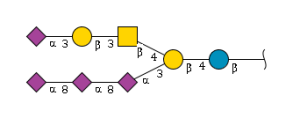
term (main_entry) : GQ1b
glycan_dictionary_accession : GSD000096
glytoucan_accession : G18625KA
term_in_sentence : Bilateral infusion of GQ1b into the hippocampus ameliorates cognitive deficits in the triple-transgenic AD mouse model (3xTg-AD).[PMID:[https://pubmed.ncbi.nlm.nih.gov/[https://pubmed.ncbi.nlm.nih.gov/[https://pubmed.ncbi.nlm.nih.gov/[https://pubmed.ncbi.nlm.nih.gov/31186474 31186474 31186474] [https://pubmed.ncbi.nlm.nih.gov/31186474 31186474 31186474]] [https://pubmed.ncbi.nlm.nih.gov/[https://pubmed.ncbi.nlm.nih.gov/31186474 31186474 31186474] [https://pubmed.ncbi.nlm.nih.gov/31186474 31186474 31186474]]] [https://pubmed.ncbi.nlm.nih.gov/[https://pubmed.ncbi.nlm.nih.gov/[https://pubmed.ncbi.nlm.nih.gov/31186474 31186474 31186474] [https://pubmed.ncbi.nlm.nih.gov/31186474 31186474 31186474]] [https://pubmed.ncbi.nlm.nih.gov/[https://pubmed.ncbi.nlm.nih.gov/31186474 31186474 31186474] [https://pubmed.ncbi.nlm.nih.gov/31186474 31186474 31186474]]]]]
publication : [https://pubmed.ncbi.nlm.nih.gov/[https://pubmed.ncbi.nlm.nih.gov/30798387 30798387 30798387] [https://pubmed.ncbi.nlm.nih.gov/30798387 30798387 30798387]]|[https://pubmed.ncbi.nlm.nih.gov/[https://pubmed.ncbi.nlm.nih.gov/[https://pubmed.ncbi.nlm.nih.gov/[https://pubmed.ncbi.nlm.nih.gov/31186474 31186474 31186474] [https://pubmed.ncbi.nlm.nih.gov/31186474 31186474 31186474]] [https://pubmed.ncbi.nlm.nih.gov/[https://pubmed.ncbi.nlm.nih.gov/31186474 31186474 31186474] [https://pubmed.ncbi.nlm.nih.gov/31186474 31186474 31186474]]] [https://pubmed.ncbi.nlm.nih.gov/[https://pubmed.ncbi.nlm.nih.gov/[https://pubmed.ncbi.nlm.nih.gov/31186474 31186474 31186474] [https://pubmed.ncbi.nlm.nih.gov/31186474 31186474 31186474]] [https://pubmed.ncbi.nlm.nih.gov/[https://pubmed.ncbi.nlm.nih.gov/31186474 31186474 31186474] [https://pubmed.ncbi.nlm.nih.gov/31186474 31186474 31186474]]]]|[https://pubmed.ncbi.nlm.nih.gov/[https://pubmed.ncbi.nlm.nih.gov/26704905 26704905 26704905] [https://pubmed.ncbi.nlm.nih.gov/26704905 26704905 26704905]]|[https://pubmed.ncbi.nlm.nih.gov/[https://pubmed.ncbi.nlm.nih.gov/23677659 23677659 23677659] [https://pubmed.ncbi.nlm.nih.gov/23677659 23677659 23677659]]|[https://pubmed.ncbi.nlm.nih.gov/[https://pubmed.ncbi.nlm.nih.gov/26984947 26984947 26984947] [https://pubmed.ncbi.nlm.nih.gov/26984947 26984947 26984947]]|[https://pubmed.ncbi.nlm.nih.gov/[https://pubmed.ncbi.nlm.nih.gov/24184316 24184316 24184316] [https://pubmed.ncbi.nlm.nih.gov/24184316 24184316 24184316]]|[https://pubmed.ncbi.nlm.nih.gov/[https://pubmed.ncbi.nlm.nih.gov/[https://pubmed.ncbi.nlm.nih.gov/23804237 23804237 23804237] [https://pubmed.ncbi.nlm.nih.gov/23804237 23804237 23804237]] [https://pubmed.ncbi.nlm.nih.gov/[https://pubmed.ncbi.nlm.nih.gov/23804237 23804237 23804237] [https://pubmed.ncbi.nlm.nih.gov/23804237 23804237 23804237]]]|[https://pubmed.ncbi.nlm.nih.gov/[https://pubmed.ncbi.nlm.nih.gov/9819299 9819299 9819299] [https://pubmed.ncbi.nlm.nih.gov/9819299 9819299 9819299]]|[https://pubmed.ncbi.nlm.nih.gov/[https://pubmed.ncbi.nlm.nih.gov/18514410 18514410 18514410] [https://pubmed.ncbi.nlm.nih.gov/18514410 18514410 18514410]]|[https://pubmed.ncbi.nlm.nih.gov/[https://pubmed.ncbi.nlm.nih.gov/22189683 22189683 22189683] [https://pubmed.ncbi.nlm.nih.gov/22189683 22189683 22189683]]|[https://pubmed.ncbi.nlm.nih.gov/[https://pubmed.ncbi.nlm.nih.gov/24859332 24859332 24859332] [https://pubmed.ncbi.nlm.nih.gov/24859332 24859332 24859332]]
definition : An amino oligosaccharide that is a branched octasaccharide derivative consisting of four sialyl residues, two galactose residues, one N-acetylglucosamine and a glucose residue at the reducing end.[CHEBI:59212]
term_xref : GlycoMotif:GGM.000115|GTC:G18625KA|GlycoEpitope:EP0069|CID:45266843|KEGG:G00117|CHEBI:59212
synonyms :
function :
disease_associations :
wikipedia :
essentials_of_glycobiology : Chapter 11
GQ1ba
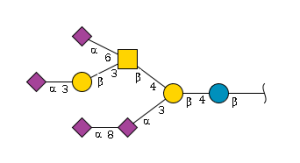
term (main_entry) : GQ1ba
glycan_dictionary_accession : GSD000097
glytoucan_accession : G54733XO
term_in_sentence : A few studies have reported the association of autoantibodies to GM1 or GQ1bα with Alzheimer's disease (AD) or vascular dementia.[PMID:[https://pubmed.ncbi.nlm.nih.gov/[https://pubmed.ncbi.nlm.nih.gov/[https://pubmed.ncbi.nlm.nih.gov/[https://pubmed.ncbi.nlm.nih.gov/25024341 25024341 25024341] [https://pubmed.ncbi.nlm.nih.gov/25024341 25024341 25024341]] [https://pubmed.ncbi.nlm.nih.gov/[https://pubmed.ncbi.nlm.nih.gov/25024341 25024341 25024341] [https://pubmed.ncbi.nlm.nih.gov/25024341 25024341 25024341]]] [https://pubmed.ncbi.nlm.nih.gov/[https://pubmed.ncbi.nlm.nih.gov/[https://pubmed.ncbi.nlm.nih.gov/25024341 25024341 25024341] [https://pubmed.ncbi.nlm.nih.gov/25024341 25024341 25024341]] [https://pubmed.ncbi.nlm.nih.gov/[https://pubmed.ncbi.nlm.nih.gov/25024341 25024341 25024341] [https://pubmed.ncbi.nlm.nih.gov/25024341 25024341 25024341]]]]]
publication : [https://pubmed.ncbi.nlm.nih.gov/[https://pubmed.ncbi.nlm.nih.gov/[https://pubmed.ncbi.nlm.nih.gov/[https://pubmed.ncbi.nlm.nih.gov/25024341 25024341 25024341] [https://pubmed.ncbi.nlm.nih.gov/25024341 25024341 25024341]] [https://pubmed.ncbi.nlm.nih.gov/[https://pubmed.ncbi.nlm.nih.gov/25024341 25024341 25024341] [https://pubmed.ncbi.nlm.nih.gov/25024341 25024341 25024341]]] [https://pubmed.ncbi.nlm.nih.gov/[https://pubmed.ncbi.nlm.nih.gov/[https://pubmed.ncbi.nlm.nih.gov/25024341 25024341 25024341] [https://pubmed.ncbi.nlm.nih.gov/25024341 25024341 25024341]] [https://pubmed.ncbi.nlm.nih.gov/[https://pubmed.ncbi.nlm.nih.gov/25024341 25024341 25024341] [https://pubmed.ncbi.nlm.nih.gov/25024341 25024341 25024341]]]]|[https://pubmed.ncbi.nlm.nih.gov/[https://pubmed.ncbi.nlm.nih.gov/23717411 23717411 23717411] [https://pubmed.ncbi.nlm.nih.gov/23717411 23717411 23717411]]|[https://pubmed.ncbi.nlm.nih.gov/[https://pubmed.ncbi.nlm.nih.gov/17870542 17870542 17870542] [https://pubmed.ncbi.nlm.nih.gov/17870542 17870542 17870542]]|[https://pubmed.ncbi.nlm.nih.gov/[https://pubmed.ncbi.nlm.nih.gov/10702226 10702226 10702226] [https://pubmed.ncbi.nlm.nih.gov/10702226 10702226 10702226]]|[https://pubmed.ncbi.nlm.nih.gov/[https://pubmed.ncbi.nlm.nih.gov/21137678 21137678 21137678] [https://pubmed.ncbi.nlm.nih.gov/21137678 21137678 21137678]]|[https://pubmed.ncbi.nlm.nih.gov/[https://pubmed.ncbi.nlm.nih.gov/26748510 26748510 26748510] [https://pubmed.ncbi.nlm.nih.gov/26748510 26748510 26748510]]|[https://pubmed.ncbi.nlm.nih.gov/[https://pubmed.ncbi.nlm.nih.gov/8662799 8662799 8662799] [https://pubmed.ncbi.nlm.nih.gov/8662799 8662799 8662799]]|[https://pubmed.ncbi.nlm.nih.gov/[https://pubmed.ncbi.nlm.nih.gov/21274438 21274438 21274438] [https://pubmed.ncbi.nlm.nih.gov/21274438 21274438 21274438]]|[https://pubmed.ncbi.nlm.nih.gov/[https://pubmed.ncbi.nlm.nih.gov/24649890 24649890 24649890] [https://pubmed.ncbi.nlm.nih.gov/24649890 24649890 24649890]]|[https://pubmed.ncbi.nlm.nih.gov/[https://pubmed.ncbi.nlm.nih.gov/16580208 16580208 16580208] [https://pubmed.ncbi.nlm.nih.gov/16580208 16580208 16580208]]|[https://pubmed.ncbi.nlm.nih.gov/[https://pubmed.ncbi.nlm.nih.gov/28124591 28124591 28124591] [https://pubmed.ncbi.nlm.nih.gov/28124591 28124591 28124591]]|[https://pubmed.ncbi.nlm.nih.gov/[https://pubmed.ncbi.nlm.nih.gov/20095613 20095613 20095613] [https://pubmed.ncbi.nlm.nih.gov/20095613 20095613 20095613]]|[https://pubmed.ncbi.nlm.nih.gov/[https://pubmed.ncbi.nlm.nih.gov/17507233 17507233 17507233] [https://pubmed.ncbi.nlm.nih.gov/17507233 17507233 17507233]]|[https://pubmed.ncbi.nlm.nih.gov/[https://pubmed.ncbi.nlm.nih.gov/23565921 23565921 23565921] [https://pubmed.ncbi.nlm.nih.gov/23565921 23565921 23565921]]|[https://pubmed.ncbi.nlm.nih.gov/[https://pubmed.ncbi.nlm.nih.gov/14505645 14505645 14505645] [https://pubmed.ncbi.nlm.nih.gov/14505645 14505645 14505645]]|[https://pubmed.ncbi.nlm.nih.gov/[https://pubmed.ncbi.nlm.nih.gov/20930939 20930939 20930939] [https://pubmed.ncbi.nlm.nih.gov/20930939 20930939 20930939]]|[https://pubmed.ncbi.nlm.nih.gov/[https://pubmed.ncbi.nlm.nih.gov/9201997 9201997 9201997] [https://pubmed.ncbi.nlm.nih.gov/9201997 9201997 9201997]]
definition :
term_xref : GlycoMotif:GGM.000116|GTC:G54733XO
synonyms : GQ1balpha
function :
disease_associations :
wikipedia :
essentials_of_glycobiology :
GQ1c
term (main_entry) : GQ1c
glycan_dictionary_accession : GSD000098
glytoucan_accession : G99524KA
term_in_sentence : The neural specific monoclonal antibody A2B5 was found to interact with GQ1c but not with Gq1b, nor did it interact with other glycolipids such as GM1, GD1a, GD1b, GT1a, GT1b and GA1.[PMID: [https://pubmed.ncbi.nlm.nih.gov/[https://pubmed.ncbi.nlm.nih.gov/6640289 6640289 6640289] [https://pubmed.ncbi.nlm.nih.gov/6640289 6640289 6640289]]]
publication : [https://pubmed.ncbi.nlm.nih.gov/[https://pubmed.ncbi.nlm.nih.gov/[https://pubmed.ncbi.nlm.nih.gov/6640289 6640289 6640289] [https://pubmed.ncbi.nlm.nih.gov/6640289 6640289 6640289]] [https://pubmed.ncbi.nlm.nih.gov/[https://pubmed.ncbi.nlm.nih.gov/6640289 6640289 6640289] [https://pubmed.ncbi.nlm.nih.gov/6640289 6640289 6640289]]]|[https://pubmed.ncbi.nlm.nih.gov/[https://pubmed.ncbi.nlm.nih.gov/[https://pubmed.ncbi.nlm.nih.gov/[https://pubmed.ncbi.nlm.nih.gov/[https://pubmed.ncbi.nlm.nih.gov/1695858 1695858 1695858] [https://pubmed.ncbi.nlm.nih.gov/1695858 1695858 1695858]] [https://pubmed.ncbi.nlm.nih.gov/[https://pubmed.ncbi.nlm.nih.gov/1695858 1695858 1695858] [https://pubmed.ncbi.nlm.nih.gov/1695858 1695858 1695858]]] [https://pubmed.ncbi.nlm.nih.gov/[https://pubmed.ncbi.nlm.nih.gov/[https://pubmed.ncbi.nlm.nih.gov/1695858 1695858 1695858] [https://pubmed.ncbi.nlm.nih.gov/1695858 1695858 1695858]] [https://pubmed.ncbi.nlm.nih.gov/[https://pubmed.ncbi.nlm.nih.gov/1695858 1695858 1695858] [https://pubmed.ncbi.nlm.nih.gov/1695858 1695858 1695858]]]] [https://pubmed.ncbi.nlm.nih.gov/[https://pubmed.ncbi.nlm.nih.gov/[https://pubmed.ncbi.nlm.nih.gov/[https://pubmed.ncbi.nlm.nih.gov/1695858 1695858 1695858] [https://pubmed.ncbi.nlm.nih.gov/1695858 1695858 1695858]] [https://pubmed.ncbi.nlm.nih.gov/[https://pubmed.ncbi.nlm.nih.gov/1695858 1695858 1695858] [https://pubmed.ncbi.nlm.nih.gov/1695858 1695858 1695858]]] [https://pubmed.ncbi.nlm.nih.gov/[https://pubmed.ncbi.nlm.nih.gov/[https://pubmed.ncbi.nlm.nih.gov/1695858 1695858 1695858] [https://pubmed.ncbi.nlm.nih.gov/1695858 1695858 1695858]] [https://pubmed.ncbi.nlm.nih.gov/[https://pubmed.ncbi.nlm.nih.gov/1695858 1695858 1695858] [https://pubmed.ncbi.nlm.nih.gov/1695858 1695858 1695858]]]]]|[https://pubmed.ncbi.nlm.nih.gov/[https://pubmed.ncbi.nlm.nih.gov/[https://pubmed.ncbi.nlm.nih.gov/7798936 7798936 7798936] [https://pubmed.ncbi.nlm.nih.gov/7798936 7798936 7798936]] [https://pubmed.ncbi.nlm.nih.gov/[https://pubmed.ncbi.nlm.nih.gov/7798936 7798936 7798936] [https://pubmed.ncbi.nlm.nih.gov/7798936 7798936 7798936]]]|[https://pubmed.ncbi.nlm.nih.gov/[https://pubmed.ncbi.nlm.nih.gov/1729139 1729139 1729139] [https://pubmed.ncbi.nlm.nih.gov/1729139 1729139 1729139]]|[https://pubmed.ncbi.nlm.nih.gov/[https://pubmed.ncbi.nlm.nih.gov/[https://pubmed.ncbi.nlm.nih.gov/[https://pubmed.ncbi.nlm.nih.gov/[https://pubmed.ncbi.nlm.nih.gov/2468656 2468656 2468656] [https://pubmed.ncbi.nlm.nih.gov/2468656 2468656 2468656]] [https://pubmed.ncbi.nlm.nih.gov/[https://pubmed.ncbi.nlm.nih.gov/2468656 2468656 2468656] [https://pubmed.ncbi.nlm.nih.gov/2468656 2468656 2468656]]] [https://pubmed.ncbi.nlm.nih.gov/[https://pubmed.ncbi.nlm.nih.gov/[https://pubmed.ncbi.nlm.nih.gov/2468656 2468656 2468656] [https://pubmed.ncbi.nlm.nih.gov/2468656 2468656 2468656]] [https://pubmed.ncbi.nlm.nih.gov/[https://pubmed.ncbi.nlm.nih.gov/2468656 2468656 2468656] [https://pubmed.ncbi.nlm.nih.gov/2468656 2468656 2468656]]]] [https://pubmed.ncbi.nlm.nih.gov/[https://pubmed.ncbi.nlm.nih.gov/[https://pubmed.ncbi.nlm.nih.gov/[https://pubmed.ncbi.nlm.nih.gov/2468656 2468656 2468656] [https://pubmed.ncbi.nlm.nih.gov/2468656 2468656 2468656]] [https://pubmed.ncbi.nlm.nih.gov/[https://pubmed.ncbi.nlm.nih.gov/2468656 2468656 2468656] [https://pubmed.ncbi.nlm.nih.gov/2468656 2468656 2468656]]] [https://pubmed.ncbi.nlm.nih.gov/[https://pubmed.ncbi.nlm.nih.gov/[https://pubmed.ncbi.nlm.nih.gov/2468656 2468656 2468656] [https://pubmed.ncbi.nlm.nih.gov/2468656 2468656 2468656]] [https://pubmed.ncbi.nlm.nih.gov/[https://pubmed.ncbi.nlm.nih.gov/2468656 2468656 2468656] [https://pubmed.ncbi.nlm.nih.gov/2468656 2468656 2468656]]]]]|[https://pubmed.ncbi.nlm.nih.gov/[https://pubmed.ncbi.nlm.nih.gov/20368669 20368669 20368669] [https://pubmed.ncbi.nlm.nih.gov/20368669 20368669 20368669]]|[https://pubmed.ncbi.nlm.nih.gov/[https://pubmed.ncbi.nlm.nih.gov/[https://pubmed.ncbi.nlm.nih.gov/2723647 2723647 2723647] [https://pubmed.ncbi.nlm.nih.gov/2723647 2723647 2723647]] [https://pubmed.ncbi.nlm.nih.gov/[https://pubmed.ncbi.nlm.nih.gov/2723647 2723647 2723647] [https://pubmed.ncbi.nlm.nih.gov/2723647 2723647 2723647]]]|[https://pubmed.ncbi.nlm.nih.gov/[https://pubmed.ncbi.nlm.nih.gov/1814411 1814411 1814411] [https://pubmed.ncbi.nlm.nih.gov/1814411 1814411 1814411]]|[https://pubmed.ncbi.nlm.nih.gov/[https://pubmed.ncbi.nlm.nih.gov/[https://pubmed.ncbi.nlm.nih.gov/[https://pubmed.ncbi.nlm.nih.gov/3064875 3064875 3064875] [https://pubmed.ncbi.nlm.nih.gov/3064875 3064875 3064875]] [https://pubmed.ncbi.nlm.nih.gov/[https://pubmed.ncbi.nlm.nih.gov/3064875 3064875 3064875] [https://pubmed.ncbi.nlm.nih.gov/3064875 3064875 3064875]]] [https://pubmed.ncbi.nlm.nih.gov/[https://pubmed.ncbi.nlm.nih.gov/[https://pubmed.ncbi.nlm.nih.gov/3064875 3064875 3064875] [https://pubmed.ncbi.nlm.nih.gov/3064875 3064875 3064875]] [https://pubmed.ncbi.nlm.nih.gov/[https://pubmed.ncbi.nlm.nih.gov/3064875 3064875 3064875] [https://pubmed.ncbi.nlm.nih.gov/3064875 3064875 3064875]]]]|[https://pubmed.ncbi.nlm.nih.gov/[https://pubmed.ncbi.nlm.nih.gov/6085330 6085330 6085330] [https://pubmed.ncbi.nlm.nih.gov/6085330 6085330 6085330]]|[https://pubmed.ncbi.nlm.nih.gov/[https://pubmed.ncbi.nlm.nih.gov/[https://pubmed.ncbi.nlm.nih.gov/1613492 1613492 1613492] [https://pubmed.ncbi.nlm.nih.gov/1613492 1613492 1613492]] [https://pubmed.ncbi.nlm.nih.gov/[https://pubmed.ncbi.nlm.nih.gov/1613492 1613492 1613492] [https://pubmed.ncbi.nlm.nih.gov/1613492 1613492 1613492]]]|[https://pubmed.ncbi.nlm.nih.gov/[https://pubmed.ncbi.nlm.nih.gov/17883393 17883393 17883393] [https://pubmed.ncbi.nlm.nih.gov/17883393 17883393 17883393]]|[https://pubmed.ncbi.nlm.nih.gov/[https://pubmed.ncbi.nlm.nih.gov/[https://pubmed.ncbi.nlm.nih.gov/[https://pubmed.ncbi.nlm.nih.gov/11831845 11831845 11831845] [https://pubmed.ncbi.nlm.nih.gov/11831845 11831845 11831845]] [https://pubmed.ncbi.nlm.nih.gov/[https://pubmed.ncbi.nlm.nih.gov/11831845 11831845 11831845] [https://pubmed.ncbi.nlm.nih.gov/11831845 11831845 11831845]]] [https://pubmed.ncbi.nlm.nih.gov/[https://pubmed.ncbi.nlm.nih.gov/[https://pubmed.ncbi.nlm.nih.gov/11831845 11831845 11831845] [https://pubmed.ncbi.nlm.nih.gov/11831845 11831845 11831845]] [https://pubmed.ncbi.nlm.nih.gov/[https://pubmed.ncbi.nlm.nih.gov/11831845 11831845 11831845] [https://pubmed.ncbi.nlm.nih.gov/11831845 11831845 11831845]]]]|[https://pubmed.ncbi.nlm.nih.gov/[https://pubmed.ncbi.nlm.nih.gov/[https://pubmed.ncbi.nlm.nih.gov/[https://pubmed.ncbi.nlm.nih.gov/10775425 10775425 10775425] [https://pubmed.ncbi.nlm.nih.gov/10775425 10775425 10775425]] [https://pubmed.ncbi.nlm.nih.gov/[https://pubmed.ncbi.nlm.nih.gov/10775425 10775425 10775425] [https://pubmed.ncbi.nlm.nih.gov/10775425 10775425 10775425]]] [https://pubmed.ncbi.nlm.nih.gov/[https://pubmed.ncbi.nlm.nih.gov/[https://pubmed.ncbi.nlm.nih.gov/10775425 10775425 10775425] [https://pubmed.ncbi.nlm.nih.gov/10775425 10775425 10775425]] [https://pubmed.ncbi.nlm.nih.gov/[https://pubmed.ncbi.nlm.nih.gov/10775425 10775425 10775425] [https://pubmed.ncbi.nlm.nih.gov/10775425 10775425 10775425]]]]|[https://pubmed.ncbi.nlm.nih.gov/[https://pubmed.ncbi.nlm.nih.gov/8219015 8219015 8219015] [https://pubmed.ncbi.nlm.nih.gov/8219015 8219015 8219015]]|8804704|1384262|[https://pubmed.ncbi.nlm.nih.gov/7066685 7066685 7066685]|2299192|[https://pubmed.ncbi.nlm.nih.gov/[https://pubmed.ncbi.nlm.nih.gov/[https://pubmed.ncbi.nlm.nih.gov/9613831 9613831 9613831] [https://pubmed.ncbi.nlm.nih.gov/9613831 9613831 9613831]] [https://pubmed.ncbi.nlm.nih.gov/[https://pubmed.ncbi.nlm.nih.gov/9613831 9613831 9613831] [https://pubmed.ncbi.nlm.nih.gov/9613831 9613831 9613831]]]|10350354|1304337|[https://pubmed.ncbi.nlm.nih.gov/[https://pubmed.ncbi.nlm.nih.gov/9153001 9153001 9153001] [https://pubmed.ncbi.nlm.nih.gov/9153001 9153001 9153001]]|11959025|[https://pubmed.ncbi.nlm.nih.gov/[https://pubmed.ncbi.nlm.nih.gov/[https://pubmed.ncbi.nlm.nih.gov/8474578 8474578 8474578] [https://pubmed.ncbi.nlm.nih.gov/8474578 8474578 8474578]] [https://pubmed.ncbi.nlm.nih.gov/[https://pubmed.ncbi.nlm.nih.gov/8474578 8474578 8474578] [https://pubmed.ncbi.nlm.nih.gov/8474578 8474578 8474578]]]|[https://pubmed.ncbi.nlm.nih.gov/[https://pubmed.ncbi.nlm.nih.gov/2299350 2299350 2299350] [https://pubmed.ncbi.nlm.nih.gov/2299350 2299350 2299350]]|[https://pubmed.ncbi.nlm.nih.gov/[https://pubmed.ncbi.nlm.nih.gov/[https://pubmed.ncbi.nlm.nih.gov/10564776 10564776 10564776] [https://pubmed.ncbi.nlm.nih.gov/10564776 10564776 10564776]] [https://pubmed.ncbi.nlm.nih.gov/[https://pubmed.ncbi.nlm.nih.gov/10564776 10564776 10564776] [https://pubmed.ncbi.nlm.nih.gov/10564776 10564776 10564776]]]|[https://pubmed.ncbi.nlm.nih.gov/[https://pubmed.ncbi.nlm.nih.gov/[https://pubmed.ncbi.nlm.nih.gov/10699494 10699494 10699494] [https://pubmed.ncbi.nlm.nih.gov/10699494 10699494 10699494]] [https://pubmed.ncbi.nlm.nih.gov/[https://pubmed.ncbi.nlm.nih.gov/10699494 10699494 10699494] [https://pubmed.ncbi.nlm.nih.gov/10699494 10699494 10699494]]]|3942818|[https://pubmed.ncbi.nlm.nih.gov/[https://pubmed.ncbi.nlm.nih.gov/12031286 12031286 12031286] [https://pubmed.ncbi.nlm.nih.gov/12031286 12031286 12031286]]|[https://pubmed.ncbi.nlm.nih.gov/7361620 7361620 7361620]
definition : Alpha-Neu5Ac-(2->8)-alpha-Neu5Ac-(2->8)-alpha-Neu5Ac-(2->3)-[alpha-Neu5Ac-(2->3)-beta-D-Galp-(1->3)-beta-D-GalpNAc-(1->4)]-beta-D-Galp-(1->4)-beta-D-Glcp is a member of neuraminic acids and an amino octasaccharide.[CID:[https://pubmed.ncbi.nlm.nih.gov/91860352 91860352 91860352]]
term_xref : GlycoMotif:GGM.000117|GTC:G99524KA|CID:[https://pubmed.ncbi.nlm.nih.gov/91860352 91860352 91860352]|CHEBI:145645|KEGG:G00121
synonyms :
function :
disease_associations :
wikipedia :
essentials_of_glycobiology : Chapter 46
GT1a
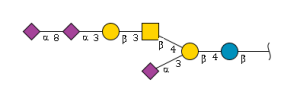
term (main_entry) : GT1a
glycan_dictionary_accession : GSD000099
glytoucan_accession : G68110IF
term_in_sentence : GT1a mimicry was found in the lipo-oligosaccharides of strain ICDCCJ07002 and ICDCCJ07004; but a combination of GM3/GD3 mimics was observed in ICDCCJ07001, although this patient had anti-GT1a IgG antibodies.[PMID:[https://pubmed.ncbi.nlm.nih.gov/26197476 26197476 26197476]]
publication : 12023422|32623212|[https://pubmed.ncbi.nlm.nih.gov/26197476 26197476 26197476]|9585812|29747820|[https://pubmed.ncbi.nlm.nih.gov/[https://pubmed.ncbi.nlm.nih.gov/23804237 23804237 23804237] [https://pubmed.ncbi.nlm.nih.gov/23804237 23804237 23804237]]|11993188|31683059|19631994|9742882|29709941|8971119|8706663|893404|31829433|[https://pubmed.ncbi.nlm.nih.gov/8910600 8910600 8910600]|30600291|29319803|26176883|29063860|6766128|31602715|29808463|30711390|29847988|30116054|28187751
definition : A branched heptasaccharide derivative consisting of three sialyl residues, two galactose residues, one N-acetylglucosamine and a glucose residue at the reducing end.[CHEBI:59215]
term_xref : CID:45266863|GlycoMotif:GGM.000110|GTC:G68110IF|GlycoEpitope:EP0066|KEGG:G00112|CHEBI:59215
synonyms :
function :
disease_associations :
wikipedia :
essentials_of_glycobiology :
GT1a alpha
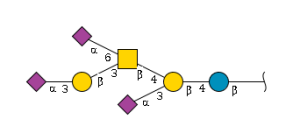
term (main_entry) : GT1a alpha
glycan_dictionary_accession : GSD000100
glytoucan_accession : G02149VR
term_in_sentence : A new class of gangliosides, GT1a alpha and GQ1b alpha, were initially identified as cholinergic neuron-specific antigens in bovine brain. [PMID:[https://pubmed.ncbi.nlm.nih.gov/8082783 8082783 8082783]]
publication : 7710562|[https://pubmed.ncbi.nlm.nih.gov/8082783 8082783 8082783]|10972137|9468624|9143254|8221098|9679279|11368158|11878808
definition :
term_xref : GlycoMotif:GGM.000111|GTC:G02149VR|GlycoEpitope:EP0111|CID:91851751|CHEBI:156678|KEGG:G00128
synonyms : GT1aa
function : GT1a alpha was a cholinerginic-specific antigen.[GlycoEpitope:EP0111]
disease_associations :
wikipedia :
essentials_of_glycobiology :
GT1b
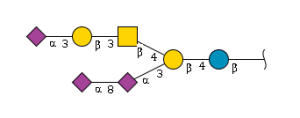
term (main_entry) : GT1b
glycan_dictionary_accession : GSD000101
glytoucan_accession : G40183QN
term_in_sentence : GT1b ganglioside is axonally transported to the spinal cord dorsal horn and contributes to characteristics of neuropathic pain such as mechanical and thermal hypersensitivity.[PMID: [https://pubmed.ncbi.nlm.nih.gov/32030804 32030804 32030804]]
publication : [https://pubmed.ncbi.nlm.nih.gov/32030804 32030804 32030804]|26370787|32046393|9712688|7636307|9931455|25520869|19605473|17188834|10233751|22735313|20540782|22746533|1861141|19490186|9521848|11921200|10731661|31431523|15274627|32726962|12573517|18277613|11370834|11234774|11123278|18704164|16291967|11411041|27549393|25253868|22720883|10686582|11511306|29904724|31472390|19156870
definition : A branched amino heptasaccharide comprising a β-D-galactosyl-(1→4)-β-D-glucose disaccharide, the galactosyl residue of which carries an N-acetyl-α-neuraminyl-(2→3)-β-D-galactosyl-(1→3)-N-acetyl-β-D-galactosaminyl trisaccharide unit and an N-acetyl-α-neuraminyl-(2→8)-N-acetyl-α-neuraminyl disaccharide unit through (2→4) and (2→3) linkages respectively. It corresponds to the carbohydrate portion of ganglioside GT1b.[CHEBI:59225]
term_xref : GlycoMotif:GGM.000112|GTC:G40183QN|GlycoEpitopeEP0067|CID:45266781|CHEBI:59225| GlycoGlycoEpitope:130680|SugarBind_Ligand:26|KEGG:G00116
synonyms :
function :
disease_associations : Toxoplasmosis[SugarBind_Ligand:26]|Lyme disease[SugarBind_Ligand:26]|Cholera[SugarBind_Ligand:26]|Botulism[SugarBind_Ligand:26]|Tetanus[SugarBind_Ligand:26]|Influenza[SugarBind_Ligand:26]
wikipedia :
essentials_of_glycobiology :
GT1c
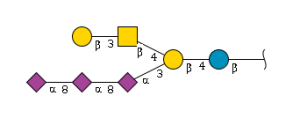
term (main_entry) : GT1c
glycan_dictionary_accession : GSD000102
glytoucan_accession : G78818SP
term_in_sentence : We show here that VVH associates with ganglioside GM1a, Fucosyl-GM1, GD1a, GT1c, and GD1b by glycan array.[PMID: [https://pubmed.ncbi.nlm.nih.gov/32228455 32228455 32228455]]
publication : 28088450|30085356|[https://pubmed.ncbi.nlm.nih.gov/32228455 32228455 32228455]|[https://pubmed.ncbi.nlm.nih.gov/[https://pubmed.ncbi.nlm.nih.gov/[https://pubmed.ncbi.nlm.nih.gov/[https://pubmed.ncbi.nlm.nih.gov/2468656 2468656 2468656] [https://pubmed.ncbi.nlm.nih.gov/2468656 2468656 2468656]] [https://pubmed.ncbi.nlm.nih.gov/[https://pubmed.ncbi.nlm.nih.gov/2468656 2468656 2468656] [https://pubmed.ncbi.nlm.nih.gov/2468656 2468656 2468656]]] [https://pubmed.ncbi.nlm.nih.gov/[https://pubmed.ncbi.nlm.nih.gov/[https://pubmed.ncbi.nlm.nih.gov/2468656 2468656 2468656] [https://pubmed.ncbi.nlm.nih.gov/2468656 2468656 2468656]] [https://pubmed.ncbi.nlm.nih.gov/[https://pubmed.ncbi.nlm.nih.gov/2468656 2468656 2468656] [https://pubmed.ncbi.nlm.nih.gov/2468656 2468656 2468656]]]]|[https://pubmed.ncbi.nlm.nih.gov/[https://pubmed.ncbi.nlm.nih.gov/19841910 19841910 19841910] [https://pubmed.ncbi.nlm.nih.gov/19841910 19841910 19841910]]|23877172|[https://pubmed.ncbi.nlm.nih.gov/[https://pubmed.ncbi.nlm.nih.gov/[https://pubmed.ncbi.nlm.nih.gov/[https://pubmed.ncbi.nlm.nih.gov/1695858 1695858 1695858] [https://pubmed.ncbi.nlm.nih.gov/1695858 1695858 1695858]] [https://pubmed.ncbi.nlm.nih.gov/[https://pubmed.ncbi.nlm.nih.gov/1695858 1695858 1695858] [https://pubmed.ncbi.nlm.nih.gov/1695858 1695858 1695858]]] [https://pubmed.ncbi.nlm.nih.gov/[https://pubmed.ncbi.nlm.nih.gov/[https://pubmed.ncbi.nlm.nih.gov/1695858 1695858 1695858] [https://pubmed.ncbi.nlm.nih.gov/1695858 1695858 1695858]] [https://pubmed.ncbi.nlm.nih.gov/[https://pubmed.ncbi.nlm.nih.gov/1695858 1695858 1695858] [https://pubmed.ncbi.nlm.nih.gov/1695858 1695858 1695858]]]]|[https://pubmed.ncbi.nlm.nih.gov/[https://pubmed.ncbi.nlm.nih.gov/[https://pubmed.ncbi.nlm.nih.gov/10564776 10564776 10564776] [https://pubmed.ncbi.nlm.nih.gov/10564776 10564776 10564776]] [https://pubmed.ncbi.nlm.nih.gov/[https://pubmed.ncbi.nlm.nih.gov/10564776 10564776 10564776] [https://pubmed.ncbi.nlm.nih.gov/10564776 10564776 10564776]]]|[https://pubmed.ncbi.nlm.nih.gov/[https://pubmed.ncbi.nlm.nih.gov/1613492 1613492 1613492] [https://pubmed.ncbi.nlm.nih.gov/1613492 1613492 1613492]]|[https://pubmed.ncbi.nlm.nih.gov/[https://pubmed.ncbi.nlm.nih.gov/[https://pubmed.ncbi.nlm.nih.gov/8474578 8474578 8474578] [https://pubmed.ncbi.nlm.nih.gov/8474578 8474578 8474578]] [https://pubmed.ncbi.nlm.nih.gov/[https://pubmed.ncbi.nlm.nih.gov/8474578 8474578 8474578] [https://pubmed.ncbi.nlm.nih.gov/8474578 8474578 8474578]]]|[https://pubmed.ncbi.nlm.nih.gov/[https://pubmed.ncbi.nlm.nih.gov/7798936 7798936 7798936] [https://pubmed.ncbi.nlm.nih.gov/7798936 7798936 7798936]]|11180643|[https://pubmed.ncbi.nlm.nih.gov/[https://pubmed.ncbi.nlm.nih.gov/2723647 2723647 2723647] [https://pubmed.ncbi.nlm.nih.gov/2723647 2723647 2723647]]|[https://pubmed.ncbi.nlm.nih.gov/7066685 7066685 7066685]|[https://pubmed.ncbi.nlm.nih.gov/[https://pubmed.ncbi.nlm.nih.gov/[https://pubmed.ncbi.nlm.nih.gov/9613831 9613831 9613831] [https://pubmed.ncbi.nlm.nih.gov/9613831 9613831 9613831]] [https://pubmed.ncbi.nlm.nih.gov/[https://pubmed.ncbi.nlm.nih.gov/9613831 9613831 9613831] [https://pubmed.ncbi.nlm.nih.gov/9613831 9613831 9613831]]]|[https://pubmed.ncbi.nlm.nih.gov/7361620 7361620 7361620]|[https://pubmed.ncbi.nlm.nih.gov/[https://pubmed.ncbi.nlm.nih.gov/[https://pubmed.ncbi.nlm.nih.gov/10699494 10699494 10699494] [https://pubmed.ncbi.nlm.nih.gov/10699494 10699494 10699494]] [https://pubmed.ncbi.nlm.nih.gov/[https://pubmed.ncbi.nlm.nih.gov/10699494 10699494 10699494] [https://pubmed.ncbi.nlm.nih.gov/10699494 10699494 10699494]]]
definition : A branched amino heptasaccharide consisting of a linear tetrasaccharide of β-D-galactose, N-acetyl-β-D-galactosamine, β-D-galactose and β-D-glucose residues linked sequentially (1→3), (1→4) and (1→4), to the galactose residue proximal to the reducing end is also linked (2→3) an N-acetyl-α-neuraminyl-(2→8)-N-acetyl-α-neuraminyl-(2→8)-N-acetyl-α-neuraminyl trisaccharide side-chain. The carbohydrate moiety of ganglioside GT1c.[CHEBI:90509]
term_xref : GlycoMotif:GGM.000113|GTC:G78818SP|CID:91846734|CHEBI:90509|GlycoEpitope:EP0033|KEGG:G00120
synonyms :
function :
disease_associations :
wikipedia :
essentials_of_glycobiology :
GT2
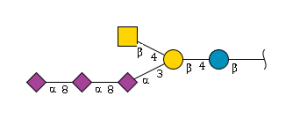
term (main_entry) : GT2
glycan_dictionary_accession : GSD000103
glytoucan_accession : G36476BA
term_in_sentence : Biosynthesis of the c-series gangliosides GT3, GT2 and GP1c was studied in Golgi derived from rat liver.[PMID:[https://pubmed.ncbi.nlm.nih.gov/[https://pubmed.ncbi.nlm.nih.gov/[https://pubmed.ncbi.nlm.nih.gov/[https://pubmed.ncbi.nlm.nih.gov/1606358 1606358 1606358] [https://pubmed.ncbi.nlm.nih.gov/1606358 1606358 1606358]] [https://pubmed.ncbi.nlm.nih.gov/[https://pubmed.ncbi.nlm.nih.gov/1606358 1606358 1606358] [https://pubmed.ncbi.nlm.nih.gov/1606358 1606358 1606358]]] [https://pubmed.ncbi.nlm.nih.gov/[https://pubmed.ncbi.nlm.nih.gov/[https://pubmed.ncbi.nlm.nih.gov/1606358 1606358 1606358] [https://pubmed.ncbi.nlm.nih.gov/1606358 1606358 1606358]] [https://pubmed.ncbi.nlm.nih.gov/[https://pubmed.ncbi.nlm.nih.gov/1606358 1606358 1606358] [https://pubmed.ncbi.nlm.nih.gov/1606358 1606358 1606358]]]]]
publication : [https://pubmed.ncbi.nlm.nih.gov/[https://pubmed.ncbi.nlm.nih.gov/[https://pubmed.ncbi.nlm.nih.gov/[https://pubmed.ncbi.nlm.nih.gov/1606358 1606358 1606358] [https://pubmed.ncbi.nlm.nih.gov/1606358 1606358 1606358]] [https://pubmed.ncbi.nlm.nih.gov/[https://pubmed.ncbi.nlm.nih.gov/1606358 1606358 1606358] [https://pubmed.ncbi.nlm.nih.gov/1606358 1606358 1606358]]] [https://pubmed.ncbi.nlm.nih.gov/[https://pubmed.ncbi.nlm.nih.gov/[https://pubmed.ncbi.nlm.nih.gov/1606358 1606358 1606358] [https://pubmed.ncbi.nlm.nih.gov/1606358 1606358 1606358]] [https://pubmed.ncbi.nlm.nih.gov/[https://pubmed.ncbi.nlm.nih.gov/1606358 1606358 1606358] [https://pubmed.ncbi.nlm.nih.gov/1606358 1606358 1606358]]]]|15498585|16005859|27540730|31533196|31201844
definition : A branched amino hexasaccharide consisting of a chain of three α-sialyl residues, a β-D-galactosyl residue and a β-D-glucose residue linked sequentially (2→8), (2→8), (2→3) and (1→4), to the galactosyl residue of which is also linked (1→4) an N-acetyl-β-D-galactosaminyl residue. The carbohydrate moiety of ganglioside GT2.[CHEBI:72446]
term_xref : GlycoMotif:GGM.000109|GTC:G36476BA|CID:70788971|CHEBI:72446|KEGG:G00119
synonyms :
function :
disease_associations :
wikipedia :
essentials_of_glycobiology : Chapter 11
GT3

term (main_entry) : GT3
glycan_dictionary_accession : GSD000104
glytoucan_accession : G93899SO
term_in_sentence : The purpose of this study was two-fold: (1) to formulate γ-tocotrienol (GT3) in a nanoemulsion formulation as a prophylactic orally administered radioprotective agent; and (2) to optimize the storage conditions to preserve the structural integrity of both the formulation and the compound.[PMID: [https://pubmed.ncbi.nlm.nih.gov/28029115 28029115 28029115]]
publication : [https://pubmed.ncbi.nlm.nih.gov/28029115 28029115 28029115]|31355968|30987413|27869747|27216753|8631981|29672891|10385047|29642403|10412028|27193023|30068561|23415908|8858920|2303428|27153057|27128741|2654294|26930378|7561885|25860286|30845647|24712339|30070965|[https://pubmed.ncbi.nlm.nih.gov/8910600 8910600 8910600]|[https://pubmed.ncbi.nlm.nih.gov/[https://pubmed.ncbi.nlm.nih.gov/[https://pubmed.ncbi.nlm.nih.gov/[https://pubmed.ncbi.nlm.nih.gov/1606358 1606358 1606358] [https://pubmed.ncbi.nlm.nih.gov/1606358 1606358 1606358]] [https://pubmed.ncbi.nlm.nih.gov/[https://pubmed.ncbi.nlm.nih.gov/1606358 1606358 1606358] [https://pubmed.ncbi.nlm.nih.gov/1606358 1606358 1606358]]] [https://pubmed.ncbi.nlm.nih.gov/[https://pubmed.ncbi.nlm.nih.gov/[https://pubmed.ncbi.nlm.nih.gov/1606358 1606358 1606358] [https://pubmed.ncbi.nlm.nih.gov/1606358 1606358 1606358]] [https://pubmed.ncbi.nlm.nih.gov/[https://pubmed.ncbi.nlm.nih.gov/1606358 1606358 1606358] [https://pubmed.ncbi.nlm.nih.gov/1606358 1606358 1606358]]]]|27356050|8514740|18509108|23000517|29769046|29566611
definition : A linear amino pentasaccharide consisting of a chain of three α-sialyl residues, a β-D-galactosyl residue and a β-D-glucose residue linked sequentially (2→8), (2→8), (2→3) and (1→4).[CHEBI:72444]
term_xref : GlycoEpitope:EP0070|KEGG:G00118|CID:70788970|GlycoMotif:GGM.000092|GTC:G93899SO|CHEBI:72444
synonyms :
function :
disease_associations :
wikipedia :
essentials_of_glycobiology : Chapter 11